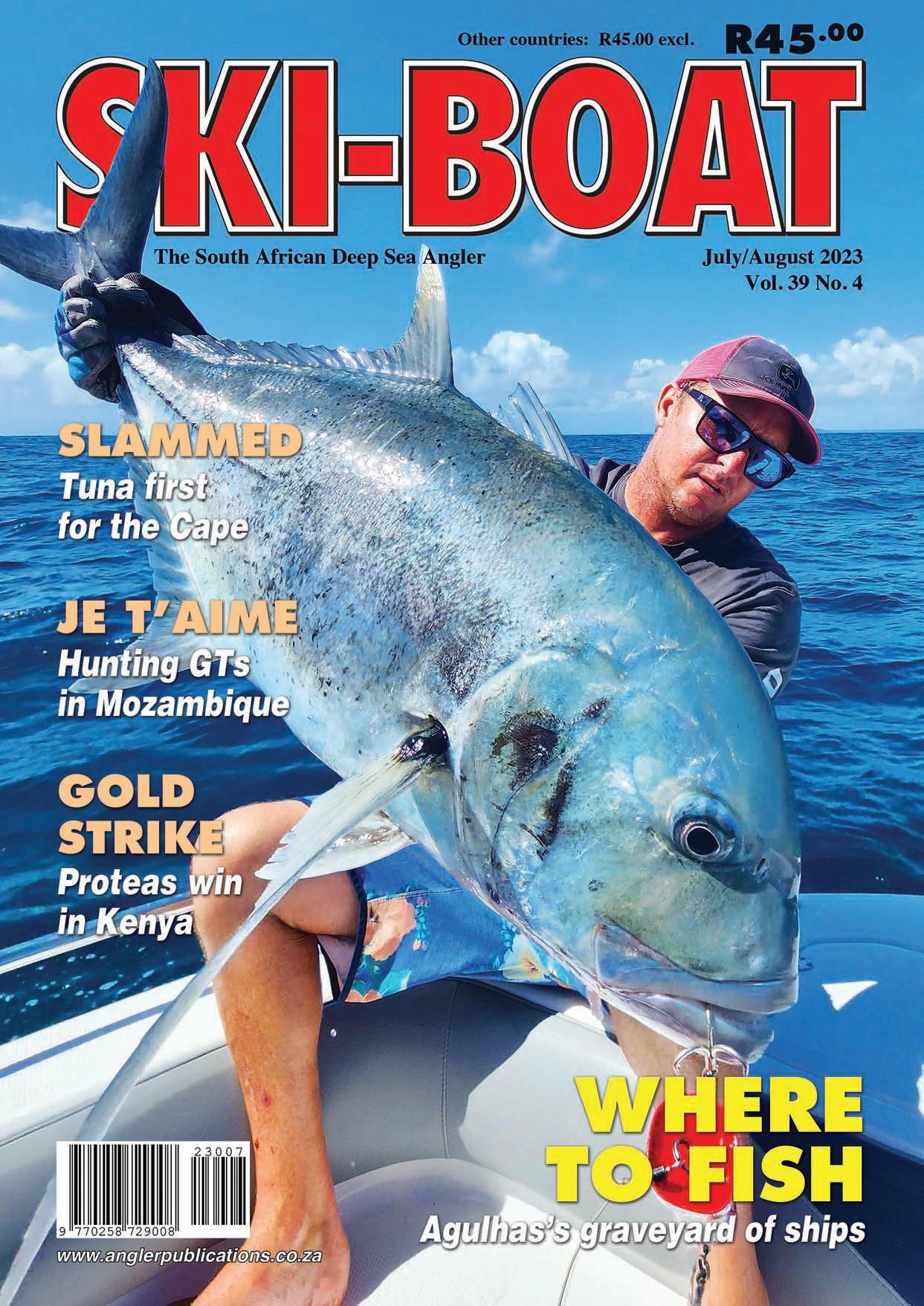
Seacat 565
2 x Yamaha 70hp 4-stroke motors, hydraulic steering, galvanised breakneck trailer.
Forward console: R849 000!
Centre console: R839 000!
Seacat 520

2 x Yamaha 60hp 4-stroke motors, hydraulic steering, galvanised breakneck trailer.
Forward console: R698 000!
Centre console: R678 000!
Seacat 510 Blast


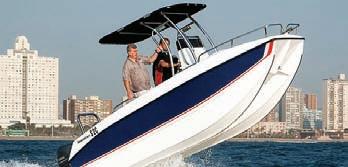
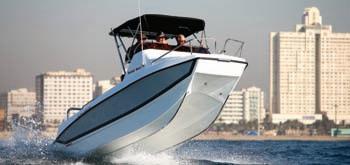
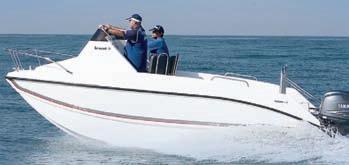
2 x Yamaha 60hp 2-stroke motors, galvanised breakneck trailer.
Forward console: R576 000!
Centre console: R564 000!
CENTRE CONSOLE
2 x Yamaha 70hp 4-stroke motors, hydraulic steering, galvanised breakneck trailer.
R669 000!

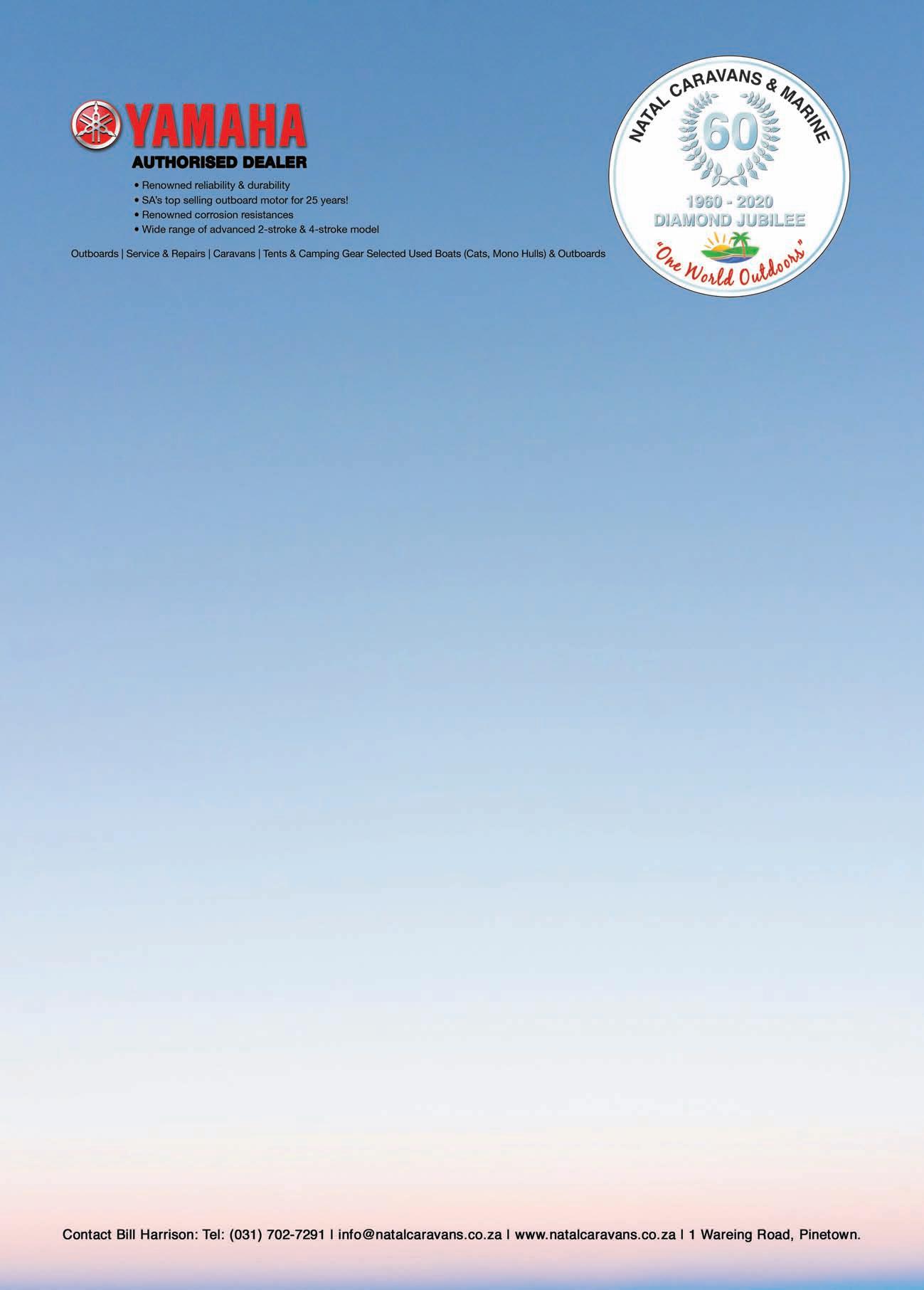
2 x Yamaha 60hp (2-stroke, power trim) motors on a galvanised breakneck trailer, hydraulic steering, plus much more!
Forward console: Now only R579 000!
Centre console: Now only R569 000!
CENTRE CONSOLE
Yamaha 100hp 4-stroke motor, galvanised breakneck trailer.

R486 000!
CENTRE CONSOLE
Yamaha 60hp 4-stroke motor, galvanised breakneck trailer.
R359 000!
Prestige 6m semi-rigid duck
Yamaha 85hp motor (powertrim & tilt). Hydraulic steering. New tubes. Cat-R safety gear. COF with buoyancy certificate. Galvanised trailer with spare wheel and roadworthy.
ONLY: R89 900
Explorer 465 CC
Yamaha F70hp, 4-stroke motor (20 hours). Bal. of warranty till 2024. T-Top. Hydraulic steering. Lowrance Hook 7 GPS/fishfinder & VHF radio. Live well (pump/plumbing). Deck wash, rod holders & bait boards. Full Cat-D safety. Front casting deck with removable cushions. Boat & motor covers. Roadworthy galv. breakneck trailer, rims & spare.
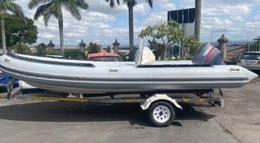
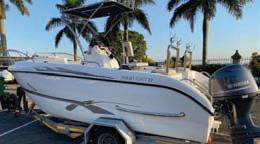
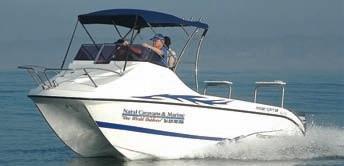
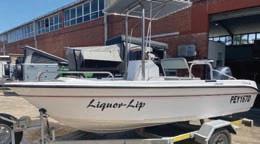
ONLY: R399 000
Explorer 465 CC
Only one owner. Yamaha 70hp motor with powertrim & tilt/autolube, 125 hours. 1 year motor warranty. Beach Kit. Lowrance Hook 5 GPS/fishfinder. Full set Cat-E safety gear. Live well with pump/plumbing. Boat cover & sun canopy. Scotty rod holders. Full stainless steel kit. Galvanised breakneck trailer. Electric winch. Spare wheel & roadworthy. ONLY: R219 000 (REDUCED)
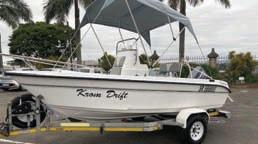
finance available nationwide delivery
Kosi Cat 17 CC
Only one owner. 2 x Yamaha F70hp motors (188 hours) with 1 year warranties. Hydraulic steering, T-Top, Lowrance Hook 7 GPS/ Fishfinder & VHF radio. Full safety gear & nav lights. Live well with pump/plumbing. Sound system. Boat cover. Push plate. Galvanised breakneck trailer, axle & rims with push pole. Roadworthy.
ONLY: R479 900
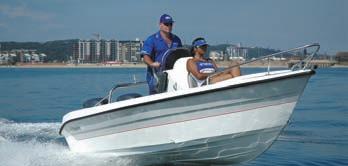
Pre-owned Pre-owned Pre-owned
Explorer Kosi Cat 17 Evo 19 565 510 (Gen 3) 520 465 510 Blast
looked so good!
Pre-owned
Seacat
pre-owned never
2021 2019
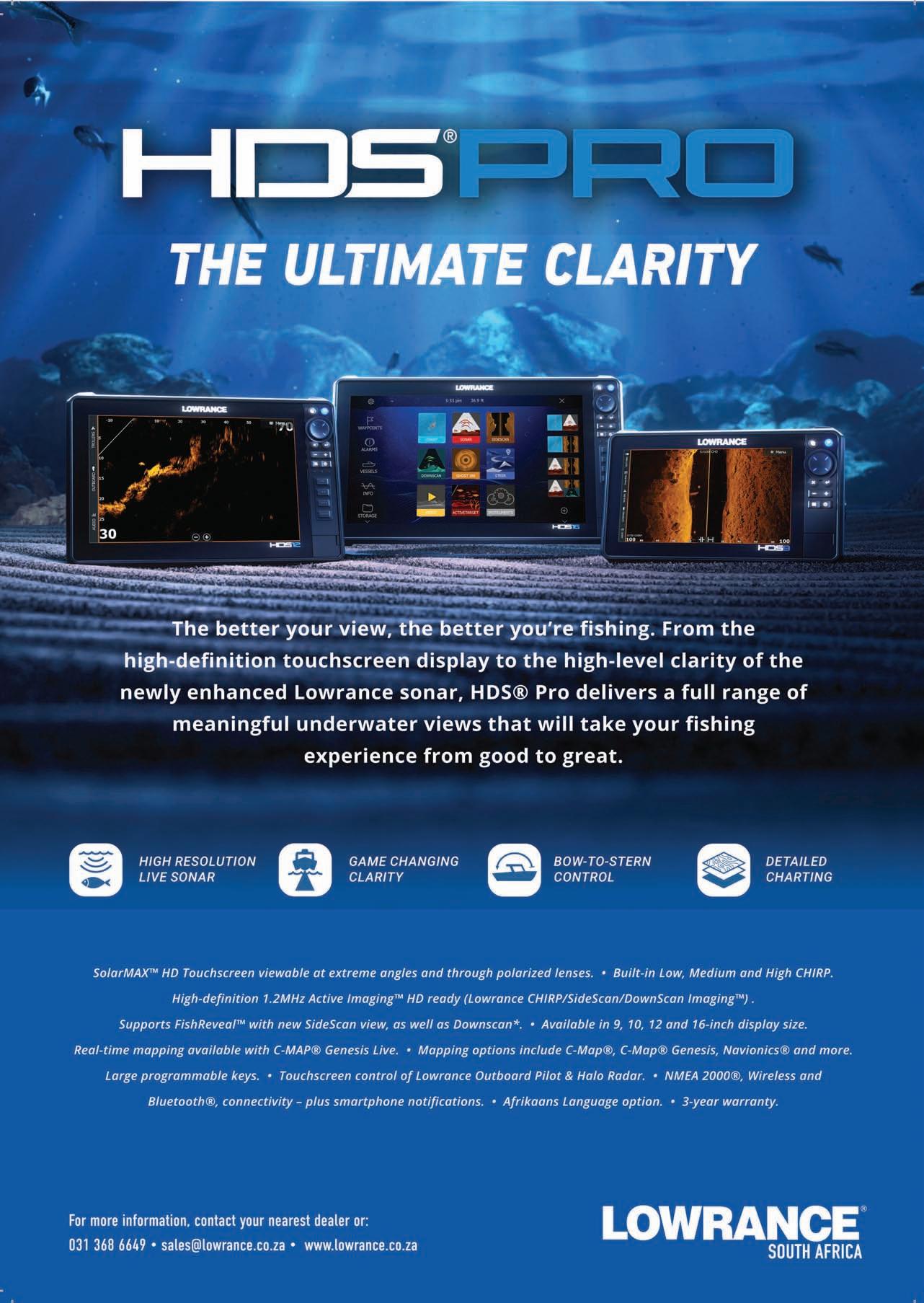

CONTENTS
July/August 2023 Volume 39 Number 4
COVER:KINGOFTHEMALL
The great love of many anglers’lives — a giant kingfish aka giant trevally caught off Mozambique.Photo supplied by Mark de la Hey.See pg 35

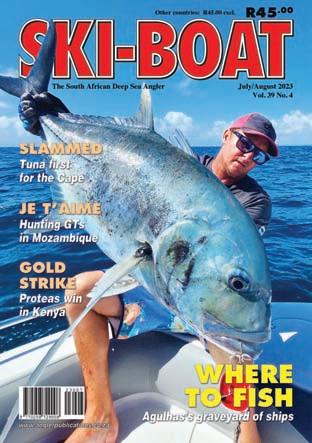
FEATURES
7Kwa Heri,Annie Bursik
Farewell to a woman in a million
9Where to Fish
Part 10:Exploring Agulhas’s graveyard of ships — by Johan Smal
21All in a Day’s Work
Cape Town’s first tuna grandslam — by Ryan Nienaber

26Reach for the Sun
2023 Durban Ski-Boat Club Festival —by Linden Naidoo and Hilton Kidger
35Je t’aime
Hunting GTs in Moz —by Mark de la Hey
45Keeping Your Vessel Shipshape
Part 2:Quarterly maintenance tips — by Craig Stubbs
49Proteas Strike Gold in Kenya
Fishing the South Coast Blue Marlin Open — Mariettë Hendriksz and Gavin van der Merwe
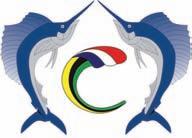
57Citizen Science at its Best
Impact of the ORI Fish Tagging Project — by Gareth Jordaan and Bruce Mann
DEPARTMENTS
4Editorial — by Erwin Bursik
40SADSAA News
43Kingfisher Awards
55Subscribe and win
56Bell Reel Kids
61Mercury Junior Anglers
62Newsflash
62Ad Index
63Business Classifieds & Directory
64Rapala Lip — Last Word from the Ladies
FINDUSFORFREEONWWW.ISSUU.COM
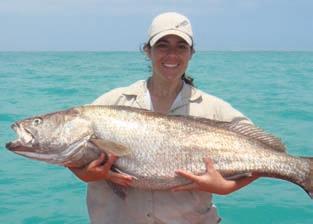
DOYOUPREFERANEZINE?
The official magazine of the South African Deep Sea Angling Association 5 5 7 7 9 9 2 2 1 1
Publisher: Erwin Bursik
Editor: Sheena Carnie
Advertising Executive: Mark Wilson
Editorial Assistant: Lynette Oakley
Contributors: Erwin Bursik, Mark de la Hey, Mariette Hendriksz, Gareth Jordaan, Hilton Kidger, Bruce Mann, Linden Naidoo, Ryan Nienaber, Johan Smal, Craig Stubbs, Gavin van der Merwe.
ADVERTISING – National Sales:
Mark Wilson, Manager — 073 748 6107 Lyn Oakley, Sales — 082 907 7733
ADVERTISING – Gauteng & Mpumalanga: Lyn Adams — 083 588 0217
Publishers:
Angler Publications cc
POBox 20545, Durban North 4016
Telephone: (031) 572-2289
e-mail: angler@mags.co.za
Subscriptions to SKI-BOAT: R220 per annum (six issues).

New subscriptions and renewals: SKI-BOAT Subscriptions Department
Telephone: (031) 572-2289
• e-mail: angler@mags.co.za
• Through www.anglerpublications.co.za, or E-zine through <www.issuu.com>
Printing: Novus Print, Cape Town
Distribution: On The Dot <Riaan.Weyers@onthedot.co.za>
Full production is done in-house by Angler Publications & Promotions on Apple Macintosh software and hardware.
SKI-BOAT Magazine, ISSN 0258-7297, is published six times a year by Angler Publications & Promotions cc, Reg. No. CK 88/05863/23, and is distributed by On the Dot, as well as directly by the publishers to retail stores throughout South Africa.
• Copyright of all material is expressly reserved and nothing may be reproduced in part or whole without the permission of the publishers.
• While every effort is made to ensure the accuracy of the contents of this magazine, the publishers do not accept responsibility for omissions or errors or their consequences.
Views expressed in this magazine are not necessarily those of the publishers, the managing editor, editor, editorial staff or the South African Deep Sea Angling Association.
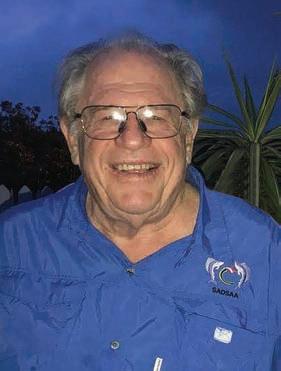
WHAT’SGOOD FORTHEGOOSE SHOULDBEGOOD FORTHEGANDER
DRAWN to exposure on anything “fishy”, I was recently caught in the digital web of YouTube and its system of loading similar videos to one I’d arbitrarily watched. In this case the subject matter was commercial offshore trawling by some of the largest factory stern trawlers in existence these days.
The first to tweak my interest was the newest and largest of these trawlers that not only trawls mega loads of fish, but also processes them onboard into frozen fillets and tinned fish in a highly sophisticated onboard factory.
My accounting mind added up the cost of the 144m-long vessel, it’s computerised trawl nets, the men that operate the fishing side of things, the number of factory staff, its 3000 tons of fuel and the massive total investment needed to produce a dividend for those who invested in the undertaking.
On the income side, she can process 350 tons of fish a day and can store 7000 tons of graded, frozen and canned fish before returning to port to offload, and then sailing off again to repeat the exercise.
“So what is the point of this editorial?” you may well ask.
What’s getting up my nose is the inequality at play when this is going on out in the deep, but we, the recreational offshore anglers, are accused of raping the ocean and are restricted to catching very few fish a day. Then of course there are all the MPAs that further restrict the areas we can fish in, and inhibit our chances of even catching our bag limit.
It makes me wonder where conservation begins and ends and highlights again that it’s always the soft targets that are focused on. It’s easier (and more politically correct) to crack down on the recreational fishermen who don’t kick up too much fuss, than it is to crack down on other bigger and potentially more powerful groups.
Watching these huge nets full of fish being boated, even supposedly way offshore, sickened me and forced me to reevaluate my personal thinking regarding conservation and the release of recreationally caught pelagic gamefish. This just gives credence to the views of those in our fraternity who have long wondered why they should release the fish they catch when they’re just going to be caught by the longliners and trawlers.
The saying that has been adopted by most recreational anglers — “Limit your catch, don’t catch your limit” — and to which I prescribe, now conjurs up more questions than answers in my mind.
Tight lines
Erwin Bursik
4 • SKI-BOAT July/August 2023
EDITORIAL
Erwin Bursik Publisher
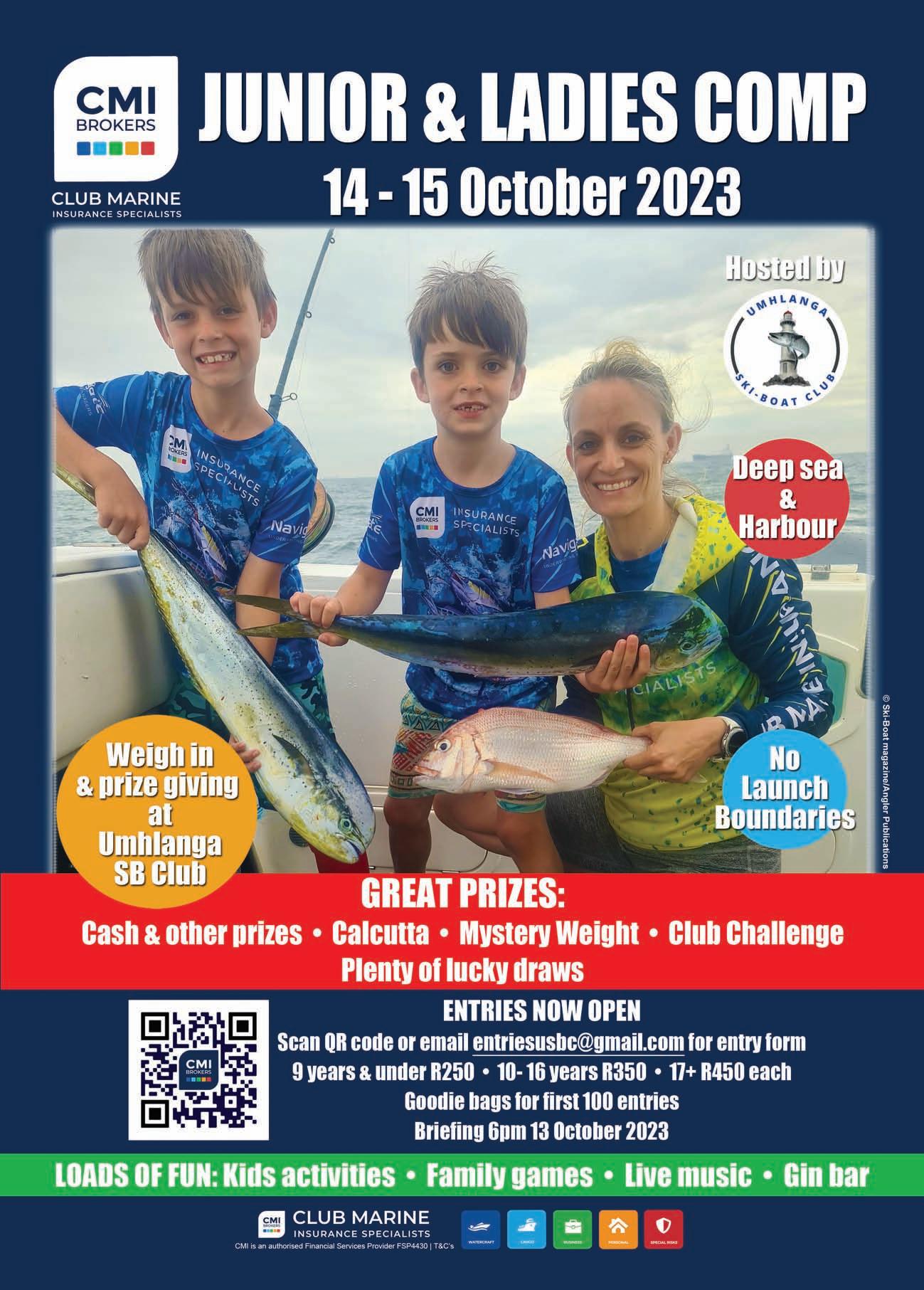
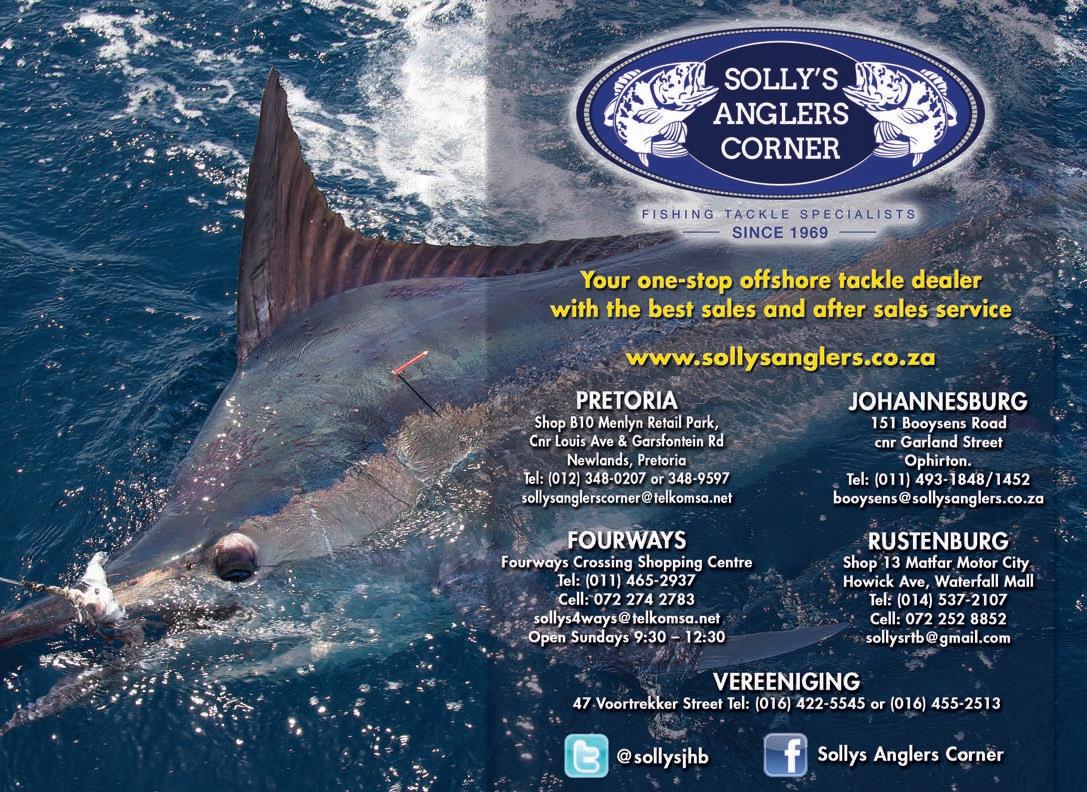
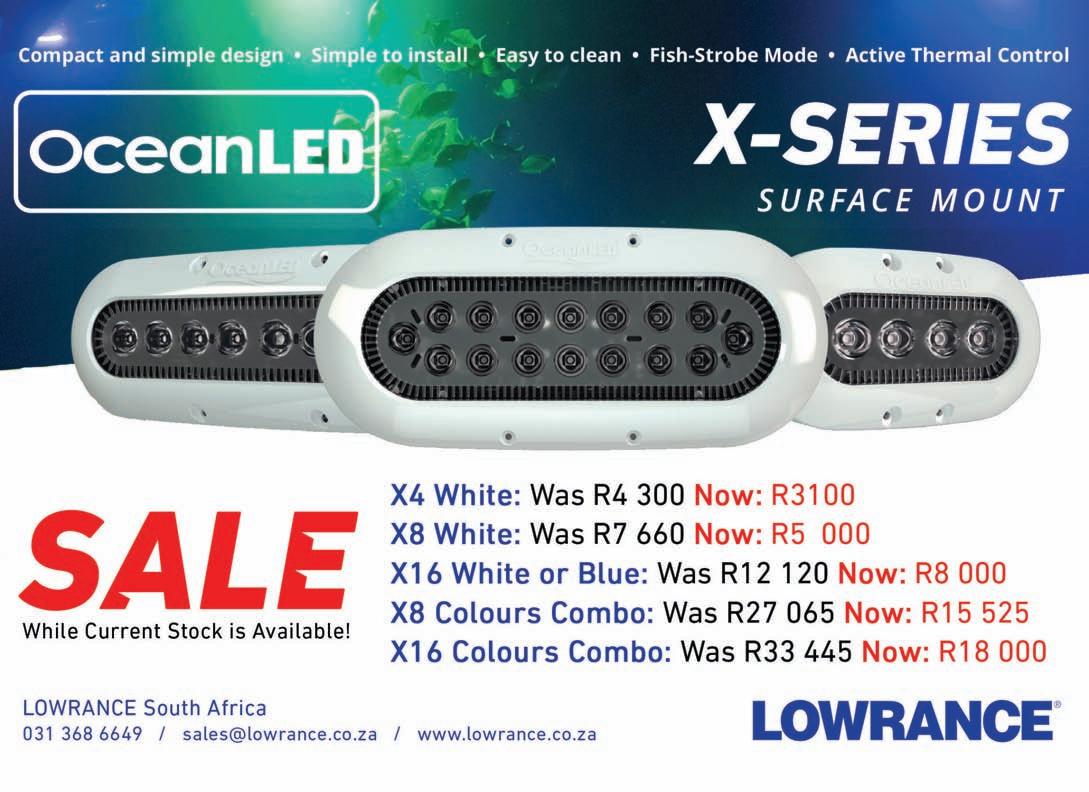
6 • SKI-BOAT July/August 2023
20/12/1942 - 30/4/2023
IT is with great sadness that we at Angler Publications pay homage to Anne Bursik who recently lost her tenacious fight against the vile and cursed cancer that dulled her vibrant personality during the final months of her life.
Annie,Dave Rorke and Doug Steele banded together in early 1985 to establish SKI-BOAT magazine.It was a mighty step into an adventurous scenario that many thought would end in disaster.More than 38 years later, SKI-BOAT magazine is stll flying high,even though the original partners have now all left us.Their legacy is a continual reminder that their dearest goal has been achieved.
Annie left her cozy position in the corporate world and,used her administrative expertise as well as her accumulated funds to kickstart Angler Publications.For the next 30 years she undertook the administrative function of the closed corporation until her retirement in 2017.
Annie was much loved by both Dave and Doug,and the other staff who joined Angler Publications over the years,but most of all by her husband,Erwin, who joined SKI-BOAT in 1987.
The greatest feather in her administrative cap was the Captain Morgan Grand Challenge which she virtually ran.The annual event initially took place in Mauritius before moving to Hemingways at Watamu,Kenya,and groups varied in size from 46 to 82 competitors.
Tannie Annie,as many called her,captivated them all with her beautiful smile.Even though she was not an ardent angler herself,she managed to marshall the troops into participating in numerous fun-loving adventures with minimal problems.
Annie only went to sea on the odd occasion and landed a couple of sailfish,tuna and other gamefish over the years,but in general she preferred to supervise and offer support from the beach.

Erwin and Annie had incredible opportunities to travel in the name of offshore angling and visited numerous destinations associated with sportfishing.These were primarily along the African coastline from Angola in the west around to the North Kenyan coast at Lamu,as well as numerous Indian Ocean Islands.
At the end of each adventure she would use her hobby of scrapbooking to create wonderful memory-provoking accounts which she,Erwin and their family loved looking though will treasure for many years to come.
Annie will be remembered by many offshore anglers here in South Africa as the incredibly beautiful woman with a sunny personality who stood by her husband’s side during his involvement in offshore angling and sports administration for close on 40 years,and who won the friendship of so many in our angling com-

Annie was a rock for Erwin,their four daughters and their extended family; indeed,the very core of their family.She will be remembered not only for her looks and personality,but also her exceptional culinary skills which she loved to put to good use entertaining family, friends and business acquaintances at her home in Durban North.
We bid Annie farewell and eternal rest;she will not be forgotten.
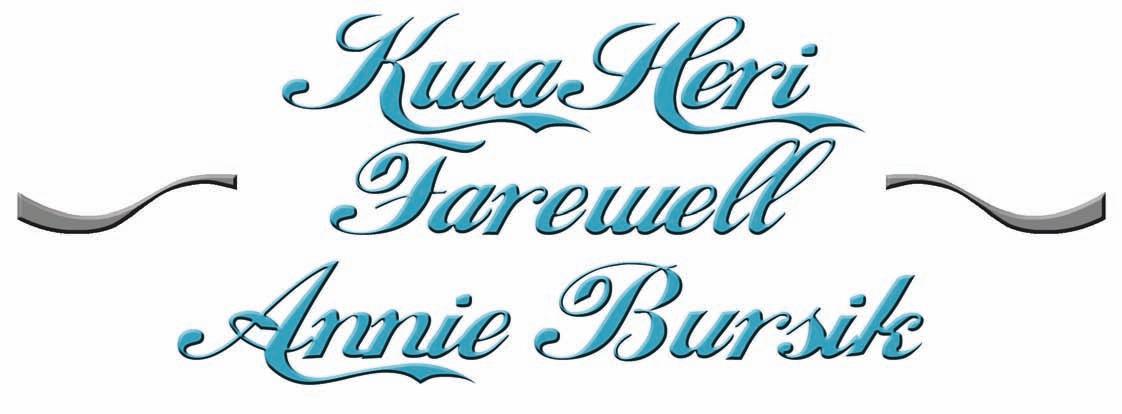
SKI-BOAT July/August 2023 • 7
PEOPLE

Part 10:Exploring Agulhas’s graveyard of ships
By Johan Smal
THE southern part of the meridian 20°east of Greenwich,stretching from Antarctica to the southernmost point of the African continent,makes landfall at the little town called Agulhas.Renowned for separating the great Atlantic from the Indian Ocean,this famous line of longitude cuts neatly through the heart of the notorious “Graveyard of Ships”,the fishing theatre we focus on in this article.
The seas that pound our shores,although enchanting,are some of the most treacherous in the world.Legendary for its sudden weather changes with galeforce winds whipping up the seas, this area sees massive,fast-moving swells exceeding 10 metres.The 130-odd shipwrecks which lie scattered along the coastline,bear testimony to this phenomenon.
And yet,these treacherous and captivating waters also provide recreation,adventure and sustenance for thousands.Famous for its annual bumper yields of yellowtail in particular,the area’s rich marine life and breathtaking sea-
and landscape scenery,is appropriately considered as a place of plenty.
The continual mixing of the icy north-flowing Benguela current up the west coast and the warm south-flowing Agulhas current hugging the east coast,generates one of the five richest marine ecosystems in the world.This Agulhas area has been synonymous with fishing for millennia,and Arniston (also named Waenhuiskrans in Afrikaans) and Struisbaai,with its quaint little harbour,are two of a few remaining line-fishing communities along the Cape’s east coast.
From September to April,the mighty Agulhas current sweeps across the Agulhas Banks,swathing very large inshore areas with generous plankton- and baitfish-rich warm eddies.The abundance of fish species caught in the area, especially at this time,fuels the zest of fishermen even from afar.
For this article in the popular Where to Fish series,our focus area stretches from Die Dam near Quoin Point in the west,up to Cape Infanta,located at the mouth



SKI-BOAT July/August 2023 • 9 TACTICS
Traill Whitthun with a 25kg yellowtail.
of the Breede River some 125km east along the coast.Die Dam is where Rob Naysmith finally cut his line in Part4 of this seies,“Exploring the Overberg”,in the January/February 2022 issue of SKI-BOAT.
LAUNCHING AND TRAILERING FACILITIES
Due to the rocky nature of the coastline,there are only two official launching facilities serving this huge fishing area.If you want to fish both the Atlantic and Indian oceans in one day,then you launch from Struisbaai harbour.

This is the home of the Suidpunt Deep Sea Angling Club that stages the popular Two Oceans Marlin Tournament and Yellowtail Bonanza.(For further details please contact the club manageress,Marinda de Kock on 0761913744 or 2017sphk@gmail.com.)
Struisbaai is the only conventional breakwater launching and trailering facility,and over 95% of all boat anglers fishing this huge Agulhas area launch there.


Built in 1986 though,it was not designed to cope with as many boats in a short space of time as is experienced nowadays.On busy holidays,when over 150 craft could make use of the facility on fishable days for example,some serious logjams are caused with boats queuing far back into town.The
harbour also sometimes sands up,resulting in very low water levels being encountered around the slipways during spring low tide.A three or four hour no-go safe window is usually then observed to avoid boats getting stuck on the sandbar which would cause damage to drive mechanisms,especially on the bigger craft.
Renowned for breaking heavily at times,another risk is the very shallow bank called Borrelgat located to the port side immediately as you leave the harbour.During heavy breaking waves skippers must also take note of the risks associated with the remaining engine block of the Oriental Pioneer (S34 48783 E20 05295) located off Northumberland Point.The Chinese ore carrier ran aground in July 1974,and the engine block still sticks out at spring low tide.
Launching from the Arniston harbour also needs sober, clearheaded and well-prepared skippers and crews.Running your precious ski-boat down this unique,7°angle concrete slipway on special wheel modifications,directly into the oncoming surf,makes for exceptional challenges and exciting launches.
Deprived of the normal thrust at your disposal due to disproportionately trimmed engines to prevent prop and drive gear damage,and even further disadvantaged by the excessive
Arniston harbour during spring low tide, and inset a textbook launch the Arniston way. With the boat parked at a 90°angle on the slipway and ready to launch, the engines are run to the safe operational temperature. The nose is pulled towards the water allowing the craft to run down the slipway under its own weight, diagonally towards the surf some 10 metres away, with the crew only maintaining the balance and line of approach. As it hits the water the crew members on the sides jump over the gunnels and as it starts to float, the two “pushers” at the back jump over the transom on either side of the running engines ... and off you go!
10 • SKI-BOAT July/August 2023
Struisbaai harbour during spring low tides.
drag created by the detachable wheels fitted on the sides of the boat,one must negotiate the surf at greatly reduced speeds.
With very little margin for error and no opportunity to turn away from oncoming waves or run to protected areas, the skipper’s timing must be impeccable.This is especially crucial during low tides when he must also negotiate the narrow six-metre wide gap between protruding rocks,which is the only passage out to sea.Fortunately,after unclipping and stowing the wheels,the last 80 metres of incoming surf can be faced at full thrust if necessary.
THE FISHING THEATRE
Situated entirely on top of the Agulhas Continental Shelf, although annoying to mariners around the globe due to its treacherous nature,the area offers relatively shallow fishing grounds.Referred to as some of the best fishing waters in South Africa,copious quantities of a large variety of both bank- and gamefish species are lifted from these productive waters each year.
The area is broadly shaped like a skewed,upside-down triangle.Sited on the western extreme,we have the Brandvlei area that is popular for kob.To the south-east of that you find the Agulhas 6-Mile Bank (also called Blougansie) which is located 13km diagonally offshore and produces good yellowtail and geelbek at times.
On its seaboard side,located 28km from the Struisbaai harbour and essentially signifying the outer range for Category C craft,is the famous Agulhas 12-Mile Bank.Having to negotiate the busy shipping lane that runs around Africa means that sometimes numerous huge cargo ships will cross your path, but it’s worth it,just go carefully.This bank boasts two very productive 30m deep pinnacles,producing vast yellowtail catches at times.
During high summer months the areas along the 100m contour line stretching further beyond the bank,is a very popular choice for tuna,marlin,and other gamefish species.
If you head straight into the rising sun some 6km out of the Struisbaai harbour,you’ll find the Struisbaai Vlakbank,the most popular structure where mainly yellowtail are targeted. Due to the strong flowing current,anchoring is seldom possible and catches are taken either on the troll or drift.
Many years ago this bank was known as the seventy-four bank and yielded hundreds of tons of this fine table fare. Although seventy-four numbers have recovered remarkably further up the coast,only a few small fish have lately been reported hooked and safely released since they were fished out in the area around the mid-1950s.
Also referred to as the Bulldog,the treacherous Saxon Reef is located further up the coast at Struispunt,only 3km west of Arniston.It is a shallow structure that runs diagonally seawards from shore and is demarcated by a 13m high solid stone beacon erected in the intertidal zone many moons ago.
Anglers pulling trolling baits parallel to the reef and as close as possible to the structure can catch giant yellowtail and yellowfin tunny within 100 metres of the shore.Several of these trophy yellowtail specimens have brought their catchers the first prize spoils of the annual Suidpunt Yellowtail Bonanza.However,this fishing spot is jealously guarded by razor-sharp rocks cunningly concealed underneath the serene beauty of the surrounding waters,so skippers must take the utmost care and maintain vigilance while working this area.
At the top end of the “triangle”in the eastern corner near Cape Infanta,there are also some popular fishing spots.These are fished by boats which launch in the Breede River from Witsand and then work their way down in a south-westerly direction.
The popular Skipskop bank area located some 24km from Arniston,often yields good catches of various species,especially yellowtail,geelbek and santer.When good catches are reported in this area,it is not uncommon to experience a real traffic rush with many Struisbaai boats also joining in to get
BAIT SPECIES
The following bait species are found in the area.
Steentjie: Found everywhere and the most abundant and popular seabream species use for bait — live or filleted. Horse mackerel (maasbankers) and Atlantic mackerel: Semi-pelagic fish found throughout the water column. Chokka (Cape Hope squid): Can be caught at Goudmyn near the Struisbaai Vlakbank.

Octopus: Found throughout the area on all reefs below the water surface and regularly hooked while bottomfishing.
LARGE BAITS
Kabeljou, geelbek and red steenbras have large mouths and prefer large baits. This photo shows 8/0 hooks loaded with the three large baits we often use.
Left: Whole sardine which is not very effective with a shoal of steentjies hanging around under the boat as these nibblers decimate soft baits in no time.
Centre: A whole live steentjie (with the tailfins trimmed slightly to curtail swimming efficiency) works well when there are lots of steentjies around — if the odd shark does not get hold of it first.
Right: As it is more hardy than sardines, a butterfly’ed steentjie works very well as the steentjies take some time to destroy this bait completely.
CUT BAITS
These are the most popular baits used. This photo shows two different options — half a sardine combined with a steentjie fillet, and another option where a piece of octopus leg (or chokka) is added. This is my preferred bait and works best as steentjies tend to go for the sardine portion first, which augments the chumming process and provides an opportunity for the targeted species to get to the rest.

SKI-BOAT July/August 2023 • 11
A typical mixed bag of different targeted and bycatch species caught by Johannes Uys and his crew at the Skipskop

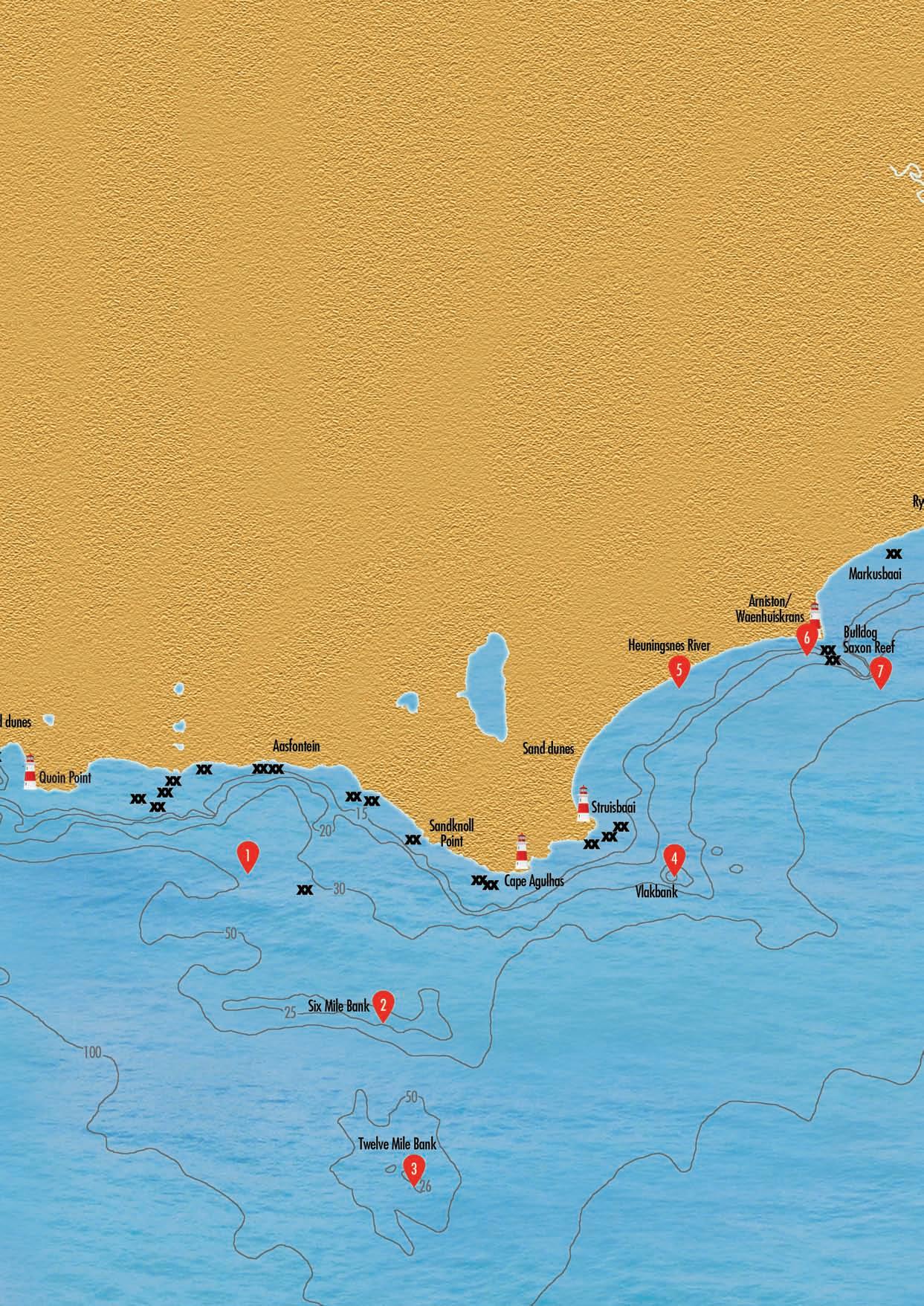
AGULHAS
OCEANNOAREA COORDINATES Atlantic1Brandfontein S 34 49 31E 19 52 22 2Agulhas 6 Mile bankS 34 55 46 E 19 56 53 3Agulhas 12 Mile bankS 35 01 40 E 19 55 31 Indian4Struisbaai vlakbankS 34 50 43E 20 08 08 5De Mond S 34 44 61E 20 06 02 6Oubrand S 34 42 11E 20 13 32 7Saxon reef S 34 42 28E 20 15 4 8Klippe S 34 42 70E 20 21 71 9Straights S 34 41 21E 20 21 68 10Miles Barton reefS 34 38 95E 20 21 80 11Volieklip S 34 38 50E 20 24 07 12Die Hel S34 38 18E20 29 09 13Skipskop bankS 34 37 28E 20 27 04 14Infanta 6 Mile bankS 34 33 65E 20 43 78 15Groot SandkopS 34 51 20E 20 06 47 16Halfway house S 34 59 61 E 20 28 47 17Alphard banks S 35 02 34E 20 51 75 De Hoop MPA S 34 27 130E 20 52 250 S 34 28 378E 20 55 653 S 34 30 378E 20 53 904 S 34 10 295E 20 51 277 S 34 31 880E 20 48 865 S 34 30 416E 20 45 593 S 34 29 950E 20 41 128 S 34 30 438E 20 34 900 S 34 32 329E 20 29 699 S 34 37 600E 20 23 757 S 34 34 940E 20 21 890
FISHING AREAS
bank.


some of the bounty on offer.
This area is located near the world famous De Hoop Nature Reserve,legendary for its countless whale sightings and considered one of the most diverse floral habitats on this planet in terms of the biota.The reserve’s offshore extension, the De Hoop Marine Protected Area (MPA),is zoned as a restricted no-take area.Conserving a vast and fascinating variety of marine life,this World Heritage Site is one of the largest marine protected areas in Africa.
At the bottom,southernmost point of our triangular area, essentially the outer limits for Category B craft and located 65km south from Cape Infanta and 75km from Struisbaai harbour,you’ll find our own unique underwater archipelago — the Alphard Bank.Because it’s so shallow,this area has been defined as a Traffic Separation Scheme,as ruled by the International Maritime Organization.
Due to its distance from shore and because adverse weather conditions sometimes curtail the approachability,it remains the most unspoiled and fish-rich angling destination in the Agulhas theatre.Rising to depths of between 48- and 15m, some 20 apexes above the 50m contour of the underwater islands offer excellent trolling,jigging and soak-baiting opportunities for intrepid anglers.Even Cape snoek are taken here on jigs at 60m depths.
TARGETING AGULHAS SPECIES
Other articles in this series have comprehensively covered all the basics required to fish off the South African coast,including general tackle and boating requirements,so I’m not going to go over those.Instead,I’ve opted to share our general local practices when launching for a day out on the deep blue.
Obviously planning should begin with assessing reports of recent catches so you can determine what species to target, the route to take (noting the most important marks) and where to commence the first lines-down.Based on species abundance,availability,endangered status and habitat,I’ve also loosely classified the day’s intended proceeds in logical groupings,categorised under two main headings:Reef Species and Gamefish Species.These are further subdivided into species specifically targeted and bycatch.
Although there are substantially more species found in the Agulhas areas,I’ve focused on the most important targeted and bycatch ones.
During summer months the Agulhas hallmark,yellowtail,is always on top of the list for the day’s pickings.If they’re not available,kabeljou,geelbek,red steenbras and red stumpnose (in order of priority) tend to be the targeted fallback species. The remaining reef species,essentially caught among the targeted species and usually not purposely targeted for the day, are classified as bycatches.
Having searched for the abovementioned target species for some hours without any reward,the crew might well be treated to a last-chance decision by an emptyhanded skipper to stop over a known spot on the way back home.These are the points that tend to yield more bycatches than targeted species.
TARGETED REEF SPECIES CAPE YELLOWTAIL
A highly nomadic species that aggregates and moves between offshore reefs.
Main areas: 2,3,4,13,16 and 17.
Time of year: Habitually,from September or October with huge shoals of small (2-3kg) fish massing in the area,but reluctant to go on the bite.Catches slowly improve exponentially with bigger fish (2-6kg) taken until about December.Bumper catches of shoaled fish up to 14kg are then sporadically taken for some months.A limited number of loners up to 25kg are also taken.Numbers start to dwindle again towards the end of April when catches become much scarcer.Their most productive feeding times are usually early morning and late afternoon.
On the troll: If they are not feeding on or near the surface,try hard diving lures such as Rapalas in a mixture of sizes and colours.When the ’tail are feeding on the surface,switch to skirted lures and spinners in a mixture of sizes and colours.
Drifting or on anchor: Jigs of various sizes and colours can be used.If you opt for bait,the best is fresh pilchard or pike, sandwiched with a piece of octopus or squid.When the ’tail are in an eating frenzy,they’ll take anything you throw at them.
Water temperature: Over 16°C
Size: 2 to 25kg,with the bulk of catches during high season being 4- to 13kg fish.
(Interesting to note that juvenile amberjack have also been

14 • SKI-BOAT July/August 2023
Ilana Smal advertising her bragging rights with a 22kg kob caught near Arniston.
caught on both the Agulhas 12-Mile and Skipskop banks,with a tropical yellowtail caught from a boat anchored in the Struisbaai harbour during a marlin competition.)
KABELJOU/KOB
Both species are very mobile.Silver kob are mostly found on moderate and low-profile reefs in 20-120m depths,with dusky kob predominantly found in the near-shore marine environment,river mouths and estuaries.Based on the numbers taken lately,both these species are under serious pressure.
Main areas: 1,4,area 5 to 6,8,11,13,14,15 and 16
Time of year: Mostly December to June.Usually found in shoals,but individual fish are often taken amongst other species,especially geelbek shoals.
Drifting or on anchor: Use the large baits or cut baits shown.
Water temperature: Over 18°C
Size: up to 45kg
GEELBEK
A shoaling species found over sandy and shallow rocky substrata to depths of 150m throughout their distribution.
Main areas: 2,3,4,11,12,13,14,16 and 17.
Time of year: Mostly Nov to Apr.The geelbek is a nocturnal feeder and normally caught at night,but for daytime fishermen the best time to catch them is during morning twilight.Experience has shown that the moment the sun appears on the horizon they go off the bite ...meaning that if one of the crew members “oversleeps”and launching is delayed,the whole crew might have to do without that so wanted geelbek for dinner.
Drifting or on anchor: Use the large baits or cut baits shown.
Water temperature: Over 18°C
Size: Up to 12 kg.
RED STEENBRAS
These coppery-red fish with large canine-teeth are the largest of the seabream family and feed mainly on reef fish.The older males become more yellow in colour with black markings on the head and back.
Main areas: 3,4,9,10,11,13,14,15,16 and 17.
Time of year: They tend to remain in deep water during the winter months,but are caught on reefs closer to shore mainly from September to June.
Drifting or on anchor: Use the large baits or cut baits shown. For this species the best bait is a live steentjie or one with the backbone removed and the “calling flaps”swaying enticingly in the current.”
Water temperature: Over 14°C
Size: Mostly young fish from 3- to 10kg but can be up to 57kg like one specimen that was caught on the Agulhas 12 Mile Bank.
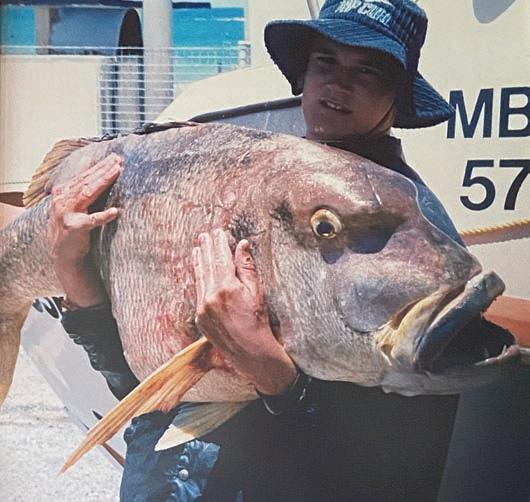
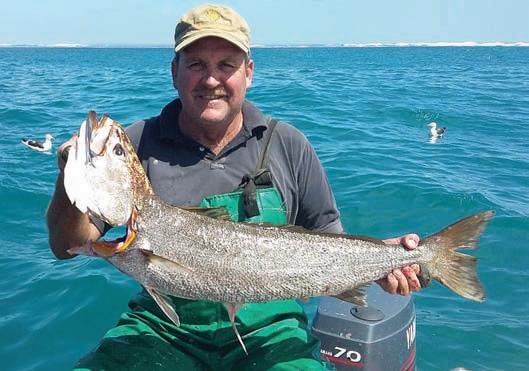
RED STUMPNOSE
A highly resident species found on offshore reefs to depths of 150m,red stumpnose have partially lost their localised migratory patterns due to severe population depletion.
Main areas: Found on all reef structures,but as they are seriously under pressure please think long and hard before removing them.
Time of year: More abundant from August to May,but they are also caught during the winter months.
Drifting or on anchor: Use the cut baits I’ve detailed.Red stumpnose are not very fussy,but a longish piece of octopus leg usually does the trick,nicely and quickly.
Water temperature: Over 14°C
Size: Up to 5kg.
REEF SPECIES BYCATCH
RED ROMAN
Highly resident species with a small home range,less than 100m in linear extent.Of all the bycatch species it is the most prolific,being found on all reefs and caught all year round. Mostly juveniles have been caught lately,and this is yet another species under pressure.
SANTER
This is my favourite table fare.A nomadic species,santer move up to 10km between structures,with local movements into shallow waters following cold water upwelling events.They are caught on most reef complexes during the summer months.Some 5kg specimens have been caught,but catches are also dwindling notably lately.
CARPENTERS
This is a shoaling species with adult fish mostly found in further offshore water columns just above high-profile reefs from 50-200m.Juveniles are found on shallower reefs 10-40m with individuals usually caught among other species on all reef structures.
BLACK MUSSELCRACKER
Adults are found on high-profile inshore and offshore reefs down to 100m,with juveniles found in the rocky surf-zone and shallow subtidal reefs.Catches are also dwindling.
YELLOWBELLY ROCKCOD
Catches in this area are mainly juveniles which are found on most rocky reefs from the surf zone down to 200m.
SKI-BOAT July/August 2023 • 15
Johannnes Uys with a sizeable geelbek caught at Volieklip, cleverly dispatched immediately and bled at sea to preserve the fresh taste.
Ruan Smal with his 43kg red steenbras caught in the Straights area some years ago.
LEERVIS
This is not a bycatch species nor specifically targeted regularly,but adults up to around 25kg are found all along the Agulhas nearshore surface waters during the summer months.
Popping or spin-fishing whilst casting into the surf zone from a stationary boat, or trolling lures,spinners or live-bait near the surf zone are the only ways to reach them from a craft,but unfortunately have not proven to be very effective.Leervis are usually caught while feeding on shoals of spawning elf close to shore during December and January,using a live elf as bait.
TARGETED GAMEFISH SPECIES MARLIN

It’s mostly black- and striped marlin that are caught in this area,but blue marlin and the odd white marlin,as well as the odd sailfish,have been caught in the Agulhas 12-Mile bank (especially along the 100m contour),Struisbaai Vlakbank,Skipskop Bank and Alphard Bank areas.These are caught during the high summer months of January and February,using both lures and livebait,of which a yellowtail,if available,yields very good results.
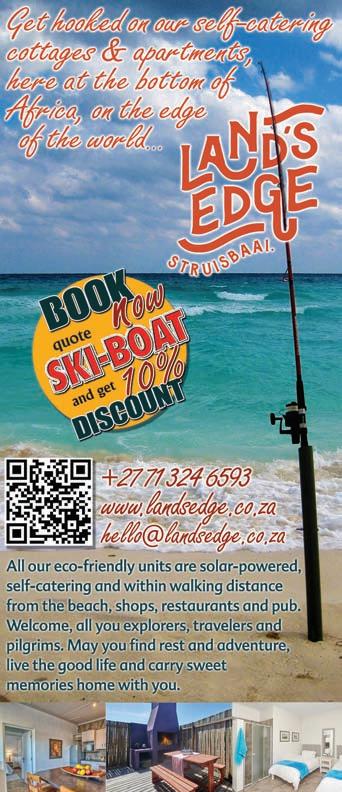
TUNASPECIES
Yellowfin tuna,skipjack tuna and Atlantic bonito (katonkel) are regularly caught in the Agulhas area from December to March.Use a mixture of lures,Rapalas and spinners to target them.

GAMEFISH SPECIES BYCATCH
Dorado are regularly caught during the high summer season,with the odd wahoo also showing its face inbetween marlin and tuna.Dorado are usually caught in the warm current further offshore.
My thanks go to local fishermen Traill Witthuhn,Johan van der Walt and Henk Aggenbach who eagerly assisted in compiling this article. Lekker stywe lyne vir almal daar buite op die diep blou!

16 • SKI-BOAT July/August 2023
Koos Pretorius, Danie van der Westhuizen and Bruno Raimondi with leervis taken with live elf on top of a spawning shoal of elf.


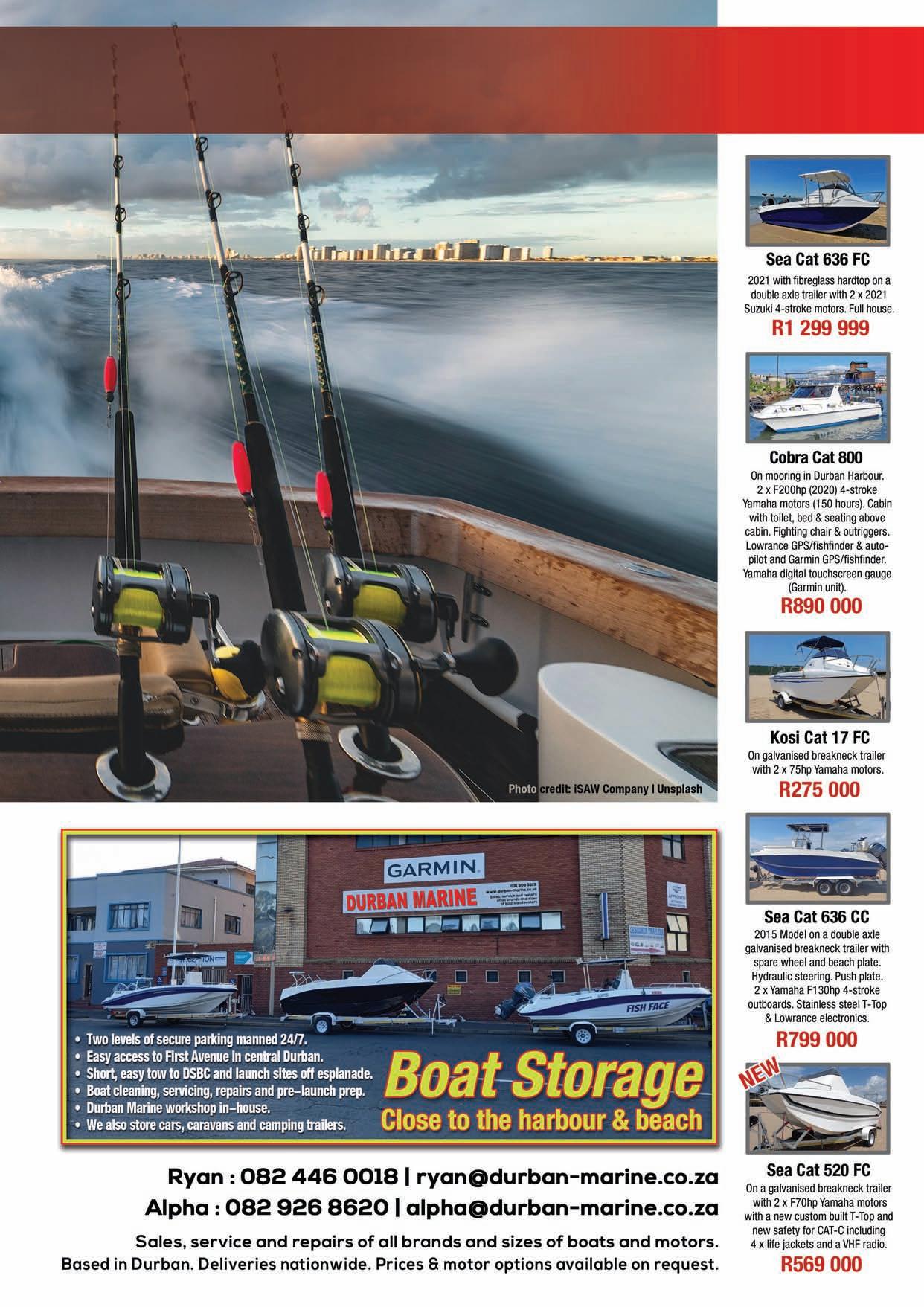
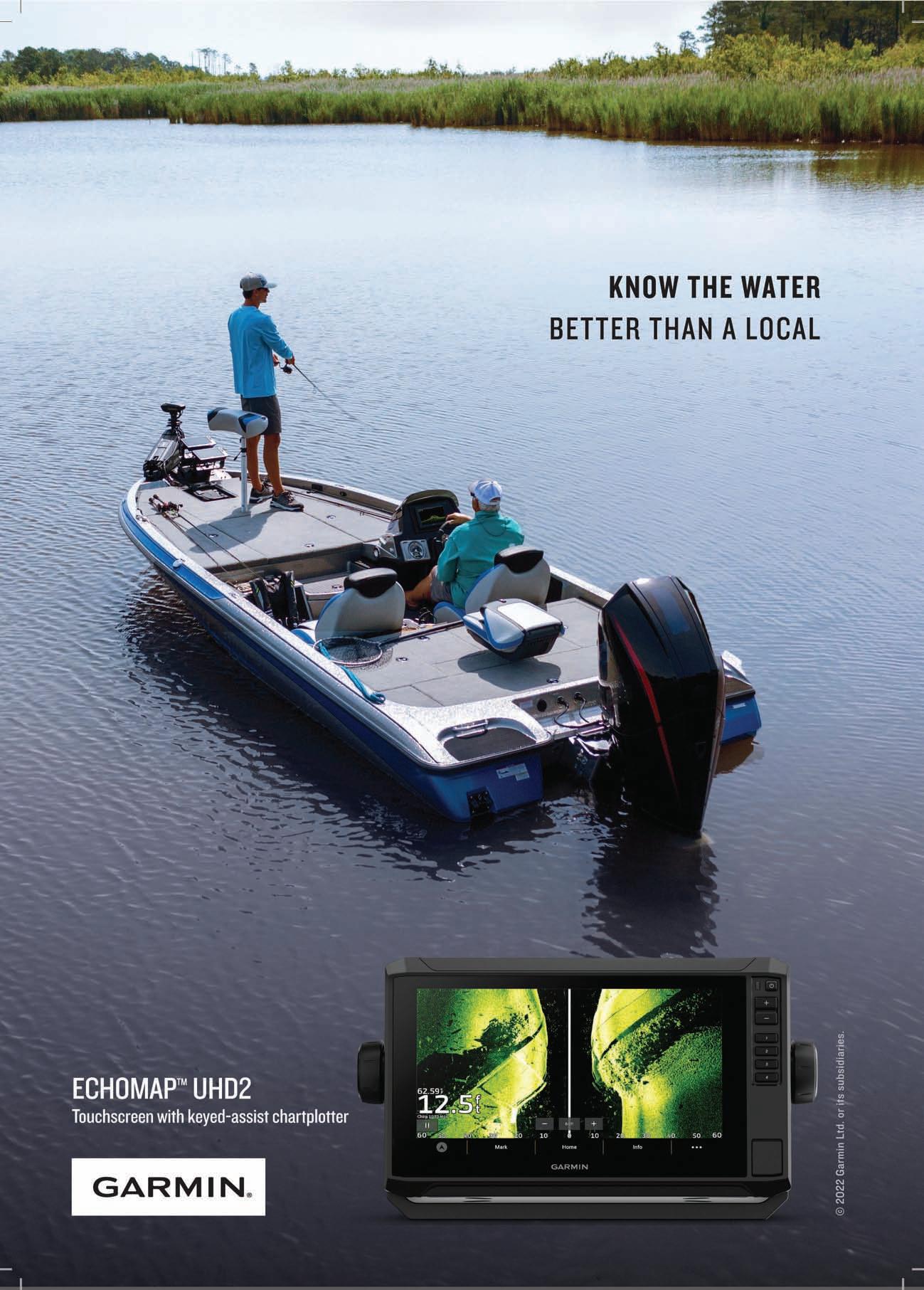
The piece missing on top of the tuna’s head is due to a Japanese technique of killing fish called Ikejime. This involves the insertion of a spike into the tuna’s hindbrain, followed by a thin wire that runs into the spinal column to prevent any further muscle movement. This stops the lactic acid build up in the meat. It is fast and considered the most humane method of killing the fish, with the greatest respect given to the fish. The result is a higher quality of meat and fresher taste because the flavour and texture is preserved.

RECORDCATCHES
Above: Ryan Nienaber, Jan Westdyk and Andrew Nienaber with a southern bluefin tuna Jan caught on 19 May as part of a tuna grandslam.
Cape Town’s first tuna slam
By Ryan Nienaber
FRIDAY 19 May 2023 started off like any other fishing morning for the Greenfish crew — leaving the house at 3am,arriving at the factory at 4am,prepping,fueling and icing the boat,and getting ready to find the freshest and best quality tuna that the Cape waters have to offer.
Greenfish is a family-run seafood company,and we specialise in providing high quality,low impact linefish and tuna to restaurants and homes in and around Cape Town.
We use a combination of rod and reel bait fishing,poling and trolling with lures on a typical day’s tuna fishing off Cape Town.
After a 40-minute tow to Hout Bay we set off to the area where some big longfin in the 18-20kg range had been caught the day before in good numbers. A 35NM run over some windless,big rolling seas with a 3m swell took us to the right zone.
With all the key elements — birds, water colour,baitfish and the temperature jump — lining up just perfectly,we
were sure we were going to go on quickly.
One hour turned into two hours, then it was midday and we only had one longfin on board.It’s amazing how Mother Nature has a way of crushing your excitement and giving you a reality check that you will only have what Neptune chooses to grant you for the day.
Eventually by 1pm we had a total of two yellowfin and one longfin on the boat,and we didn’t know which way to turn or what to do next.
Then,out of nowhere,a log drifted past us and we saw a couple of dorado under it.Everyone raced for a spinning rod,and before we even got a cast in one of our bait lines went screaming off,then another and then a third.
From dying of boredom to full on action fighting three fish simultaneously,it was game time.
All the anglers on board are experienced tuna fishermen,but they were moaning and taking longer than normal to get the fish up.Twenty minutes quickly turned into 45 minutes and then we saw colour on the first fish as
it circled towards the boat.
I quickly noticed the colour was more silver blue than we’d expect of a yellowfin,and the fish had no sickles. Jaco Louw,the angler,presented the fish to the gaff and we loaded a beautiful big eye tuna of around 85kg.Heaps of excitement ensued as it was the first big eye on our new boat.After a couple of photos the fish was dressed and into the ice she went.

Another 15 minutes or so after this madness had begun,a screech of disappointment was let out from the back deck.The fish had run out all the line on a Tiagra 80W right down to the knot on 12kg of drag.In desperation my brother,Andrew,held on and the line broke on the hook.His heart sank as he wound up the slack line.There was no time to waste — a new line was quickly baited and sent down,and it was on straight away again.
Meanwhile Jan Westdyk still continued to fight his fish,taking extra care to bring it in slowly,or perhaps he had slowed down from fatigue.It must have been close on an hour later when he finally presented his fish to the boat.I
22 • SKI-BOAT July/August 2023
Jaco Louw with a fat 85kg big eye tuna.
sank the first gaff in and held on — this was a big fish! All hands came to assist and we hauled the monster on board — an estimated 120kg big eye tuna.Jaco’s few minutes of fame were quickly overshadowed by this absolute beast that laid the entire length of our fish box.
The day had quickly turned around and we started hooking up more and more good size yellowfin tuna in the 70-90kg size range.

Jan was baiting in the bow when his line went,and he though he had a longfin tuna as the run was very different to the yellowfin that we had just been hooking into.Suddenly the fish woke up and went down and down and down.Perhaps it was another big eye? Everyone carried on working on deck when the call came:“I have deep colour!”As soon as the fish came alongside I saw it was a bluefin tuna of around 80kg.
What a turn around for the day,but it was not over yet! As the light started to fade and the catches died down,Jan hooked a great longfin,completing the first Cape Town tuna slam that I have witnessed by a single angler in one day.
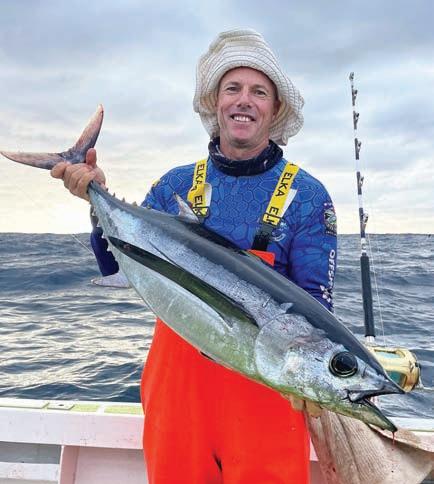
He’d hauled in a big eye of 132kg,a southern bluefin of 75kg,multiple yellowfin of 60-80kg and a longfin of 18kg

 Jan Westdyk, Jaco Louw, Ryan Nienaber, David Zaymes, Andrew Nienaber and Ryno Robinson with their 132kg big eye tuna.
Ryan (above) and Jan (below) with two of the longfin tuna caught on 19 May 2023.
Jan Westdyk, Jaco Louw, Ryan Nienaber, David Zaymes, Andrew Nienaber and Ryno Robinson with their 132kg big eye tuna.
Ryan (above) and Jan (below) with two of the longfin tuna caught on 19 May 2023.
to top it off.
I have fished off Cape Point for many years and had the privilege of catching all these fish many times over, but to get them all in one day in a slam is something extra special.
But Neptune still had one more treasure to share with us for the day.As the longfin came up,I went to the off side of the boat to drop a spinner,and saw a very long needle-like object coming past me.It took my brain a few moments to realise what I was seeing as I muttered the word “MARLIN”. Quickly everyone jumped over to have a look,and Andrew quickly corrected me:“Ryan,that’s no marlin,that’s a broadbill!”A 200kg-plus fish cruised gently pasted the boat on the surface displaying its beauty.
After that we called it a good day and ran in to be welcomed by the Atlantic Boat Club who kindly weighed the big eye for us ...it tipped the scales at 132kg.
This is why,after countless days of days of tuna fishing off Cape Point over the last 20 years,I’m still too excited to fall asleep the night before.You just never know what the day has in store for you.

WHATITTAKESTOCATCHTUNA COMMERCIALLYOFFTHECAPE
GREENFISH runs a purpose-built 28ft Cape Craft powered by two 300hp Yamaha engines. The layout is multi-functional to suit tuna, snoek and yellowtail fishing. The deck layout changes according to what they are targeting to optimise fishability and quality control of the fish.


The crew uses a combination of rod and reel bait fishing, poling and trolling with lures. Poling is fishing using a bamboo pole, with a short piece of line and a weighted skirted hook, that you dance on the surface under some water sprayers that mimick baitfish.
The longfin then shoot up to the sprayers to eat the chum that you put in the water and take the dancing lure, and you pull them in. It is highly exciting, fast and a true one-on-one tug of war with your opponent.

Poling is not to be confused with trolling, when you pull a skirted lure behind the boat while you are searching for a school of tuna you choose to bait on. Once you get a strike, you will start baiting in that area with rod and reel.
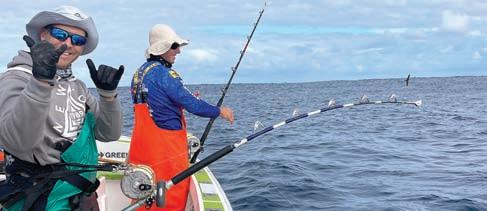
24 • SKI-BOAT July/August 2023
Brothers Ryan and Andrew Nienaber show off the first tuna slam on their boat.
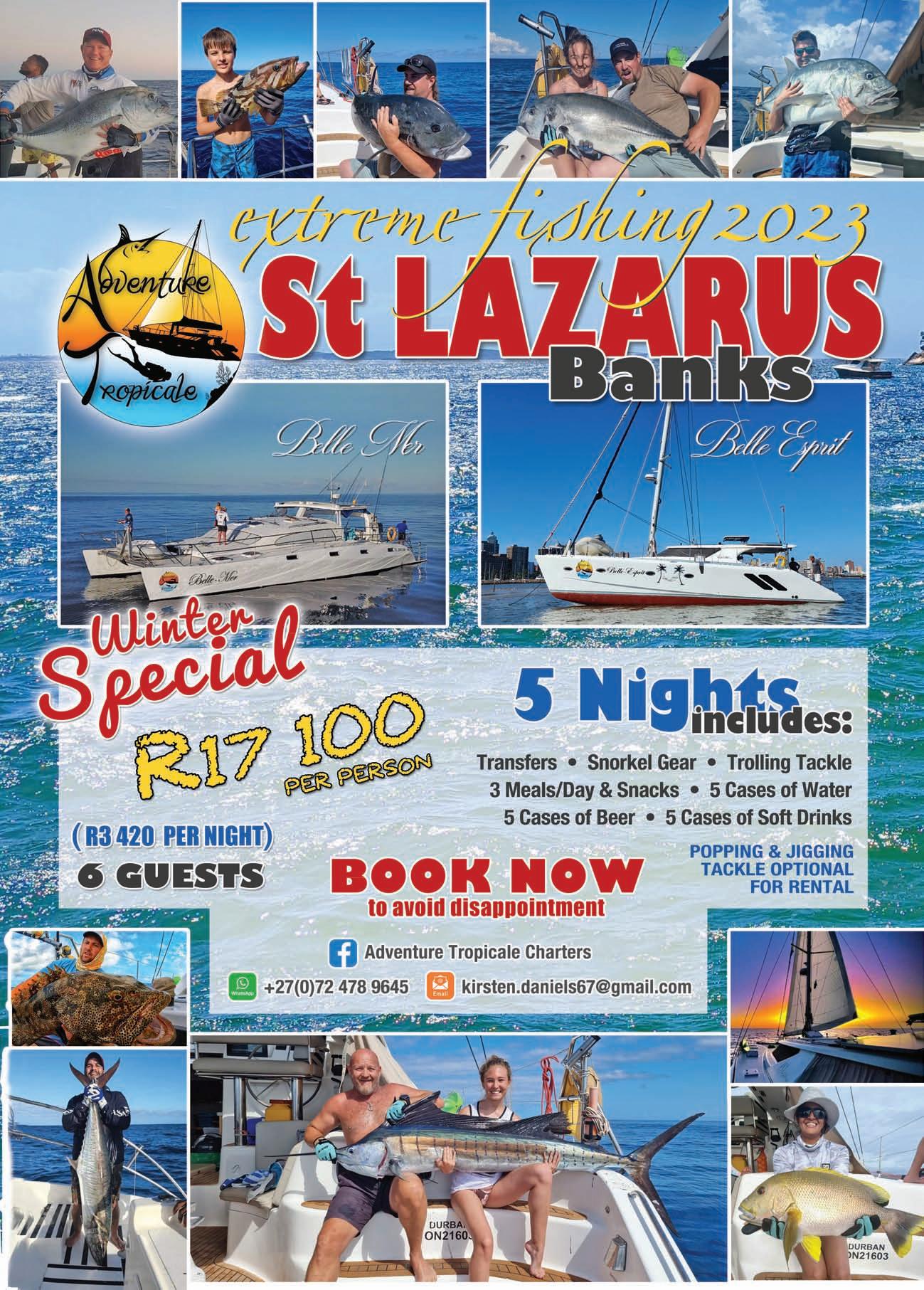
REACHFORTHESUN
DURBAN is known for its sunny skies and fabulous balmy weather all year round,but unfortunately that wasn’t the forecast for the long weekend at the end of April,during which the 2023 Durban Ski-Boat Festival was held at the Point Water Sports Club.
The mood among the anglers on the ocean and the crowds on the beach was still bright and cheerful,but grey clouds covered the skies and strong south-westerly winds meant the first day’s fishing was called off early due to dangerous sea conditions.

26 • SKI-BOAT July/August 2023
COMPETITION
Smiling like they just won a boat...
Linden Naidoo and his teammates, Brandon, Bryce and Breece Samigan and Balan Govender with Bill Harrison from Natal Caravans and Marine

SKI-BOAT July/August 2023 • 27
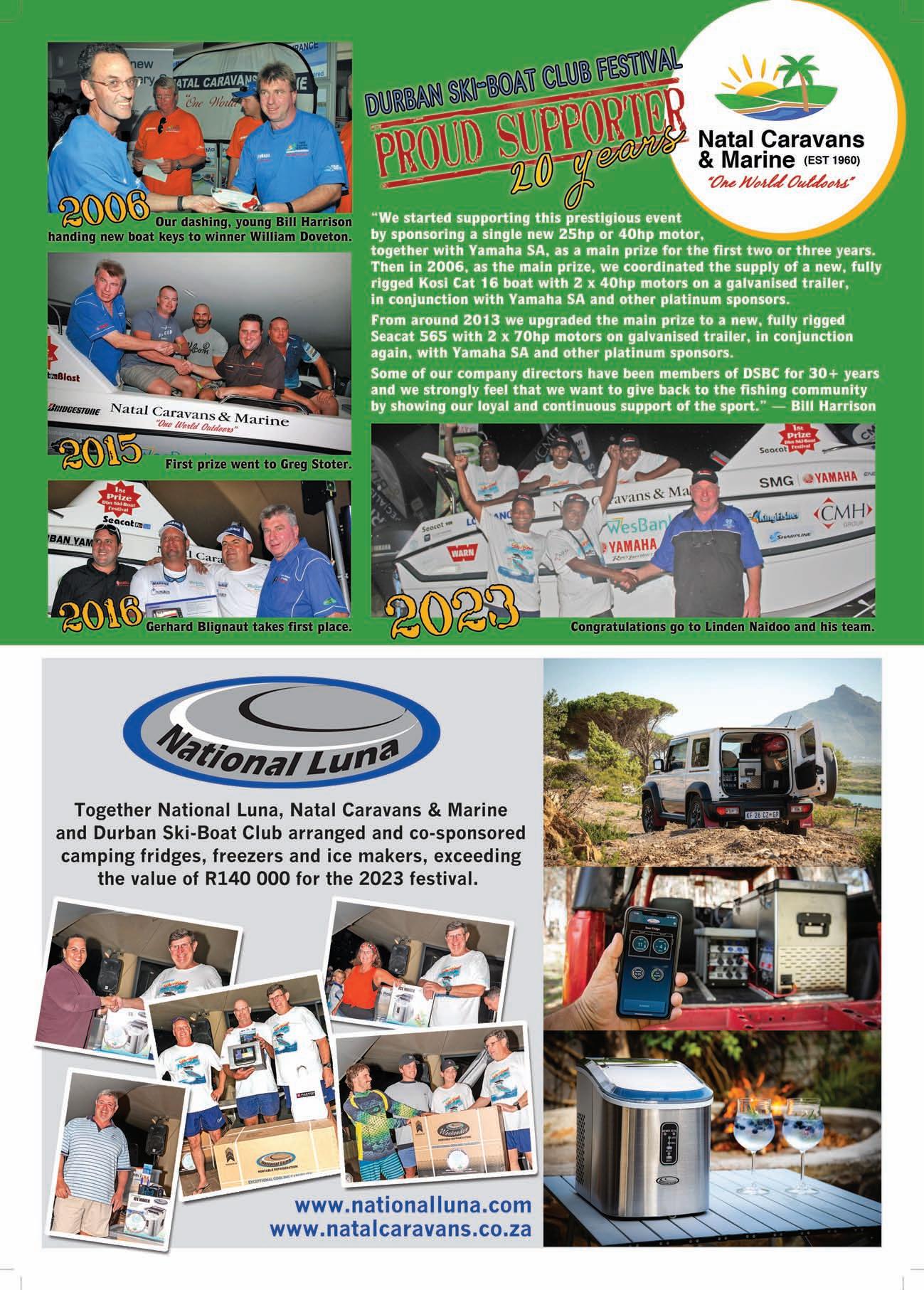
However,fishermen are nothing if not tough and determined,and the “washing machine vibes”did nothing to dampen their spirits.
Just after lunch on the Saturday,the crowds surged around the scales,watching as one beautiful fish after another was brought in to be weighed.
There was great jubilation among the onlookers when Russell Carsten’s fish pulled the scales to a very respectable 23.14kg,eclipsing all the previous fish weighed.No doubt Russell was hoping his luck would hold and he would be the lucky angler to walk away with the Seacat 520 with two 70hp Yamaha motors and a trailer,all worth R690 000.
However,that was not to be,and not long after Russell’s beauty was weighed,Linden Naidoo walked up with a properly fat fish that created ripples of excitement among the audience.Everyone held their breath as the numbers kept climbing on the scale,finally stopping at a very solid 26.08kg.


Now it was Linden’s turn to hold his breath,hoping his luck would last.
With the wind predicted to rise again on the Sunday,the fleet set out early,eager to see if anyone could best Linden’s great catch which had been landed off Umdloti at 10am on Saturday.
The catches on the Sunday were not as good as those the day before,and when weigh in closed at 2.30pm,Linden could finally let out a sigh of relief that he was still top of the leader board.
Over 200 boats entered the 2023 festival,with many of them being the old faithfuls who make the event what it is. Although anglers don’t need an excuse to get out on the water,no doubt part of the reason they participate is the opportunity to win a share of the R1.3-million in prizes that was up for grabs,and with the top 15 ’cuda winning prizes, along with other prizes for the ladies’and juniors’divisions and various species prizes,there was plenty of opportunity to walk away with some swag.

The DSBC Festival is blessed with incredibly loyal and generous sponsors,who clearly feel they get value for money being involved in this event,with Alan Gouveia noting that this year they had people phoning the committee saying they wanted to be part of the festival.
One of the most loyal sponsors is Natal Caravans and Marine which has been a supporter of this event for 20 years now.At the prizegiving function Bill Harrison of Natal Caravans and Marine remarked that they see the festival as an opportunity to give back to the anglers who support their business.He clearly recalled Hilton Kidger approaching the company for sponsorship for the first time back in 2003.
Entries for the 2024 event will open in November,so keep an eye out in Ski-Boat magazine for further details.

In the meantime,the 2023 winner,Linden Naidoo,was happy to share the story of how he and his crew won their boat-worthy fish ...

SKI-BOAT July/August 2023 • 29
ABOVE: Erwin Bursik and young Reed taking turns in the SKI-BOAT mag fighting chair.
RIGHT: Russel Carsten took second place with his 23.14kg ’cuda.
BELOW: Gabi Stow showing off her 9.78kg queenfish.

A dream come true
By Linden Naidoo
MY passion for fishing started at a very early age,and I enjoyed rock and surf fishing which was taught to me by my late grandfather.My passion for fishing grew even more when I accompanied my friend Balan Govender on his deep sea trips. Balan has been very instrumental in teaching me the ropes and it’s through his perseverance that I am now a skipper.
Preparation for the DSBCFestival started a month before the competition when I invited my close friends Brandon,Bryce and Breece Samigan, and Balan to join me in fishing the event.The four of them became equally invested in our preparation and Brandon made us our unique shirts which we wore on day one.
Balan,who has almost 30 years of experience on the water,together with Kirsh from Cast Away Bait & Tackle,got busy sorting out traces and a variety of fresh baits which included wala wala,bonnies and the golden mackerel.We also collected intel on where the fish were feeding and which baits were working best in the weeks before the competition.
On the Saturday morning I made my way to the Bluff Yacht Club extra early to prepare my boat, Elzar II,for our launch,and when the rest of the crew arrived around 5am we headed towards the basin to carry out the radio check.
Anxiousness and excitement began to creep in as we busily began tying up a few last minute special traces.With the strong south-westerly blowing and big seas to contend with, we made a collective decision to fish north.
There was no time to try for live baits,so with our cooler boxes stocked up with fresh dead baits we headed north. When we approached Umdloti we put out a spread of different baits,waiting patiently to see which would get the attention of the “crocs”.The water temperature was 23 degrees and we pulled our baits along the 22m line.
Thirty minutes into our troll we heard soothing music to our ears — the sound of a screaming reel.Balan was closest to the rod and he set the hook.With adrenaline pumping,I took over the wheel.In the meantime Brandon,Bryce and Breece started pulling in the other baits to avoid any entanglements.
To our dismay,the wire on the trace broke and we lost the fish! Disheartened by the loss,we slowly began to reset the spread,changing baits to the magic mackerel.When we continued trolling,we had a few laughs about the “croc”that got away.
Twenty minutes later,while we were deep in conversation,the sound of a screaming reel caught our attention.I jumped up and set the hooks.“What a screamer!”I yelled to the crew.
After two solid runs the ’cuda was under control,with Balan at the wheel skillfully manoeuvring the boat closer to the fish so I could retrieve the line faster.What a beautiful sight when the ’cuda came to the surface.
The pressure was on,so I nursed it carefully towards the boat,making sure not to lose it.Balan stuck one gaff into the side of the fish,and Brandon gaffed the fish in its mouth.With the ’cuda secured and adrenalin pumping,we hauled it onto the deck.
The anglers on nearby boats who had witnessed this fish
being brought aboard were in awe and there was great excitement on our boat. Our eyes were the size of golf balls,barely able to comprehend the size of the “croc”.
With this possible contender safely in the hatch,we continued trolling.
Soon afterwards we saw an angler on another boat giving his ’cuda the “anaesthetic”,and began to wonder whether their catch was bigger than ours...
At approximately 11.20am the radio call from base came in informing all the boats that fishing was being called off due to the inclement sea conditions,and that we had about two and a half hours before weigh in closed.
As we made our way back to the Durban Ski-Boat Club,the south-westerly was pushing hard,but we didn’t mind the spray drenching us because we were so overwhelmed and excited.
Balan beached the boat and I battled to carry the fish from the boat to the scales.At the scales I was notified that the weight to beat was a 23kg beaut.My fish was duly hung up,and I stood in awe and amazement watching the scales stop at 26.08kg!
I threw my hands in the air,full of joy. Unbeknown to me,the spectators had gathered behind me and suddenly gave me a round of applause.This memorable moment confirmed that my fish was the one to beat for the day.Having the fish on the podium,even if it was just for a few minutes,was overwhelming for me and history in the making.
With a bounce in my step,I hurried back to the boat to give the crew members the exciting good news.Balan was very emotional,and shared that he had fished this competition many times,but this was an epic day for him.We headed back to the Bluff Yacht Club,happy to end our day on a very high note.
DAY 2
On the Sunday,we launched at 5am and,because of the heavy sea conditions and gusting winds,we decided to fish close to Durban and to target species.
We headed to Blue Lagoon to target snoek,and it didn’t take long for the snoek to take our bait.Brandon hooked a specimen that gave a beautiful display of speed and fight,but unfortunately the hooks pulled and that fish was lost.
We continued trolling but had no further luck,and with the sea conditions changing and winds picking up,we decided to call it a day.
Those that braved the water and brought their fish to the scales that afternoon caused a lot of anxiety among the contenders,including me.I paced nervously to and from the scales with knots in my tummy,just waiting for cut off time.
Eventually I was called up to the stage to be told that I had caught the biggest ’cuda and was the winner of the 2023 DSBC Festival.A prestigious moment indeed!

TACKLE USED
Kingfisher Poseidon 8 foot 15-20kg Couta Rod
Daiwa Saltiga lever drag 50
500m backing whip lash braid
.55 double abrasion top shot
Kingfisher .80 leader
Pulsator couta duster with 2 ounce chin weight
Two trebbles,No.2 - 4 extra strong
No.7 wire
Bait:fresh mackerel
SKI-BOAT July/August 2023 • 31
Linden Naidoo with the winning ’cuda weighing in at 26.08kg.
...and below, almost a great catch.
Thank you one and all
By Hilton Kidger
WHAT a weekend it was,with 220 boats and 640 anglers competing for R1.3 million worth of prizes — the largest offshore festival of its kind in Africa,and fished by the best fishermen,fisherwomen and fisher kids in the world,supported by great music and top-class fellowship.
Every sport has its fair share of camraderie,but it is hard to beat the enjoyment of anglers when they get together and share fishing tales.It’s fascinating how quickly a guppy becomes a world record ’cuda.Thank you to all our participants this year — you did not disappoint!
At this year’s festival members from 30 clubs gave it a full go — the largest turn out by clubs ever — with anglers coming from far and wide across the country.

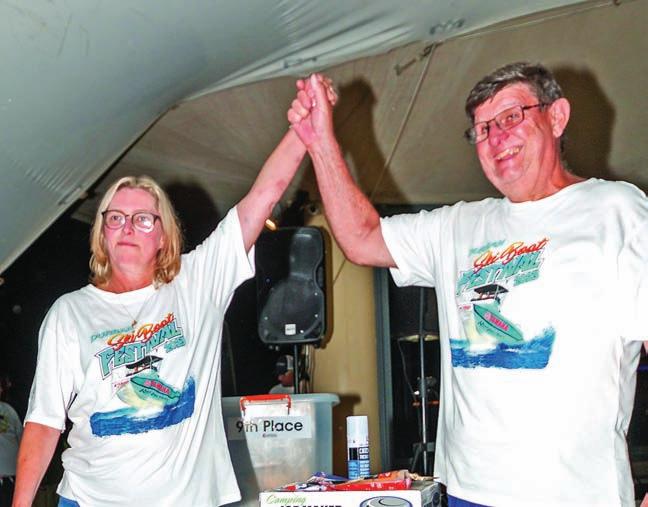
One group from Vryheid who left at 2am on Friday morning had to be guided in by satellite communication and laser beam reference points as they made their way towards the Tugela and then onto the Umgeni and finally the DSBC.I understand their electronic equipment was geared towards Bulldust-fontein Dam somewhere in the Freestate,and their automatic pilot,called “Klippies and Coke”,kept them confused.Thankfully I understand they made it safely home!
Well done to all those who crossed the mighty Tugela. Two particularly well known reprobates — Les Harley and Shaun Barker from Mapelane Ski Boat Club — even brought passports with them to cross the Tugela! It was a worthwhile trip for them,and Les won some excellent prizes for the prodigal son he caught.Typical of his generous nature, he gave this prizes to nine-year-old Kade Owen who was fishing on Clinton Barclay’s boat, Devocean.What a gesture, Les!
The compliments we have received from so many of our participants are incredible,and we have passed them on to our staff who really stepped up to the plate once again.
The Durban Ski-Boat Club thanks all the anglers and their families for the fantastic support.It was our privilege to host and entertain you,and we can’t wait to welcome you all back next year.Put it in your diary now:last weekend in April 2024!
Our very generous participants also made countless contributions to the NSRI,with over R14 000 in donations coming in.
We’re also very grateful for the support from our tractor drivers and the CMH Group drivers who gave up a long weekend with their families to make our weekend so pleasurable.To Lizzie van Huysteen,and Kelly and Cara Gray,a big,big thank you.The Gray family have been at every comp for over 20 years,and their contribution is immeasurable.
To Grant Wessels,(our GM),Lynda Lavery and Jackie Kruger — our first line of defence in the office — as well as Roxy Wise and Mike Crofton and everyone on their team, please take a bow and accept our thanks.
TOPSPECIES
Dorado: Barend Nienaber7.14kg
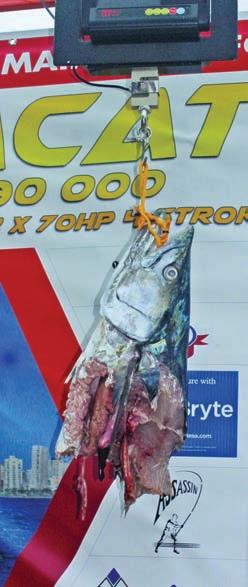

Queenfish: Gabi Stow9.78kg
Prodigal son: Les Hartley11.32kg
Snoek: Graham Smith6.38kg
Bonito: Mark Justham6.26kg
Finally,to our sponsors,thank you so much for believing in us.We hope you will be with us again next year.
Before I finish off,I must share this message I recently received by sea-mail from the ’cuda head honcho,Inkunzi Cuda,a bull of a fish:
“We came from Moçambique to Durban because you kindly invited us on holiday.You said there was an abundance of shad,silky,live maasbunker,bonnies and many other specialities — all for free.You even arranged for passport control to let us out of Mozam and into KwaZulu-Natal without formalities.
“Your kindness even went further in that you said the best waiters in the world who would serve us great delicacies,offering them at different depths.There was no discussion about hooks!”
Sea you next year!
32 • SKI-BOAT July/August 2023 TOP10 ’CUDA Linden Naidoo 26.08kg Russell Carsten 23.14kg Trevor Ackhurst 22.72kg John Moore 19.12kg Justin Annells 19.00kg Kyle Loumeau 18.40kg Kaden Barclay 18.18kg Rowan Wulff 17.94kg Anthony Sardinha 17.66kg Bugzy Stubbs 17.38kg
TOPLADIES Suzanne Louw12.04kg ’cuda Gabi Stow 8.86kg ’cuda Di Rogers 8.56kg ’cuda TOPJUNIORS Kaden Barclay18.18kg ’cuda Matthew Thompson15.36kg ’cuda Dylan Jacobson14.34kg ’cuda
Alan Gourveia celebrating with Suzanne Louw who was the top lady angler with her 12.04kg ’cuda.
Congratulations to our top three juniors, Kaden Barclay, Matthew Thompson and Dylan Jacobson.
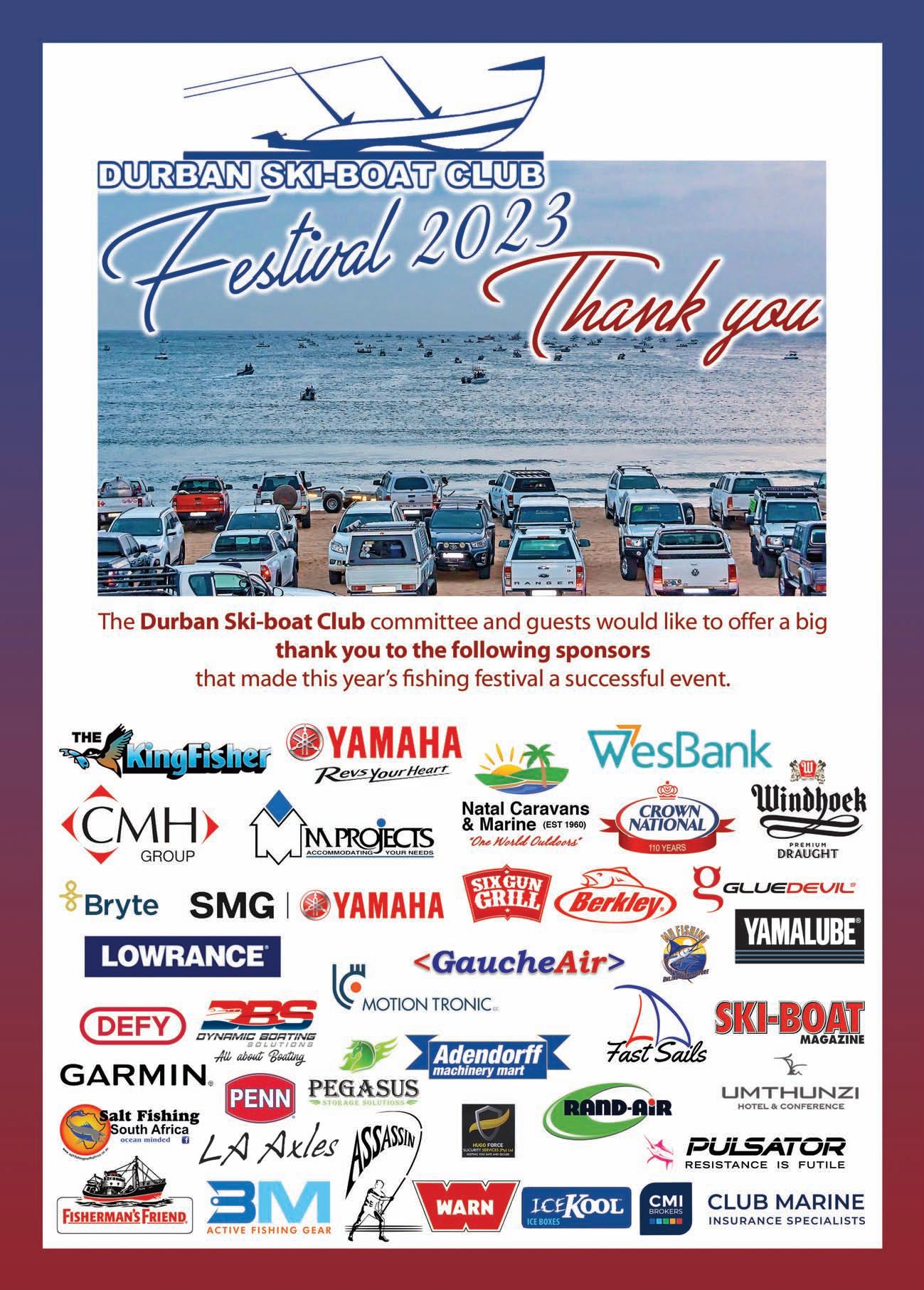
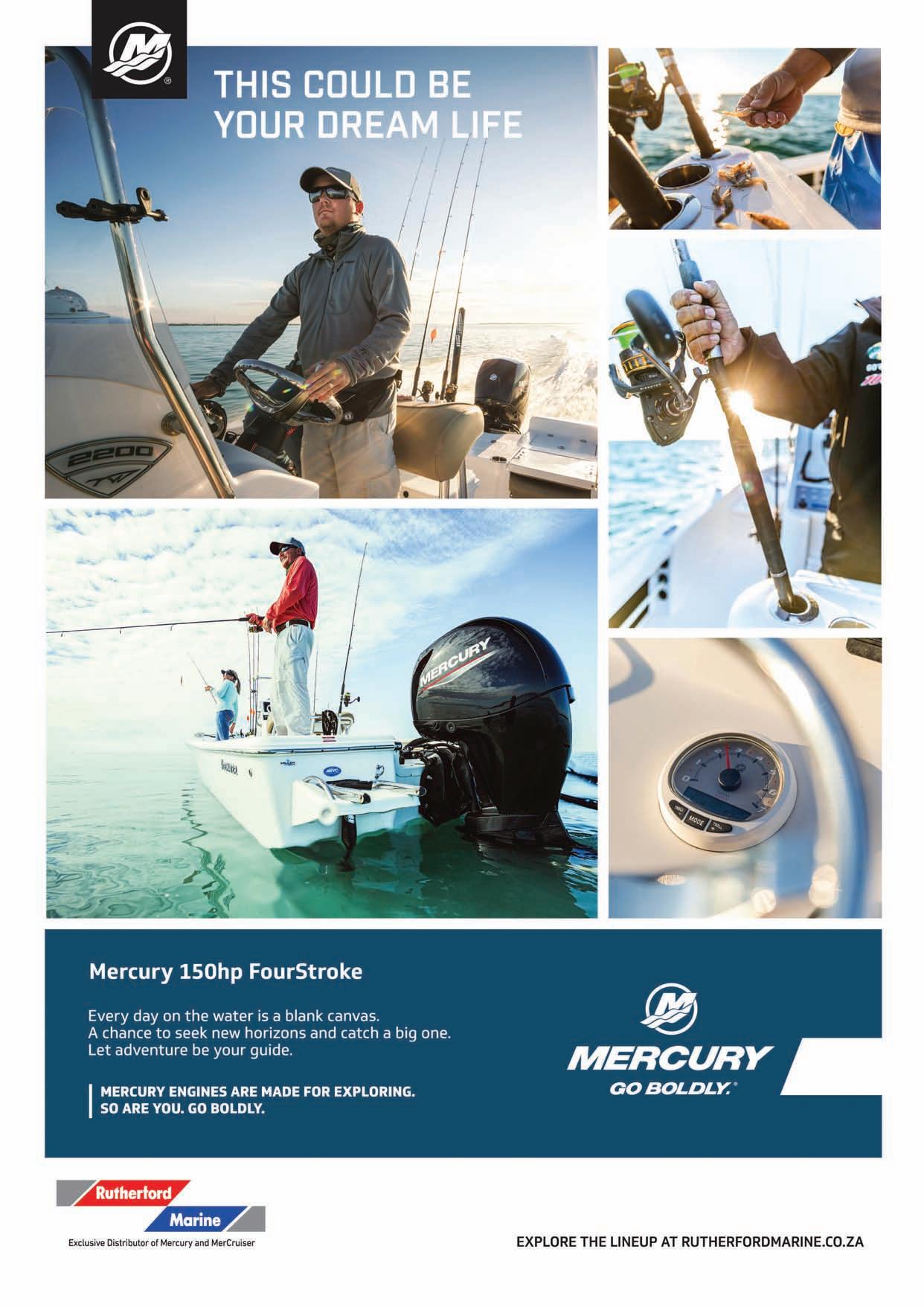
Hunting GTs in Moz
By Mark de la Hey
THERE is no doubt that the GT (aka giant trevally/giant kingfish/caranx ignobilis) is one of the most prized jewels in Neptune’s crown.Those who don’t fish can barely comprehend why anglers spend so much time and money travelling great distances to catch these magnificent creatures,but for those in the know,no distance,effort or amount of money is too great.After all,it’s what you would do for any great love,and the GT is certainly one of my great loves.

TACTICS
So why all the fuss over this particular species?
I guess,in a nutshell,it’s because it’s a challenge.The hours,dedication and effort required to land a fine specimen proves it’s among the most challenging of any of the species world wide.
The heart stopping smash on the surface lures,the dogged determination of the GT in its efforts to cut you off on the reef,and the sheer power and size of these creaures captures the hearts and imaginations of anglers across the globe.Their elusiveness just adds to the allure.


As with all fishing,but especially with the GT,there are zero guarentees that you’ll find the one you want or be able
to land it.Despite that,anglers are prepared to go to extraordinary lengths in their quest to get the bite that hopefully stays on and,God willing,to spend a few special moments with their prize before returning it safely to its kingdom where it reigns supreme.
There are so many factors that come into play when targeting GTs,and even when all the planets align,if the fish aren’t there,then they simply aren’t there.Those factors are out of our control,but there are some things that we can control.If you make sure that you are always on top of the factors you can control,that will help you convert the chances you get and keep you going back for more.
TIDES
As with most fish,GTs love feeding during the times when there’s maximum water movement over the reefs they patrol. Obviously that means fishing over the spring tides is the optimum time of the month to try.
The point of the tide when there’s the biggest water movement has always produced the best results,so the time of day is not as important as the flow of the tide.
On different reefs the tidal flow will hit the structure from different directions,so it is important to use your fishfinder to identify where the structures are,how the current is hitting
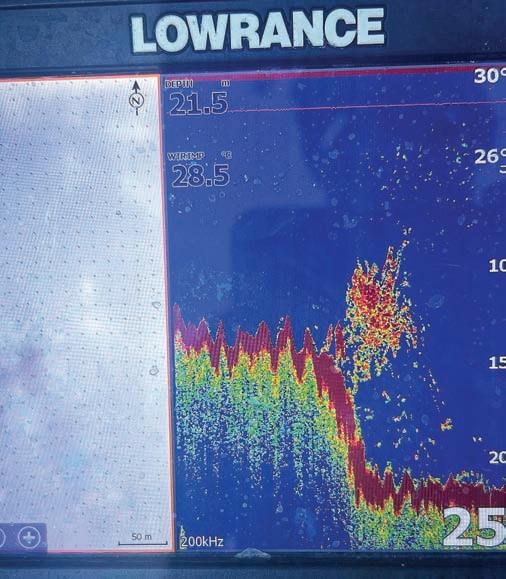
36 • SKI-BOAT July/August 2023
If you get in the right place at the right time with the right equipment you’ll get a good bend in your rod, and hopefully a GTon the boat.
them,where the baitfish are sitting,and where is likely to be the best place to throw for a bite so that you can also realistically get the GT away from the structure as soon as possible.
All this knowledge and planning is crucial if you want to have the best chance of landing that bite of a lifetime.
TIMES OF THE YEAR
The best months to target GTs can differ greatly from location to location,but I’ll focus on the upper north coast of South Africa up into Moçambique and Tanzania.These areas follow similar trends,with the big difference being that the further north you go,the less of a winter drop off in fishing you will experience.
Generally,the more unfished an area the more opportunities you will have and the more fish you’re likely to find. As with any species,the more pressure there is on an area,the more difficult it becomes to fish there.
Having said that,in my experience along this stretch of the African coast, January through to April produces slightly fewer fish,but on average much bigger fish.May to August is still good GT fishing time,but you’ll get more other kingfish and mackerel species in between.September through to December produce the greatest number of GTs in a variety of sizes.
Obviously this is just a rough guide and can differ significantly depending on sea conditions,water temperature and other factors.
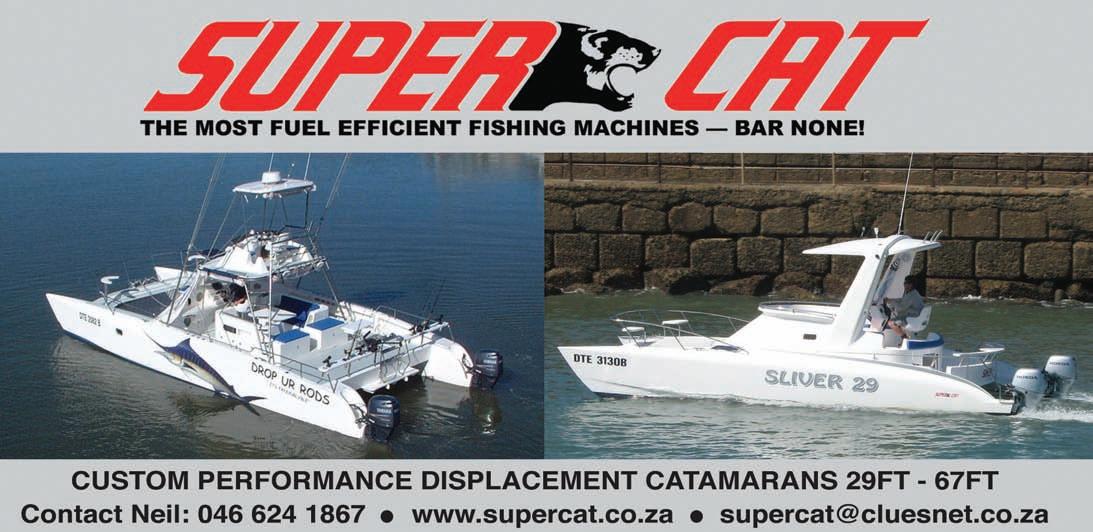
TACKLE
Many anglers think if they buy the most expensive tackle that will give them the best chance of catching the fish they’re targeting.If you set it up and use it correctly there may be some truth to that, but tackle alone won’t catch the fish.

SKI-BOAT July/August 2023 • 37
The author with a massive GT caught off Mozambique.
I don’t believe in buying expensive tackle just for the sake of it,so I’ll explain what tackle I use and why.The results,I believe,speak for themselves.
One thing to note is that although you can use the same rod to throw stick baits and poppers,the rods designed for each application are vastly different,and if you use the correct rod for its intended purpose you will definitely improve your results.
STICK BAIT ROD

Stick bait rods have a softer tip than the popping rods,giving you more control when sweeping and twitching the baits.My two rods of choice are the OTI (Ocean Tackle International) 8ft 40–60lb TS2 and the Penn Battalion 7ft8in 25kg model. These two rods have nice sensitive tips to work and manoeuvre the stick baits,and enough back bone to send you to the couch for a week’s rest!
POPPING RODS
Popping rods are much stiffer than stickbait rods,with less sensitive tips so that when you give the rod a good crack to pop the popper,the rod doesn’t bend and flex too much.If that happens it loads up and pulls the popper out the water, causing it to jump and spin which is not what you want.The stiffer rod loads up less and helps the popper pop in the water instead of spinning out.
My rods of choice are the OTI 8ft 60-80lb TS-2 and the Penn Battalion 8ft 35kg model.
REELS
Here you can literally spend an arm and a leg if you are not careful! It’s no secret that I am sponsered by Penn,so obviously I use them exclusively.Having said that,this has forced me to fish with reels that I might not previously have trusted to do the job merely because of their cheaper price tag.Now I’ll bet my life on them!
All the fish shown in this article and hundreds more have been caught on these reels,and the best thing for me is that the majority of the fish were caught by relatively inexperienced anglers and the reels stood up to the test.In my opinion,that speaks volumes for the product.
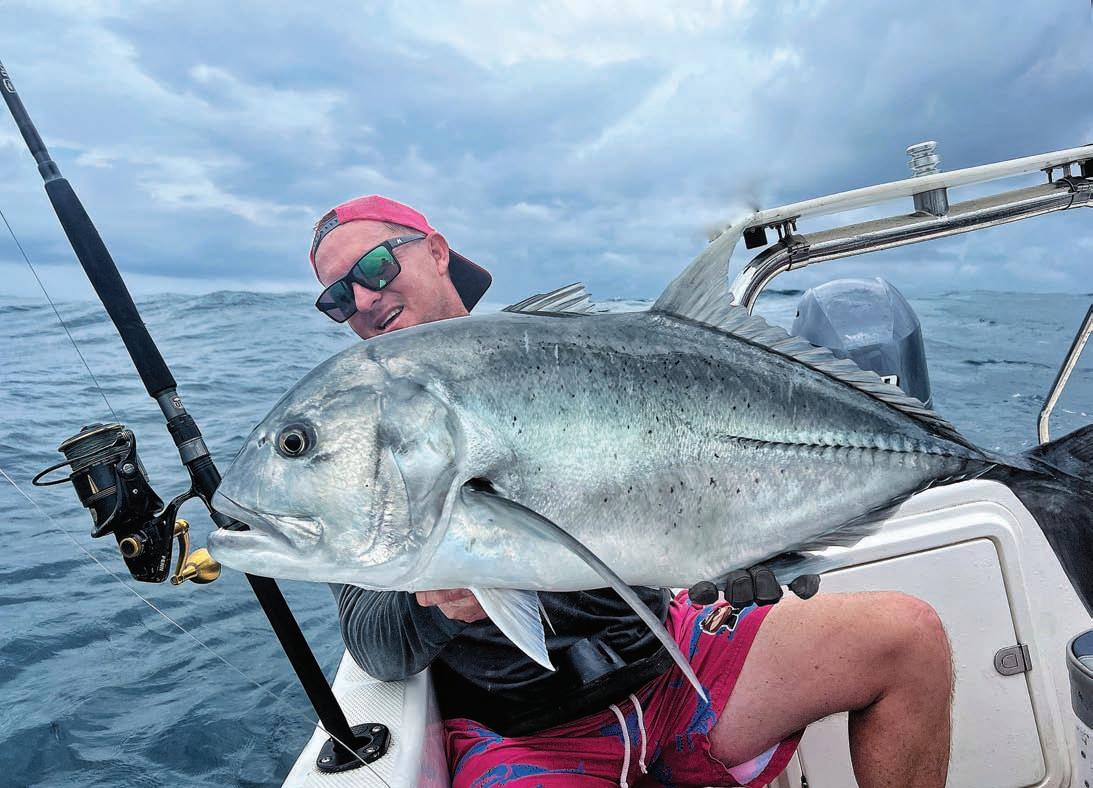
The reels we have been using for both the stick bait and popping setups are the Penn Slammer III and the Penn Slammer DX (the newer model).Both have been more than equal to the task and have a modest price tag that will make every angler smile from ear to ear.
Penn have subsequently launched a new top of the line reel called “Authority”which I’m eager to try out on my upcoming adventures.
LURES
Thinking about lure choices can give you a real headache,so I keep it simple and use what I trust and what works.The Nomad poppers and stick baits get the job done properly and are yet to let me down.The four main lures I use are the Nomad Riptide stick baits,Nomad Chug Norris poppers, Nomad Madscads and the Nomad Mavericks.These cover all the options we look for and let you fish all the necessary conditions well.
BRAID
The Berkely Whip 8 – 47.1kg and the Suffix 131 – 100lb are my two favourites that don’t let me down
That’s a brief overview of the complexities of fishing for our beloved GTs.There are numerous other factors and variables that you have to work out on the water,but if you control the things that you can then that’s a great starting point for a succesful trip!
For further information on doing a fishing trip up north contact Mark de la Hey via Whatsapp on 0761766900.
38 • SKI-BOAT July/August 2023 Another beauty ready for release.
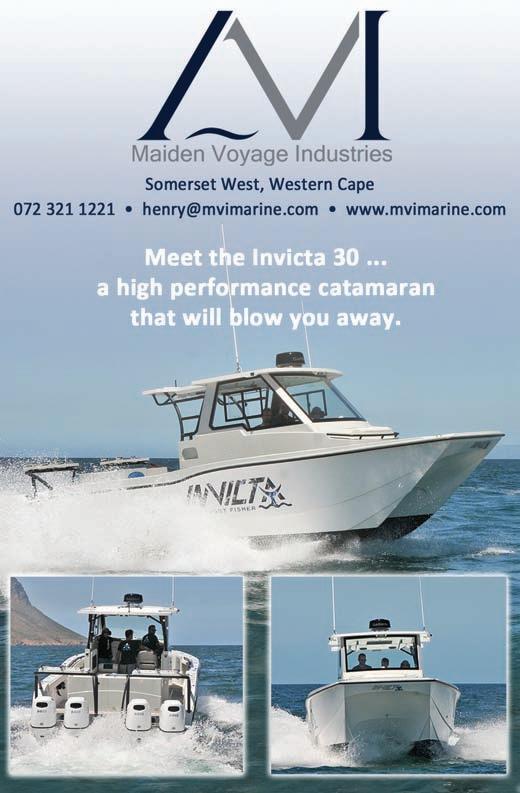
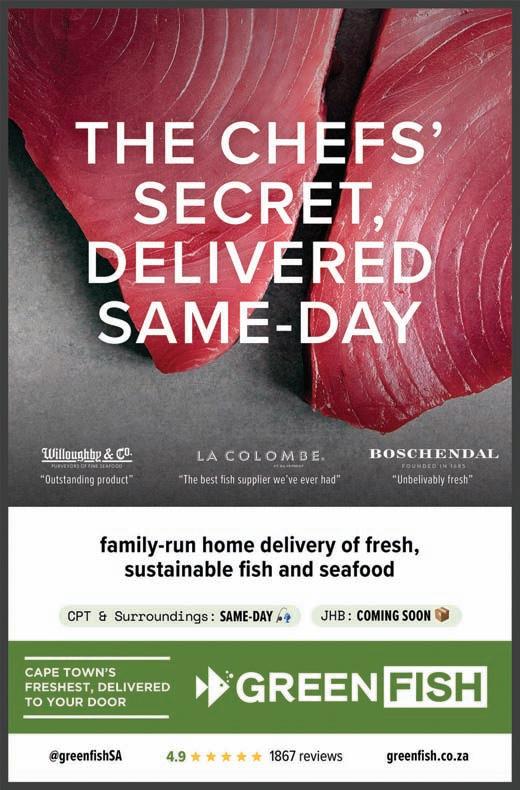

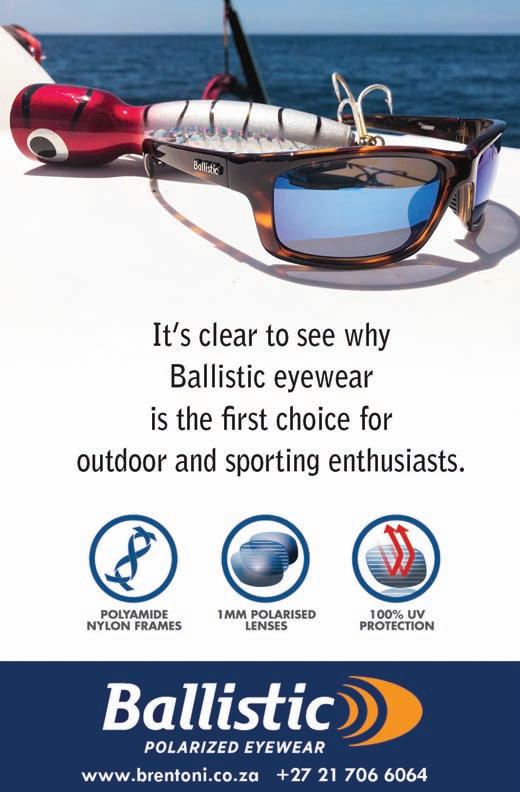
SKI-BOAT July/August 2023 • 39
PRESIDENT’SREPORT
WITH the first half of the year behind us,we have seen most of our national tournaments take place,with only the Junior Bottomfish Nationals and the Senior Light and Heavy Tackle Billfish Nationals still to take place as I write.

Alongside all these fishing tournaments,we have also held the Annual General Meeting of the South African Deep Sea Angling Association and it gives me immense pleasure to announce the SADSAA Council for the 2023/2024 year on the opposite page.
We have a few new names in this list,with the notable inclusion of the newly appointed Legal Officer and a change in the position of Environmental Officer (EO).The previous EO,Mark Beyl,has moved up into the Vice President position and we welcome Malcolm Grant of Western Province as the new EO of SADSAA.Malcolm comes with a wealth of knowledge and experience in the field of conservation and preservation,and we are honored to have him aboard.
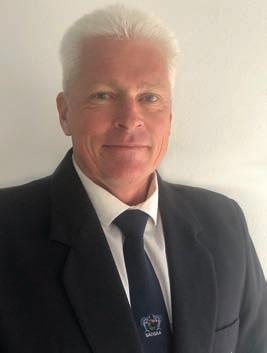
TUNANATIONAL & INTERNATIONAL
In May this year,we hosted the first Tuna International to be held in South Africa for many years.This was held alongside our annual Tuna Nationals out of the Atlantic Boat Club (ABC) in Hout Bay.Both events were an outstanding success,and we thank ABC and WPDSAA for their efforts to put this all together.
The winners of the international event were the South African Protea Team,with second going to the team representing SASACC.Our guests from Egypt were placed third overall. We thank them for joining us in Cape Town and we look forward to many more years of competition and friendship between our nations’anglers.
The National tournament was won by our SADSAAteam,with

Southern Cape taking second and a Barbarian team of provincial anglers from the Southern Cape and Natal taking third.Once again,our selectors are proving that their policies are working,and we applaud them for this.
It was great to see so many teams participating this year representing so many of our provincial bodies,but it is obvious that increasing fuel costs and inflation are really starting to hurt our sport.
A special thanks to Atlantic Boat Club and Hout Bay.It is without doubt a world class venue,with a world class fishery and we are privileged to be able to do this year after year.
BOTTOMFISHNATIONALS
In March,Eastern Province hosted the Bottomfish Nationals out of the Diaz Skiboat Club in Kenton-on-Sea. Bottomfish angling must be one of the more technical and physically challenging facets on our calendar, and this year proved this true once again.However,with such incredible hosts such as Diaz Club,it becomes easier and more enjoyable as the tournament progresses,and I tip my hat to a small club with a huge heart.
My congratulations to Jess Lester and her team in Kenton,and of course EPDSAA on an outstanding tournament.Winners were the team from EP,followed by our SADSAA U19 team.Well done to all.
At the Bottomfish Nationals,we once again had the opportunity to cap our Protea team heading off to Weymouth in England for the EFSA Championships.We wish them well and hope to see some new additions to the trophy cabinet on their return.
The last two Nationals are the Gamefish Nationals hosted by Zululand Deep Sea from Mapelane, and the Junior Gamefish Nationals hosted by Natal Deep Sea from Shelly Beach.I will hopefully be able to give more feedback on them in the next edition.
IGFAAFRICACOUNCIL
On a more international point,we were privileged to host the first meeting of the newly formed International Game Fishing Association (IGFA) Africa Regional Council in April,with many of the senior positions being held by South African anglers.
We were honored to host the IGFA President,Jason Schratweiser, who came all the way from the USA to chair this first meeting.IGFA is an incredible organisation that supports an enormous number of conservation and research programs,alongside its World Record database and of course IGFA Rules are internationally recognised as the most comprehensive available.
SADSAA has long supported the use of IGFA rules and methods of recording records,and our involvement in this new council goes a long way to strengthening these ties between us.
If you don’t know much about them,check out their website at igfa.orgYou may be surprised at just how much they do for our sport.
As always,I wish you tight lines and fair seas.
40 • SKI-BOAT July/August 2023
Chris Schorn, SADSAAPresident
SADSAAOFFICEBEARERS
2023/24
President:Chris Schorn
Vice President:Mark Beyl
Secretary:Vikki Bezuidenhout
Treasurer:Edwin Freeman
Tournament Officer:Nick Nel
Environmental Officer:Malcolm Grant
Legal Officer:Mark Beyl
National Records Officer:Peet Koekemoer
Public Relations Officer:Justin Paynter
Development Officer:Neil Coetzer
National Selection Convenor:Pieter Jordaan
National Safety Officer:Carl Krause
Deputy Safety Officer – Inland:Jannie De Jonge
Deputy Safety Officer – Coastal:Riaz Hussain
Action Committee:
President:Chris Schorn
Vice President:Mark Beyl
Secretary:Vikki Bezuidenhout
Treasurer:Edwin Freeman
Committee Member:Janes Wasserman
Committee Member:Nick Nel
Committee Member:Anton Van Den Berg
Finance Comittee:
Treasurer:Edwin Freeman
Committee Member:Janes Wasserman
Committee Member:Colin Joubert
Selectors:

Southern Gauteng:Neil Coetzer
Western Province:Hubert Meyer
Mpumalanga:Chris Rothmann
Gauteng:Jaco Hendriksz
Mpumalanga:Pieter Jordaan
Border:Allen Ford
Border:John Leuf
Eastern Province:Colin Barris
Zululand:Henk Du Plessis
Zululand:George Breedt
Keep up to date with all the SADSAA news by visiting our website www.sadsaa.co.za or our facebook page @sadeepseaanglingassociation


SKI-BOAT July/August 2023 • 41
Kingfisher Award Application Form
I hereby apply for the Kingfisher Award in the category:
Meritorious Fish Outstanding Catch
Tick the appropriate box and supply us with the following information. Please remember to print clearly.
Applicant’s Details:
Name: ...................................................
Address: ...............................................
Code: ....................................................
Tel No: ...................................................
E-mail:
Club (if member): ..................................
I, the undersigned, agree to abide by the rules of this award.
Signature: ..............................................
Meritorious Fish
Species: ................................................
Weight: ..................................................
Date of Capture: ....................................
Where Caught: ......................................
Skipper's Name: ....................................
Outstanding catch Category applied for (tick appropriate box):
3:15:1 7:1 10:1
Species: ................................................
Weight: ..................................................
Line class: .............................................
Date of Capture: ....................................
Where Caught: ......................................
Skipper’s Name: ....................................
Digital emailed photographs should be high-resolution.
YOUR favourite offshore angling magazine, SKI-BOAT , in conjunction with The Kingfisher and the South African Deep Sea Angling Association, is proud to offer all South African ski-boaters the unique opportunity to win awards for excellence in angling.
All deep sea anglers who achieve laid down standards of excellence will be entitled to apply for the KINGFISHER AWARD.Upon ratification by a panel of adjudicators,the angler will receive a handsome digital certificate,suitably inscribed.

The Kingfisher Award will be made for fish caught in two sections:
1) Meritorious Fish
This award is for a fish that’s a memorable achievement for the angler,if not


RULES:
There is no restriction on the number of awards which can be applied for. Award applicants must submit a photograph of the relevant fish with the application form and a photograph of the angler with the fish.
SKI-BOAT reserves the right to use the photograph as it sees fit.
Entries must be on the official form which is included in all issues of the magazine.
Entires must be received within 45 days of capture.
No witnesses of the catch are required. The award is made in the true spirit of sportsmanship and relies on the integrity of the angler to make a just claim. Aselection of award winners’names will be announced in future issues of SKIBOAT, along with relevant photographs. Award applicants should allow 30-45 days for processing of applications. There is no charge for Kingfisher Awards.
a personal best,and is not confined to the species listed below.
Tackle used is of no consideration here, the fish's weight being the main criterion.
2) Outstanding Catch
To satisfy the requirements for this award,anglers can catch any recognised fish species.As a guideline,the weight of that fish must equal or exceed the suggested weights below,or certain laid down fish weight:line class ratios.
Awards will be made in the following ratio categories:
3:1 – Bronze Award
5:1 – Silver Award
7:1 – Silver Award
10:1 – Gold Award.
Applies to IGFA line class 1kg ,2kg,4kg, 6kg,10kg,15kg,24kg,37kg and 60kg.
SPECIES: SUGGESTED WEIGHT:
Barracuda 15kg
Dorado 12kg
Kingfish (Ignobilis) 20kg
Garrick (Leervis) 12kg
King Mackerel (’Cuda) 15kg
Black Marlin 100kg
Blue Marlin 100kg
Striped Marlin 60kg
Prodigal Son 15kg
Sailfish (Pacific) 25kg
Spearfish (Longbill) 20kg
Spearfish (Shortbill) 20kg
Tarpon 45kg
Tuna (Big Eye) 50kg
Tuna (Longfin) 25kg
Tuna (Yellowfin) 50kg
Wahoo 15kg
Yellowtail 15kg
RELEASED BILLFISH AND GT (Ignobilis) KINGFISH
With the strong trend towards releasing these and other fish, we have decided to amend the Kingfisher Award rules to provide for acknowledgement of all released fish. All we need is a photo of the fish being released or prior to release (e.g. GT held next to the boat) and the approximate weight of the fish which should fall in line with the stipulated weights set out above.
In line with this trend we will not be carrying photographs on the Kingfisher Awards page of any billfish or GTs aside from those that are released.
applications to: angler@mags.co.za
Email
1) 2) 3) 4) 5) 6) 7) 8) 9)
42 • SKI-BOAT July/August 2023
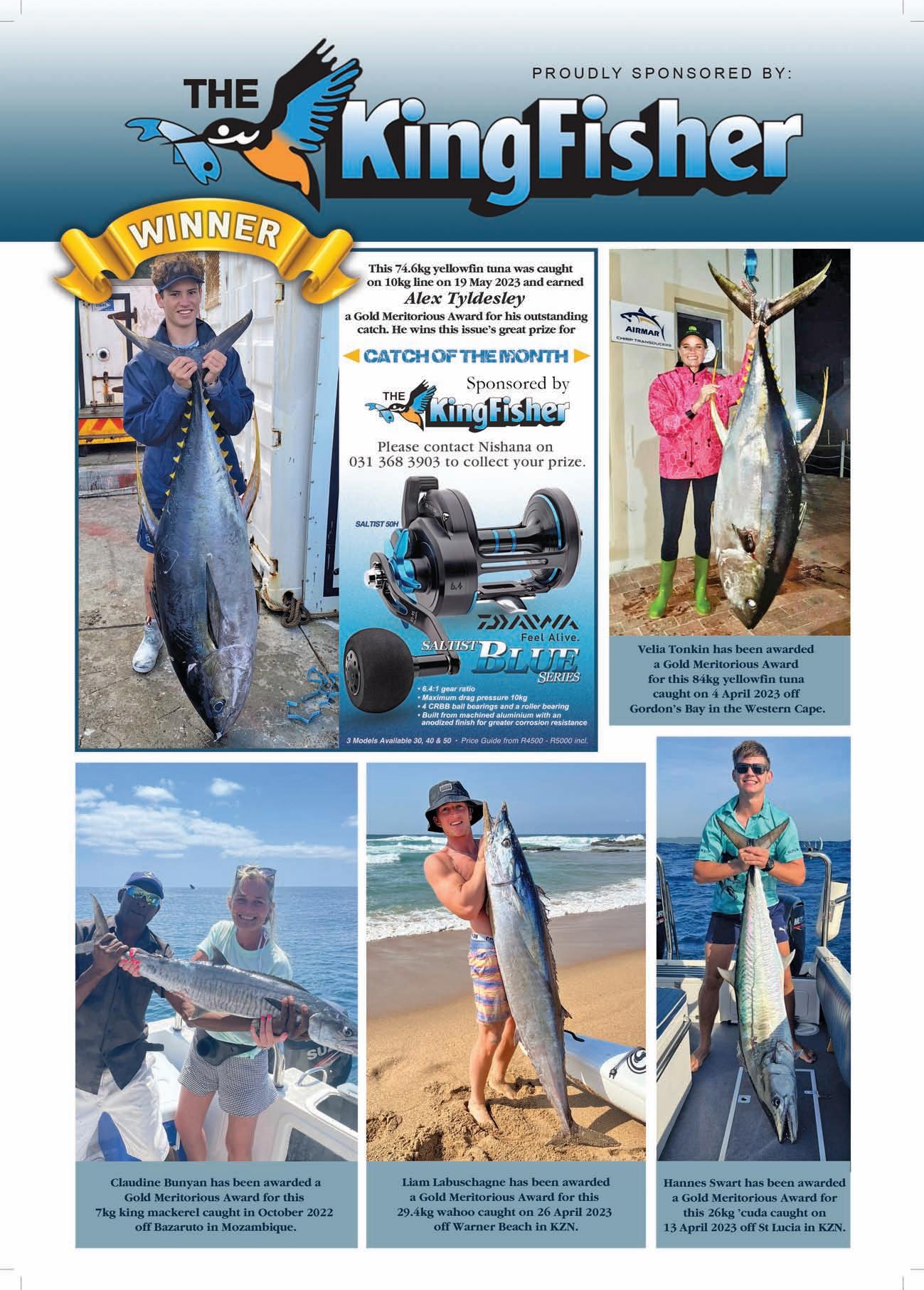
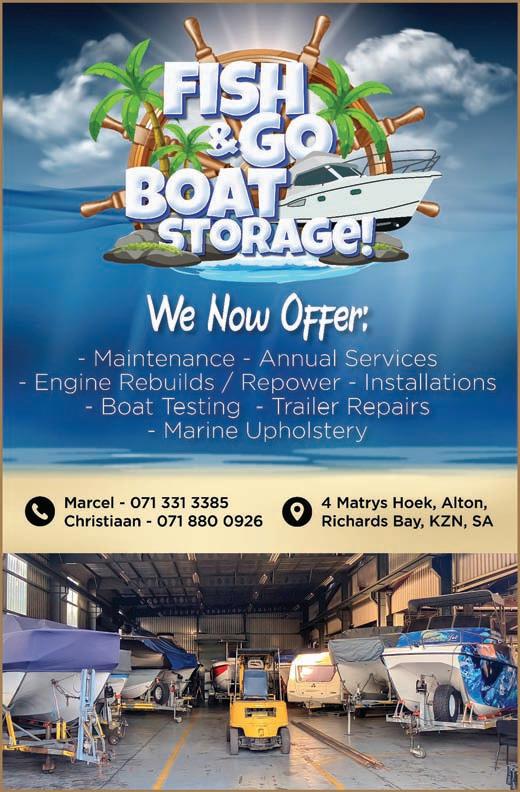

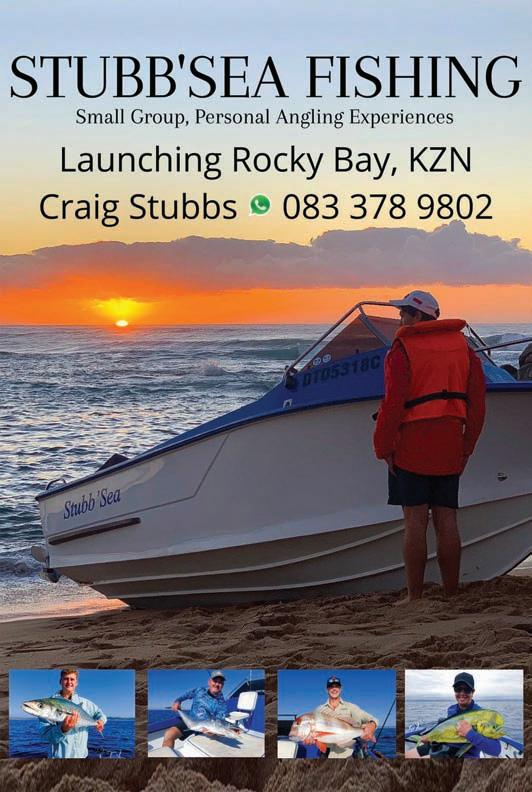
44 • SKI-BOAT July/August 2023
Part 2:Quarterly maintenance tips
By Craig Stubbs
IN the first article in this series,we looked at some tips and tricks on how to clean/maintain one’s boat after every outing.In this second part,we are going to look at what I like to call,quarterly maintenance.
If you are like me and do a thorough wash and once-over after every launch,this quarterly maintenance might only need to be done every six months.However,if you are one of those who doesn’t thoroughly clean your boat after every launch (of which there are many people),then you may want to do this more regularly.
The choice is yours,but I follow this routine every three months.It has served me well,and hopefully will do the same for you.
Here again,the purpose is twofold — firstly to maintain your vessel in the best possible condition,and secondly to force you to thoroughly inspect your vessel during this process so that any potential “bigger issues”may be identified timeously and taken care of before they become a big expense.
We are going to focus on paintwork,stainless steel and motor care during this quarterly maintenance,and once you
have the correct products and savvy,the whole process takes under two hours to complete.
To start with,give your boat a quick wash with warm water and soap to clean off any dust and dirt.
STAINLESS STEEL
Stainless steel is found all over a boat,from grab rails to rod holders to T-tops and more,and although it is a durable metal, it can still show signs of rust and pitting if it’s not maintained periodically.
Well maintained stainless steel shines beautifully and adds to the aesthetics of your vessel,and if it’s looked after,it will last you a lifetime.
Over and above merely cleaning it,going through each stainless component will quickly reveal loose bolts and mountings before they wear,break off or damage the fibreglass they are attached to.

SKI-BOAT July/August 2023 • 45
BACKTOBASICS
MAIN PHOTO ABOVE: Look after your boat and she’ll look after you. Noah Stubbs shows off a beaut of a ’cuda.
Before and after a quick application and clean. Cleaning this anchor bollard took no more than five minutes from start to finish and the results speak for themselves.
There is only one product I trust to clean my stainless steel work,and that is Autosol Marine Polish.It is available through a variety of hardware stores as well as online via platforms such as Takealot,and one tube lasts for roughly two applications,so if you are buying,consider stocking up with a few tubes so you don’t need to rush out to find more,when one starts running out.
I use a small portion of a rag to apply Autosol to larger surfaces,or a toothbrush for smaller pieces of stainless such as hinges etc.Simply apply a small amount with overlapping motions,allow a few seconds to dry and then give it a solid buff with a clean cloth.It’s quite amazing how this polish can transform old and dull metalwork in a matter of seconds,and it’s well worth the effort.
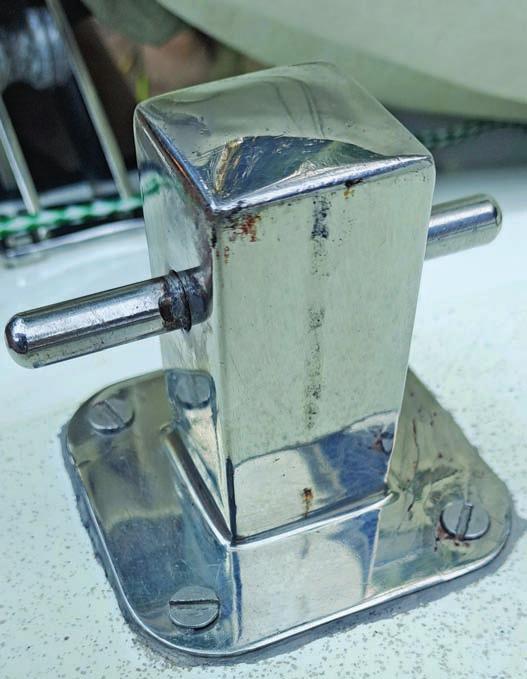
While going through your stainless,pay attention to bolts and fasteners.If they are showing signs of rust,rather remove them and replace them while you can,because once fasteners have rusted beyond a certain point they are very difficult to remove,and normally need to be either drilled out or cut out with an angle grinder,which is much more work than simply replacing them timeously.
Top Tip:
Not only is Autosol great for cleaning stainless steel,but it is also incredibly good at cleaning ingrained dirt and stains (such as rust drippings) on your fibreglass work.It is also fantastic at cleaning perspex wind-
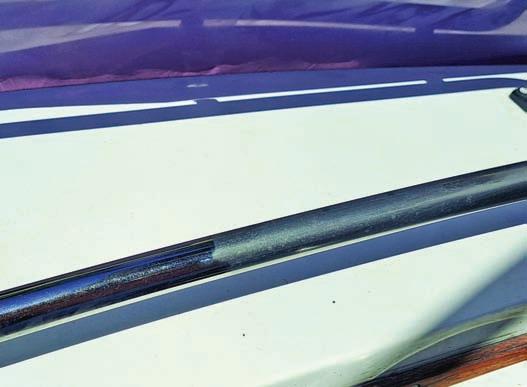
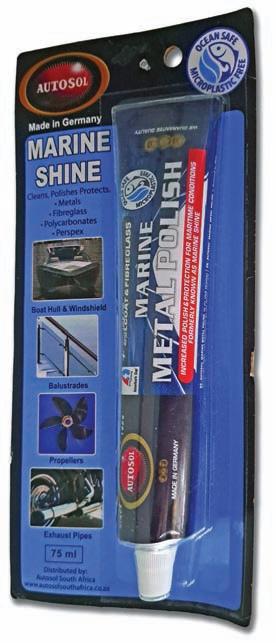
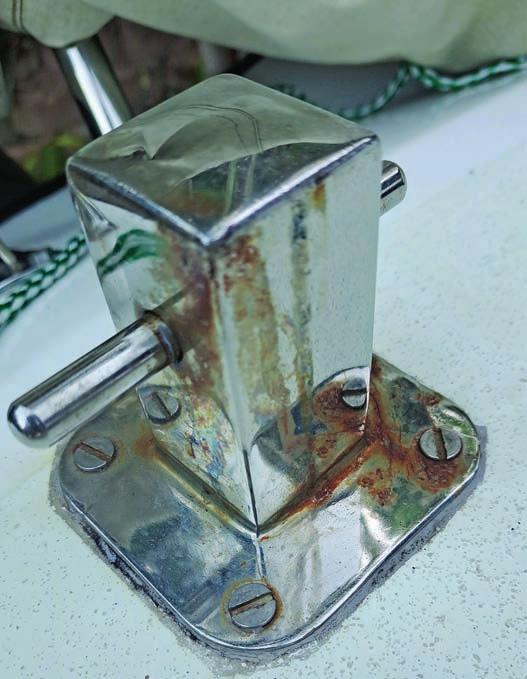
screens on the boat.Most people are blown away at how quickly one can transform sun damaged and faded windscreens to look like new within a few minutes.
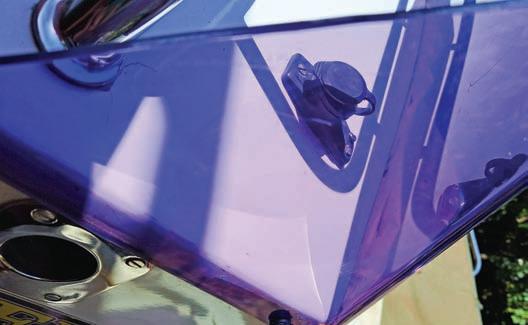
46 • SKI-BOAT July/August 2023
This
is the only product I trust to clean my stainless steel work.
An example of the difference a stainless polish makes. On the left hand side after a quick application, and on the right hand side, still dull and tarnished.
This perspex windscreen was old and faded, and look at it now.
PAINTWORK
Once your stainless steel is done,it’s time to start on the paintwork.
Gelcoat is a type of paint that most ski-boats are layered with in the moulding stage,and it is tough,relatively thick (in comparison to most paints) and has an extremely durable finish.However it too is prone to damage and wear over time, particularly from the sun and salt.If your boat has been “resprayed”during its life cycle,then that was most likely with a 2k or an automotive style paint,sprayed on with a spray gun,which is nowhere near as strong as gelcoat in the marine environment.Either way,with some care,one can extend the life of your boat’s finish.The best way to protect your paintwork is with a wax.
Before we move on,let’s quickly touch on the difference between a polish and a wax.A polish is a compound with micro particles that actually slightly abrades the surface of your paintwork to reveal a “fresh”layer of paint thereunder, leaving it looking fresh and vibrant.
If your paintwork is old and faded,then a polish is definitely on the cards,but this falls under annual maintenance for me,and we’ll cover that later.For now,were going to presume that your paint finish is in decent condition and requires protection rather than a full blown overhaul.
I’ve tried everything from “purpose-formulated”marine and boat waxes which are mostly imported and very expensive,to automotive products,and have settled on Turtle Wax Hard Shell Wax.I find it is well priced and very effective.It is available via Takealot and a few retailers.
The wax,once applied,provides protection for your paint,
“seals”it against the elements,and really does make washing much easier.Old bait,blood and dirt is far less likely to stick to well-waxed paint that it does to an old porous surface. Wax is easy to apply by hand,but a few tips should make it easier for you:
•Never apply wax in direct sunlight or on a hot surface as it will dry almost instantly and is then very difficult to remove.Park your boat in the shade or do this task early in the morning before the sun reaches any meaningful effect.
•Don’t wax your whole boat and then return to where you started to rub it off.It will dry hard and,again,become extremely difficult to remove.
•Use one cloth to apply and a second cloth to buff.If the buffing cloth becomes clogged,switch to a fresh cloth.
•Best practice is to apply with a damp applicator pad or cloth,one panel or smallish area at a time,allow it a minute or so to form a haze,and then,with a clean cloth, give it a quick buff.
If you follow the above rules,it’s a quick and simple process and you can do an average 19ft vessel in under half an hour.Waxing your boat forces you to pay attention to every nook and cranny,and again allows you to identify potential problem areas before they become a real issue.
Top Tip:
Do not wax a dirty boat,or the dirt particles will scratch your paintwork or become embedded in the drying wax.Always give your boat a wash first — preferably with warm water which really cuts through dirt.
These motors are far from new, with many hundreds of hours on them, but with care and maintenance, they still look like they’ve just been fitted.
OUTBOARD MOTORS


By now your boat has been washed,waxed and the stainless polished,and it should be looking in showroom condition, but let’s not forget about the outboard motors.Replacing them is extremely expensive,and of course we rely on them to keep us safe on the water,so they need maximum care and attention,both for performance and to ensure longevity.
For the quarterly maintenance,start by running your outboard motors for a few minutes with ear muffs in order to warm them.Once they’re warm,remove the cowlings and give them a spray down with a fine mist setting and moderate to low pressure with your hosepipe.
Now,with the cowlings off and the ear muffs back on,run them for a few more minutes.This will warm and dry them again,and will allow you to listen for any knocks,vibrations or strange noises.Leave the cowlings off,and give them an inspection.Keep a look out for damaged or worn wiring and any rust forming and,in general,anything that seems out of the ordinary.
Once they’re dry,you want to add some sort of protection to your motors.This is a contentious issue,with varying opinions,from off the shelf rust inhibitors to silicon sprays to
brand name motor care aerosols that can get pretty expensive.
I use a very simple and “old school”,albeit quite messy, solution that I find works incredibly well.I fill a one litre spray bottle with 500ml motor oil,and 500ml liquid paraffin.The paraffin thins the oil to allow a fine spray.I spray this solution liberally all over the power head,allowing it to form a protective layer as the paraffin evaporates leaving behind the oil residue.
I also spray it on my cowling,motor legs and gearbox.I then lift the motors and spray it on the trim tubes and into any hard to reach,out of the way places.
As I said,this is a bit of a messy process,but it works wonders in protecting one’s assets.After a few minutes I give the motors a quick run just to check that they are firing nicely, and then I replace the cowlings.
Lastly,if need be,I grease my steerer tube and any friction points that need greasing.
The whole process from beginning to end takes only a few hours,but if you are organised,and have the correct (limited) equipment that you need,it is quick and painless,and really is worth the effort.
SKI-BOAT July/August 2023 • 47
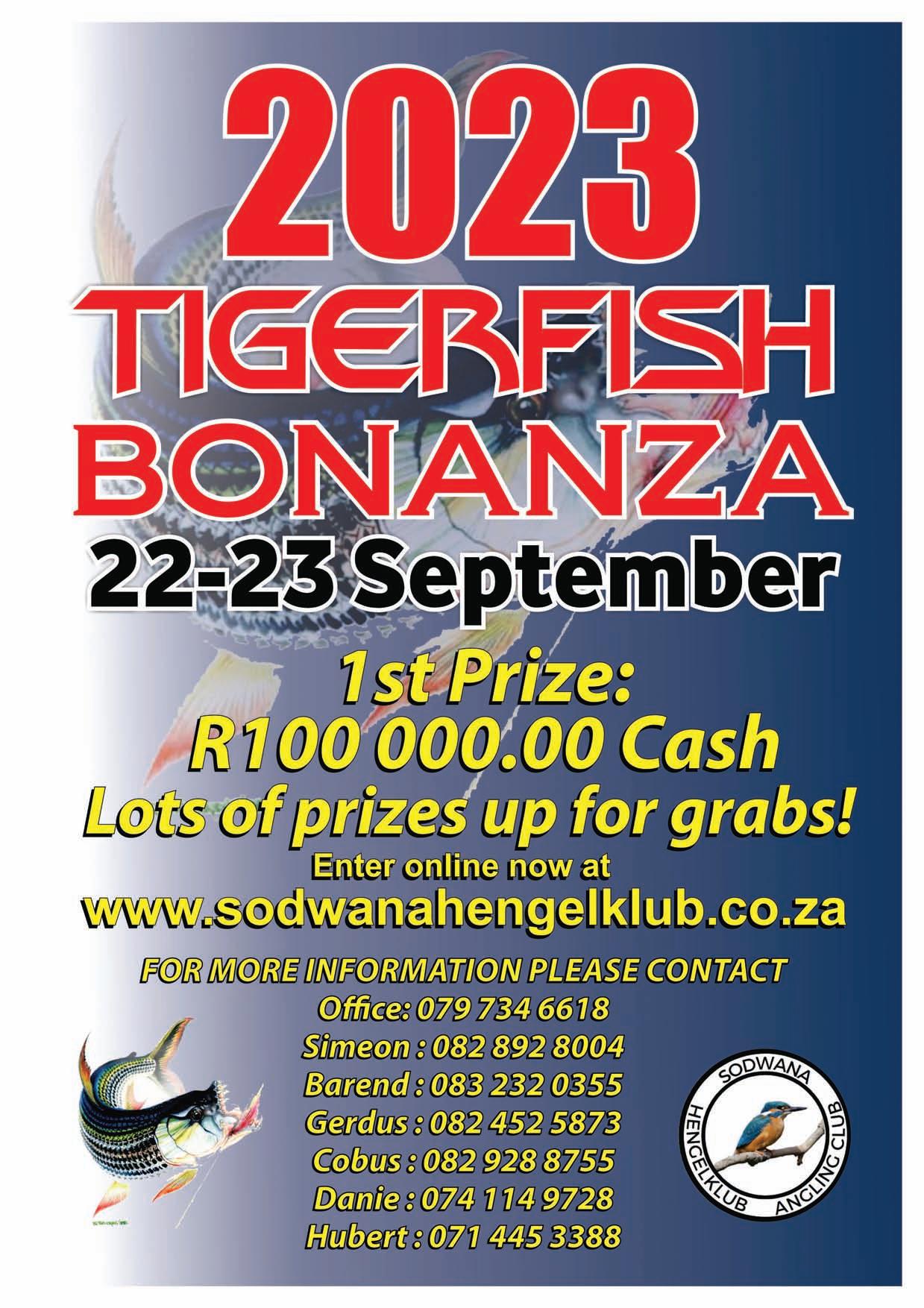
THE long and winding road to obtaining Protea Colours takes different turns for every individual,but the end destination is equally exciting,emotional,and overwhelming for all.
The golden phone call from Chris Schorn,the SADSAA President,after the team selection meeting of the national selectors,is certainly one that each of the Protea Team members selected for the South Coast Blue Marlin Open Tournament in Kenya,will cherish as a super special milestone.

It was the first Protea cap for all four of us — Gavin van der Merwe (Captain),Clinton Good,Wessel Grimbeek and Mariëtte Hendriksz.No doubt that fact raised eyebrows among some of our peers,but we grabbed the golden opportunity with both hands and made it count! We had a lot to prove — not to ourselves,as we were confident in our abilities and aware of our shortcomings — but to the selectors and other anglers,to show they made the right choice in selecting us…four new caps.

The day our team was announced was only 42 days before the start of the tournament,so we had our jobs cut out to arrange flights,accommodation,charter boats for practice days,visas,vaccinations,clothing,and a capping ceremony and send-off function.
In preparation for our first meeting, we studied the tournament rules and scoring system of the South Coast Blue Marlin Open tournament.The selectors managed to put together a diverse team who had experience with gamefish, sailfish,striped marlin,black marlin, blue marlin,spearfish and broadbill swordfish,as all these species were worth points,with the billfish being the main target group.
Blue marlin was not the predominant target species,but rather the jackpot species,being worth the most points by a considerable margin.The line class was open up to 80lb which allowed anglers to use light tackle for the gamefish and sailfish which we thought would account for the bulk of the catches.At the same time we had to keep in mind that although they would
Fishing the South Coast Blue Marlin Open
By Mariëtte Hendriksz and Gavin van der Merwe
be less common at that time of year (mid-March),the blue marlin are always around and would be the game changer in terms of scoring maximum points.
We had to prepare for the “bread and butter”fishing to keep the scoreboard ticking,combined with the more conventional,focused marlin fishing which resulted in us taking along quite a diverse range of tackle to give us the best chance of success.
We had a splendid sendoff evening at East Rand Boating Club that was well attended by our friends,family,and fellow anglers from all over the country,as well as SADSAA and SASSAC delegates, and at 10pm that night we headed for the airport to start our adventure...
When we arrived at Ukunda Airport just outside Diani,Kenya,we were welcomed on the airstrip by the secretary
and treasurer of Diani Sport Fishing Club with a cameraman to record the occasion and snacks and drinks to enjoy.We were treated like,and felt,like royalty.The Kenyans truly stunned us with their overwhelming hospitality and attention to detail.
Diani Beach is a hidden gem,ideal for both fishing and family holidays, with breathtakingly beautiful beaches and reefs.It is not commercialised but boasts incredible infrastructure for such a small town,from a modern hospital to shopping centres and plenty of entertainment.The highlight for us,of course,was the lovely Diani Sport Fishing Club situated right on the pristine beach front.
We were blessed with great accommodation that really felt like home as we had the place to ourselves.We even
SKI-BOAT July/August 2023 • 49
COMPETITIONS
Wessel Grimbreek, Mariëtte Hendriksz, Gavin van der Merwe (Captain) and Clinton Good
had the South African flag set up permanently to mark our turf,as if tackle being stacked all over the couches and dining room table wasn’t enough.
Our approach to the tournament was to start off by learning from the local guys.We didn’t take any of our tackle with on our first practice day and only about half on the second day to try some ideas.We then combined what worked for the locals and blended it with our own gameplan after getting a good feel of the ways and means of Diani.
We used a blend of heavy and light tackle which we managed to run effec-
tively at the same time,even when another competing angler told us that wasn’t possible.From the third practice day we took all our own gear and ran our own spread.
Our first practice day was booked with Diani Sport Fishing club’s Chairman,Raymond Matiba from Shuwari Sportfishing Charters,on his 33ft Bertram, Shuwari
That day we noticed loads of dead, fresh squid floating on the surface in the main fishing grounds.This is where we raised the majority of the fish,but just weren’t committing to the lures. The fish had such a vast array of dead
food available to them,that getting a fish in feeding mode and enticing a bite on lures with a boat moving at 6-7 knots was extremely difficult.The fish we managed to get were mostly in areas away from all the dead squid.
The only livebait we noticed were relatively small flying fish and sardines, so that took livebait fishing off the table as an option.
Nevertheless,Wessel broke the ice and released a black marlin early on the morning of our first practice day.We had plenty of lazy action from other billfish in the spread,but none would commit.The fishing looked promising,

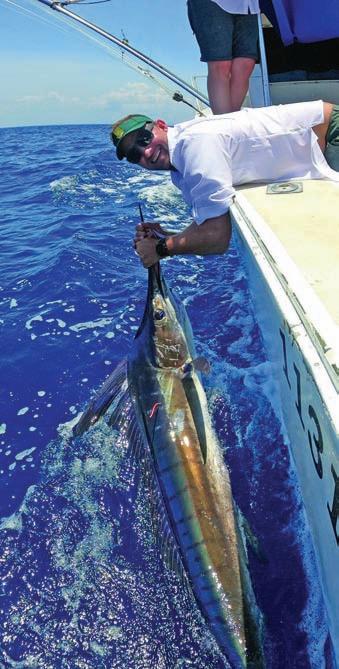
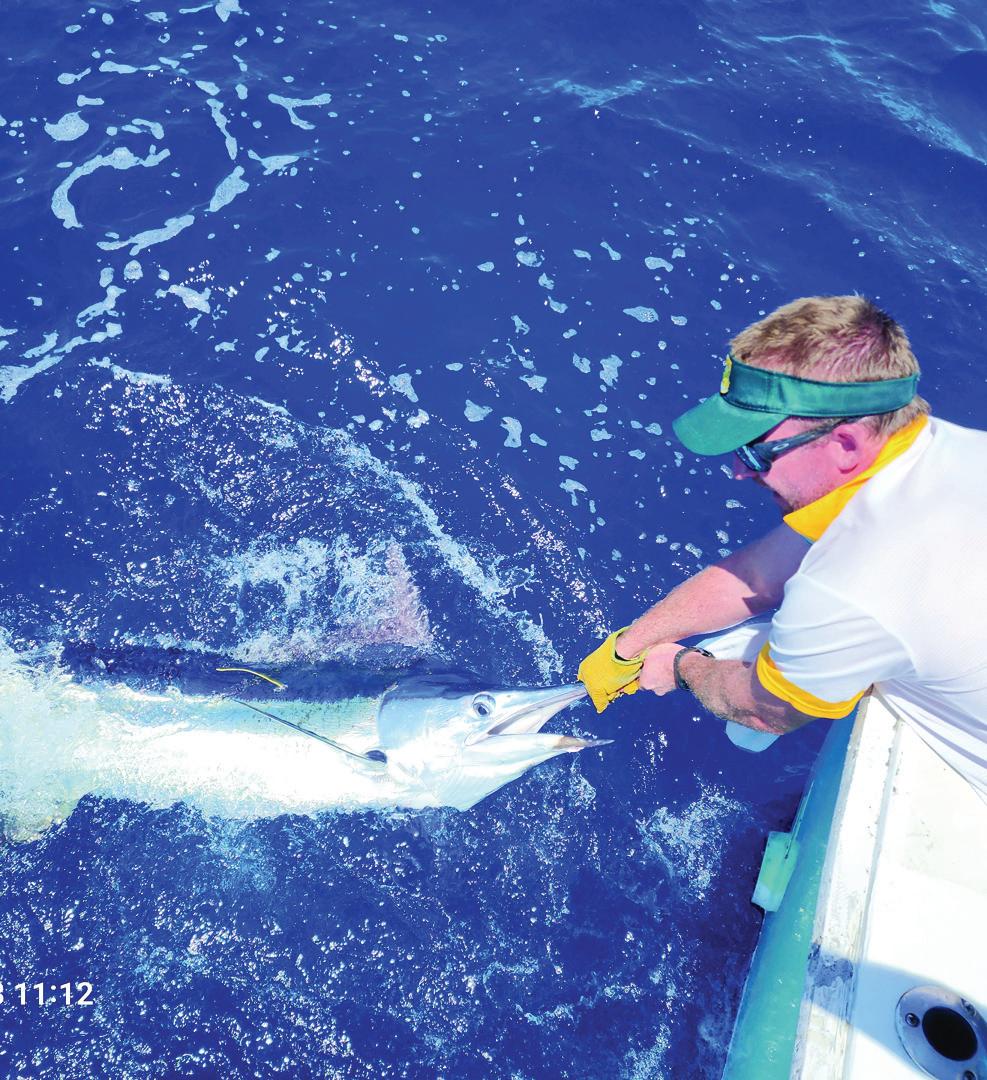
50 • SKI-BOAT July/August 2023
A marlin tagged and ready to go.
Another successful billfish release.
Smiles all round as our Proteas strike a pose after the first practice day of fishing.
and we were stoked!
Our second practice day was spent on Phil and Linda Caters’ Virpra 1 ,a 34ft Luhrs.
Mariette released a sailfish on light tackle with a circle hook rig and we were pleased that our gameplan was working like a charm so far.We missed another sailfish and saw two striped marlin in the spread but they showed little interest.
Our third and last practice day was once again onboard Shuwari with Captain Raymond.Gavin released a striped marlin that day and we missed another.Unfortunately,the fishing got increasingly difficult as the week progressed,and we started seeing less and less fish.The annual change in season was also in full swing.
Kenya’s fishing seasons are governed by two major winds,the Kusi and Kaskazi.The Kusi,or south-east monsoon,blows from late March until November,while the Kaskazi typically starts mid-December when the winds change to the north-east.In our case, the Kusi started early and,combined with all the dead bait,had a massive impact on the bite.We also had water temperatures in excess of 30°C which no doubt contributed to the non-aggressive way in which the fish were feeding.
After a full day of tackle preparation and fine tuning our gameplan,we attended the opening function at the club where we met up with the other teams for the boat draw and briefing. We were in for very long days of fishing as we started fishing at around 06h00 and had lines up at 16h30 on each of the tournament days.
On Day One of the tournament,we were welcomed onboard B’s Nest ,a 35ft Bertram,with the well-known Captain Ali Al-Harazi in charge.That day Clinton hit the jackpot and released the prized blue marlin we came for.We also filled up our quota of dorado to add some valuable extra points.
On Day Two we were onboard Virpra 1 once again.Mariette released a nice sailfish,and we filled up on our quota of dorado again.Gavin also added a big wahoo to the mix for some welcome extra points which put us top of the leaderboard.
On day three we were onboard Shuwari,and Captain Raymond and the team pulled out all the stops to try and keep us in the lead.By this time it was no secret that we were the favourite team both on and off the water.The Kenyans enjoyed us every bit as much as we enjoyed them.

On the Sunday morning we were greeted by a rather intense rainstorm with thunder and flashing lightning threatening to end the competition prematurely.We persevered,though,and pushed through the intimidating condi-
tions and managed to get a nice bull dorado but no billfish.
We only saw one striped marlin that day day.It felt like the longest day we’d ever spent on the water.Every time the radio made a sound,our anxiety levels increased drastically and we all pricked up our ears.We knew the Azorean team could take us out of first position if they released a blue marlin,since they had released a striped marlin on day two and would get bonus points for a second marlin release of the tournament,which we didn’t have.
Captain Raymond counted us down to 16h00 which marked our victory.It
TOPTHREE TEAMS
South Africa
Azores
England
1 584.9 points
613.8 points
402.5 points
was a goosebump,tear-filled moment for each of us as we raised the SA flag and took a photo to commemorate the moment.As we walked across the beach to the clubhouse,we were welcomed as the champions with loud cheering and clapping from the other competitors and the audience that had gathered at the clubhouse — another moment that will be burned into our memories forever.The competition was officially closed with a skydiver landing on the beach in front of the clubhouse, holding a Kenyan flag.
As the chairman of the hosting club, Captain Raymond duly announced us as
SKI-BOAT July/August 2023 • 51
South Africa takes first place.
the winners and added that we were his favourites and that he was extremely pleased that we took the gold.It was a humbling,exhilarating moment which filled each of us with so much pride that no words can accurately express what we felt.
As the winners,we earned an entry to the 2024 Offshore World Champion-
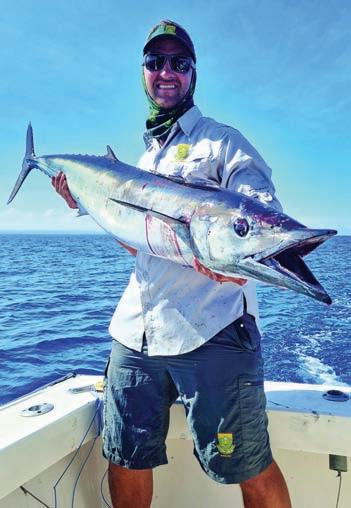
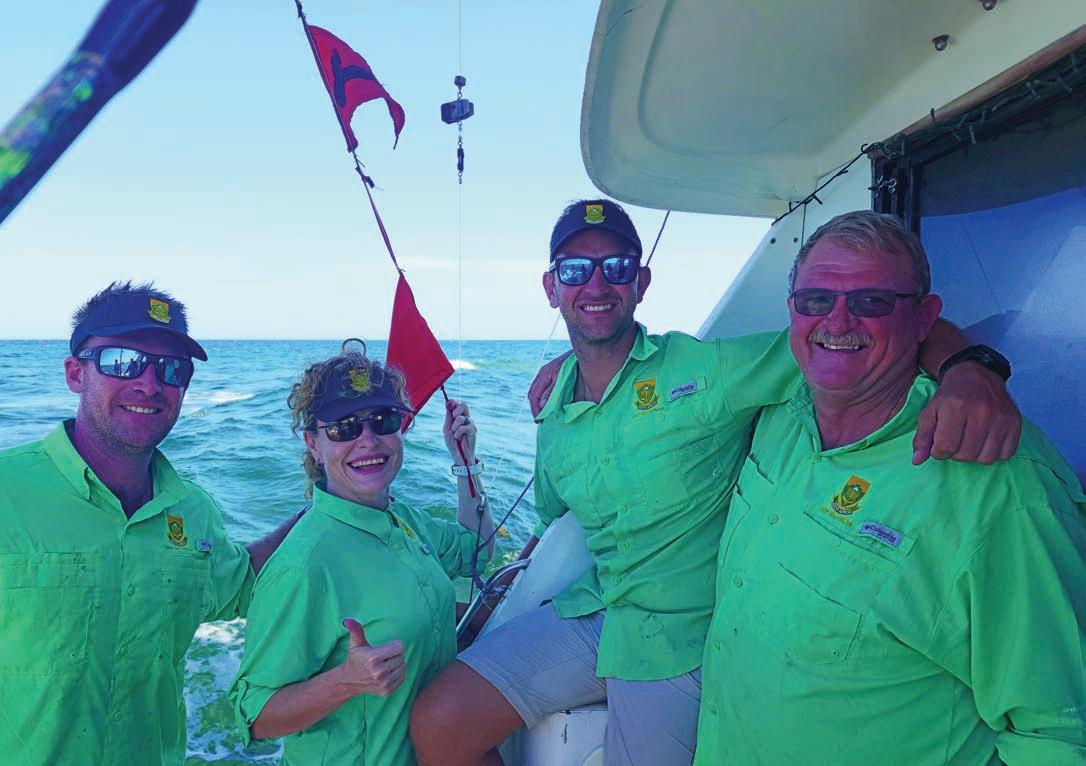


ships held annually in Costa Rica,along with more awesome prizes which came as a total surprise.We were fishing for a title and possible medals,so with the extra prizes we had to get really creative in packing our luggage to stay within the weight limitations.
None of us could have handpicked a better team even if we’d been given the
opportunity — four competent anglers, no egos,strong Christian values,team players and friends for life!
We would like to thank SADSAA, Gauteng,Southern Gauteng and Mpumalanga,our various clubs,friends, family,and supporters that made this an unforgettable experience for each one of us.
52 • SKI-BOAT July/August 2023
Captain Gavin holding a beautiful dorado.
Gavin showing off a wahoo.
The team celebrating another release that added points to the tally.
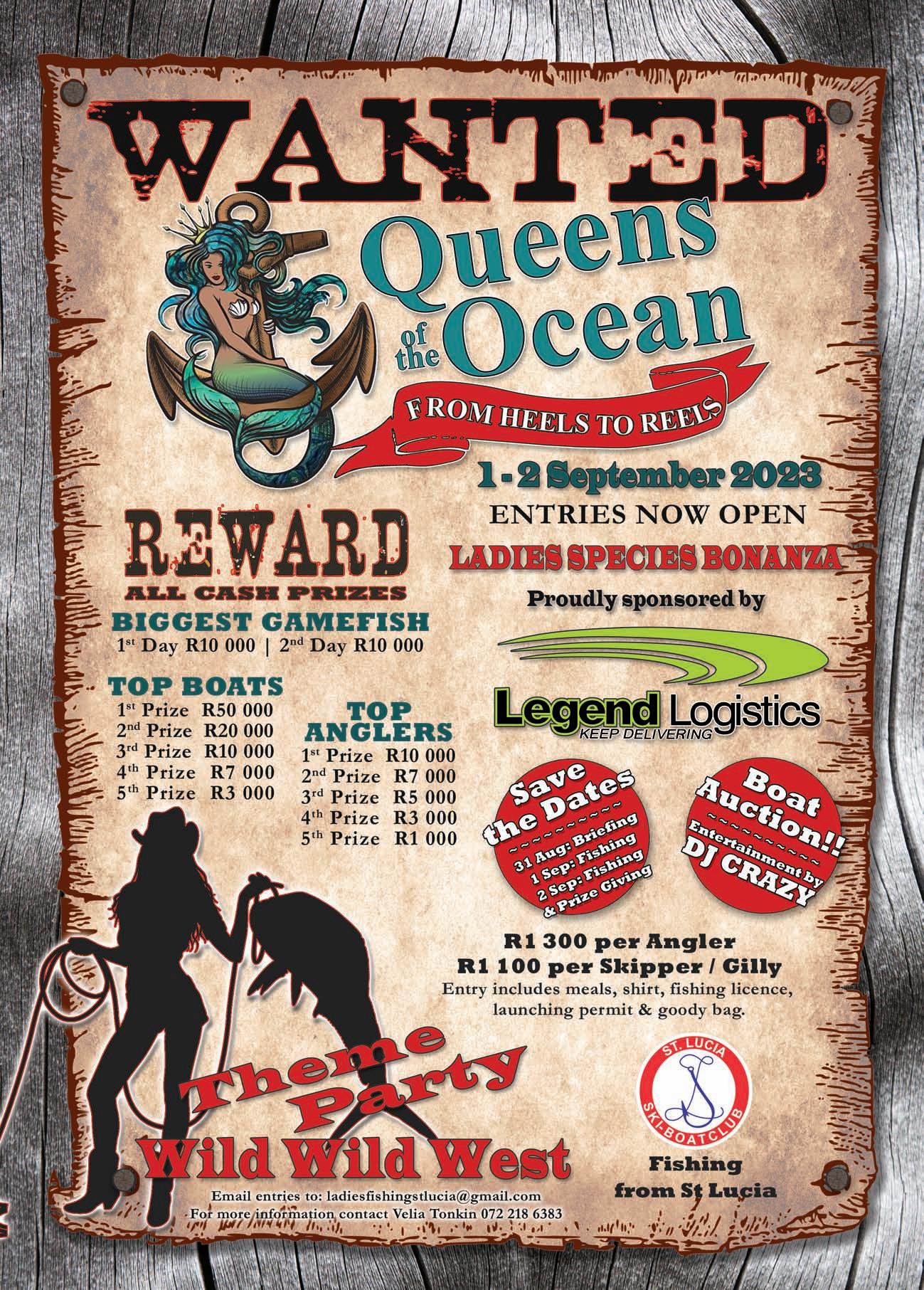
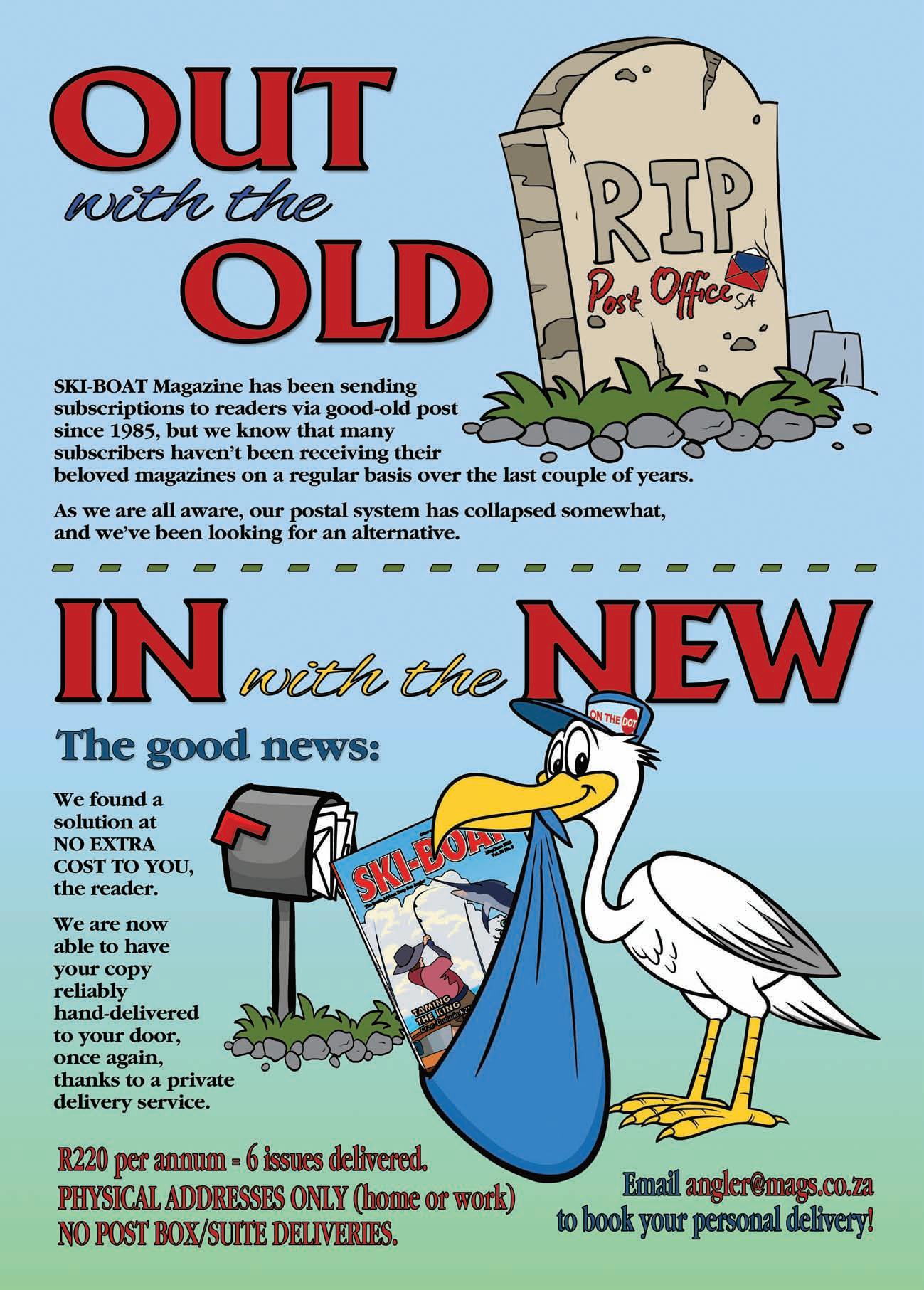
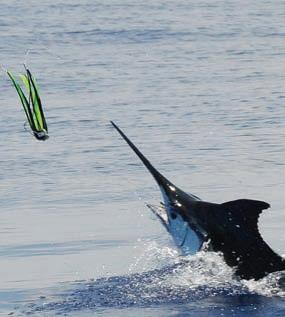
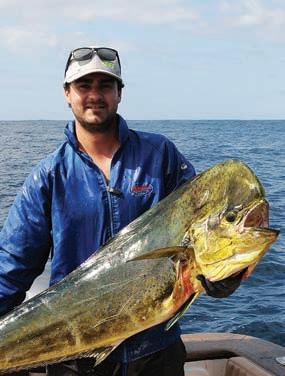





All about action! All about fishing! WINNERS: SKI-BOAT July/August 2023 • 55 1 YEAR — 6 ISSUES R 2 7 0 Yes! Enter my subscription to SKI-BOAT Magazine I save 18% on the newsstand price! 1 Year (6 issues) only R220.00.Save R50.00! New subscriber Existing subscriber ALSO AVAILABLE AS AN E-ZINE. Get your FREEdigital subscription at www.issuu.com Name .......................................................................................................................... Physical Address .............................................................................................................. .................................................................................................................Code:............... Telephone .................................................(Home) ..................................................(Work) Cell.............................................Email Address................................................................. Payment options: Direct deposits or EFT Unfortunately due to postal issues beyond our control we are no longer accepting international subscriptions for the paper version of SKI-BOAT However anyone is able to access the digital version for free on www.issuu.com SAVE BANKING DETAILS FOR DIRECT DEPOSITS OR INTERNET PAYMENTS (eft) A/C Name: Angler Publications • Bank: First National Bank • Branch: Durban North • Branch Code: 220426 • A/C Number: 50790026585 Please email proof of payment and address details to <angler@mags.co.za> Now R220,00 Three lucky subscribers will each win a full year’s subscription to SKI-BOAT magazine, valued at the newsstand price of R270. This means, should you subscribe and win, you will receive your next year’s subscription ABSOLUTELY FREE! Subscribe to between 1st July 2023 and 1st October 2023 and win YOUR NEXT YEAR’S SUBSCRIPTION ABSOLUTELY FREE! FREE DIGITALE-ZINE ONWWW.ISSUU.COM All about boats! Congratulations to the following lucky subscribers who have each won a year’s extension of their subscription ... Steven Lawlor from Kirstenhof, Johan Malan from Germiston and Butch Pike from Howick. ENJOY!
CATCHINGMYFIRSTBIGTANK
by Fransien Myburg (13)
IN the July school holidays last year I had a wonderful experience catching my first big tuna in St.Lucia! It weighed 15kg,and it was huge for me.

Our family go fishing on our boat,Aqua Joy,and that morning we were on the beach at 6am ready to fish. When Wiseman pushed us into the surf,I thought,”Big fishes,here we come!”When we were behind the backline,busy catching livebait,we called Uncle Barend (the second best fisherman in St.Lucia — obviously I am the
best) to ask him he thought it was a good idea to go to Chesa.He said it was a very good idea because he’d caught big fish there over the past few days.
We started slow trolling with livebait to Chesa,but with no success.Then we started trolling with X-raps which always seem to work if our other plans don’t work.We trolled for about an half hour,and then the first fish was on.I was so excited!
I immediately took the fishing rod and started fighting the fish! My mother always says “Practise makes perfect”, and I’d practised weeks and weeks before this holiday to get strong so that I could fight the big fish by myself.I fought the fish for about ten minutes and then it was on the boat.I was super proud of myself!
There was a great excitement on the boat,and after we landed my fish,my brother caught a tuna and my sister caught a dorado.It was a great day on the sea and a wonderful experience that I’ll never forget!

CITIZENSCIENCEATITSBEST
Impact of the ORI Cooperative Fish Tagging Project
By Gareth Jordaan and Bruce Mann
ONE of the earliest fish tagging projects started in the mid1800s when Atlantic salmon were tagged by means of fin clips and by attaching pieces of wire to their tails and jaws with unique labels.
Closer to home,many tagging projects have been initiated in South Africa, but few yielded tangible results,with much of the data being unpublished or unused.During the 1970s,ORI’s Rudy van der Elst recognised the value of fish tagging information and involving the angling public in the collection of such data,subsequently establishing the ORI Cooperative Fish Tagging Project (ORICFTP).
The project was formally started in 1984,with the aim of enlisting active angler support in tagging specific marine fish species around the entire southern African coastline.Still in operation over 38 years later,this project has become one of the longest ongoing operational citizen science projects of its kind in Africa.

Over the years,different types of tags have been used and these have gradually been improved,as have the tagging methods.Today,the main types of tags used in the project are dart or “spaghetti tags”supplied by Hallprint in Australia.
Technology has also vastly improved
over the years,allowing for easier reporting and collection of data,and for the data to be housed on a large online database,rather than hand-written and recorded into a logbook,as was done in the early days of the project.
As an added bonus,the project has also been able to improve the methods of fishing and fish handling used by tagging members.From the types of hooks used (we suggest using barbless circle hooks rather than barbed J-hooks or treble hooks),to the way fish are landed and handled fish (using a wet cloth over the eyes,landing the fish on a stretcher or using a knotless landing net,and keeping the fish in fresh seawa-
SKI-BOAT July/August 2023 • 57
SCIENTIFIC
Graham Pollard and his son, Aiden, with a tagged giant kingfish nearly ready for release.
ter as much as possible),to methods of safely releasing fish,especially those caught in deep water and suffering from barotrauma,the project has helped change anglers’thinking and methods.
Over the 38-year duration of the project,a veritable goldmine of data has been collected which has led to some incredible results and achievements. Over 7 000 anglers have joined the project,with some of the original members still remaining active to this day,including Bruce Mann,Charles Lilford,Derick Stemmet,John Rance,Nic de Kock and Riekert van Heerden.
It has been very encouraging to see how the ORI-CFTP has gained popularity more recently,with more anglers becoming aware of fish tagging and wanting to join the project.Currently
there are about 483 active members (anglers who tag at least one fish in a year) and an average of 183 new members who join each year.2021 was a record year for the project with more than 380 new members joining.
With more anglers joining the project,more fish are being tagged each year.On average there are about 9 613 fish tagged each year.Since the start of the project an incredible 374897 fish have been tagged and released.
Although the total number of fish tagged is impressive,the number of tagged fish recaptured is even more important,as it is the recapture data that allows scientists to calculate things like fish growth rates and movements patterns.
We continually remind our tagging members that it is not about the num-
CAUGHTATAGGEDFISH?
Remember that if you catch a fish with an ORI tag in it, please report it by calling or WhatsApp +27 79529 0711, emailing <oritag@ori.org.za>, or submitting the data online at <www.oritag.org.za/recapture>.
For recapture data to be useful, we need to know the unique tag number, the species of fish, the date it was caught, the exact locality and, if possible, the length of the fish. Also please specify the type of length that was measured (i.e., total length, fork length, precaudal length or disk width) and whether the fish was kept or re-released.
ber of fish they tag,but rather the importance of the species they tag (based on our priority species list),the manner in which they catch,handle and tag their fish,and the frequency with which tagged fish are recaptured.
Overall,there have been more than 23600 tag recaptures (about 6.3%) since the start of the ORI-CFTP,with an average of 605 tag recaptures each year. Importantly,the recapture percentage has continued to increase over the years,suggesting that,besides there being more tagged fish in the ocean increasing the chances of catching a tagged fish,members are catching,handling,landing and tagging their fish in a more responsible manner.It is also possible that there has been an improvement in the reporting of recaptured tagged fish.

Over the years we have had some incredible recaptures reported to us, such as a raggedtooth shark that was at liberty for more than 26 years,a red steenbras that was at liberty for more than 25 years and a Roman that was at liberty for more than 22 years.
The Roman recapture is a prime example of just how useful tag and release projects can be.Roman were originally thought to live to a maximum age of 19 years,based on counting growth rings in sectioned otoliths,however,when this Roman was recaptured after 22 years at liberty,it proved that they can live longer than that.
This recapture also highlighted how slow growing this species is,with the fish having grown only about 20cm in just over 22 years.The fish was recaptured in the exact same spot that it was originally tagged,proving again how resident Roman are.
It’s even more exciting when recaptures are reported to us further afield than South African waters.For example, a yellowfin tuna originally tagged off Cape Town was recaptured in Seychelles,and a black marlin that was tagged off Sodwana was recaptured in Tanzanian waters.

Members of the ORI-CFTP originally tagged fish all along the entire southern African coastline,from Namibia to Mozambique.However,in the late 1990s the Namibian authorities asked ORI tagging members to stop tagging fish in Namibian waters as they were starting their own national tagging project.Similarly,the Mozambican fisheries authorities have requested that only migratory gamefish species be tagged by ORI tagging members in Mozambique waters.
In South Africa,the Western Cape has the most tag releases and recaptures,followed by the Eastern Cape and KwaZulu-Natal.Several scientific fish tagging and monitoring projects around our coastline — particularly in some of our marine protected areas (MPAs) such
58 • SKI-BOAT July/August 2023
as DeHoop,Tsitsikamma,Pondoland, Dwesa/Cwebe and iSimangaliso — have also contributed significantly to the number of fish tagged and recaptured.
These projects have also played an important role in improving our understanding of the movement patterns of various linefish species and have shown just how important our MPAs are in helping to conserve many of our more resident linefish species.They have also proved that healthy fish populations within MPAs can spill over into adjacent fished areas,thus helping to ensure sustainable fishing.
Overall,375 different species have been tagged in the ORI-CFTP.The galjoen (South Africa’s national fish) has the greatest number of tag releases, with over 72000 having been tagged since 1984,and more than 5 300 recaptures (making up 21% of the total recaptures overall).
Gathering tagging data on so many different fish species over such a long time has allowed us to make this information available to numerous scientists and students who have used it in their research projects and theses.This has also resulted in many scientific publications in peer-reviewed journals which are critical to improving fisheries policy and management.
For example,some recent scientific publications have looked at the movement patterns and growth rates of various linefish species such as the critically endangered giant sandsharks,cavebass,catface rockcod and Scotsman.
The data collected by the ORI-CFTP has provided important baseline data for movement studies on numerous fish species.Using conventional external dart tags,you know where the fish is when you tag it,and you know where it is if you recapture it,but you have little idea where it has gone during its time at liberty.

Excitingly,this gap in our knowledge can now be filled using more sophisticated methods of tagging such as acoustic telemetry and satellite tagging (see https://saiab.ac.za/platforms/ acoustic-tracking-array-tracking/) which is producing some truly fascinating results.
The recent results from acoustic tagging of giant kingfish (Caranx ignobilis) and their amazing annual spawning migration to southern Mozambique is a fine example and you can read more about this at DOI:https://doi.org/ 10.3354/meps12975.
In addition to pure fish research,the ORI-CFTP has helped to improve the cooperation between anglers,managers and scientists,and has also helped to change the conservation ethics of marine recreational anglers in South Africa towards catch-and-release fishing.
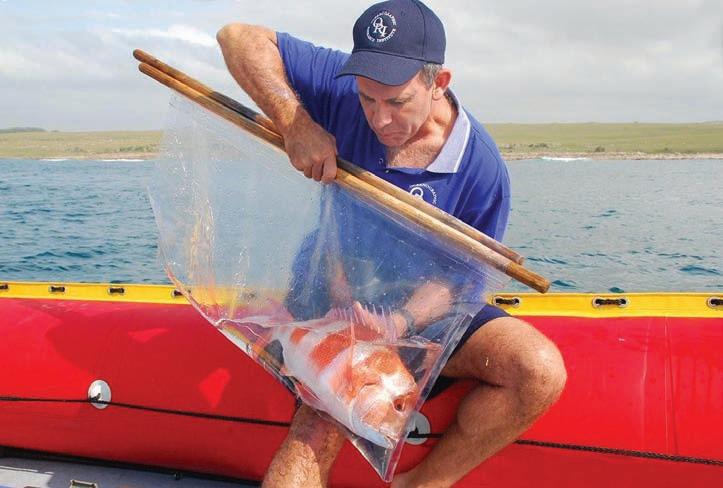
In 2021,a survey of ORI-CFTP members was conducted with the aim of critically assessing the contribution that the project has had on the marine recreational angling community in South Africa.Some of the comments from this survey are quoted below and show just how much this project means to,and has encouraged,anglers around the country.
“Without any doubt,the concept of tag and release has encouraged the release of more fish.”
“The Tagging Project,more than any other initiative,has engendered a spirit of conservation in South Africa.”
“I joined the Tagging Project during its year of inception,when I was 18 years old.I remain a proud member of the project.I hope to be a member of this project for many years to come.”
To read more about this assessment visit https://doi.org/10.2989/ 1814232X.2022.2126525
Anglers who’ve joined the project
learnt about tag and release,gained a better understanding of the movement patterns and growth rates of many of our linefish species and the value of sustainable fishing,and ultimately contribute towards the improved conservation and management of these species.
We thank all the anglers who have joined the ORI-CFTP over the years and helped this project grow from strength to strength.Without your support and tagging efforts,this great achievement would not have been possible.
For further information follow ORITag on Facebook and Instagram and visit the SAAMBR YouTube channel <https://www.saambr.org.za/ori-tagrelease/> to view ORI-CFTP instructional videos.
FURTHERREADING...
Daly R, Filmalter JD, Daly CAK, Bennett RH, Pereira MAM, Mann BQ, Dunlop SW, Cowley PD. 2019. Acoustic telemetry reveals multi-seasonal spatiotemporal dynamics of a giant trevally Caranx ignobilis aggregation. Marine Ecology Progress Series 621: 185-197. DOI: https://doi.org/10.3354/meps12975
Mann BQ, Dalton WN, Jordaan GL, Daly R. 2023. Movement patterns and growth rate of Scotsman Polysteganus praeorbitalis (Family: Sparidae) tagged in the Pondoland Marine Protected Area, Eastern Cape, South Africa. African Zoology 56(1): DOI: 10.1080/15627020.2023.2170717
Mann-Lang JB, Mann BQ, Jordaan GL, Daly R. 2022. Assessment of the impact of participation in the Oceanographic Research Institute’s – Cooperative Fish Tagging Project on angler attitudes and behaviour. African Journal of Marine Science 44(4): 299-309, DOI: 10.2989/1814232X.2022.2126525

SKI-BOAT July/August 2023 • 59
Two more fish being carefully handled and assessed before being tagged and released in the Pondoland MPA.
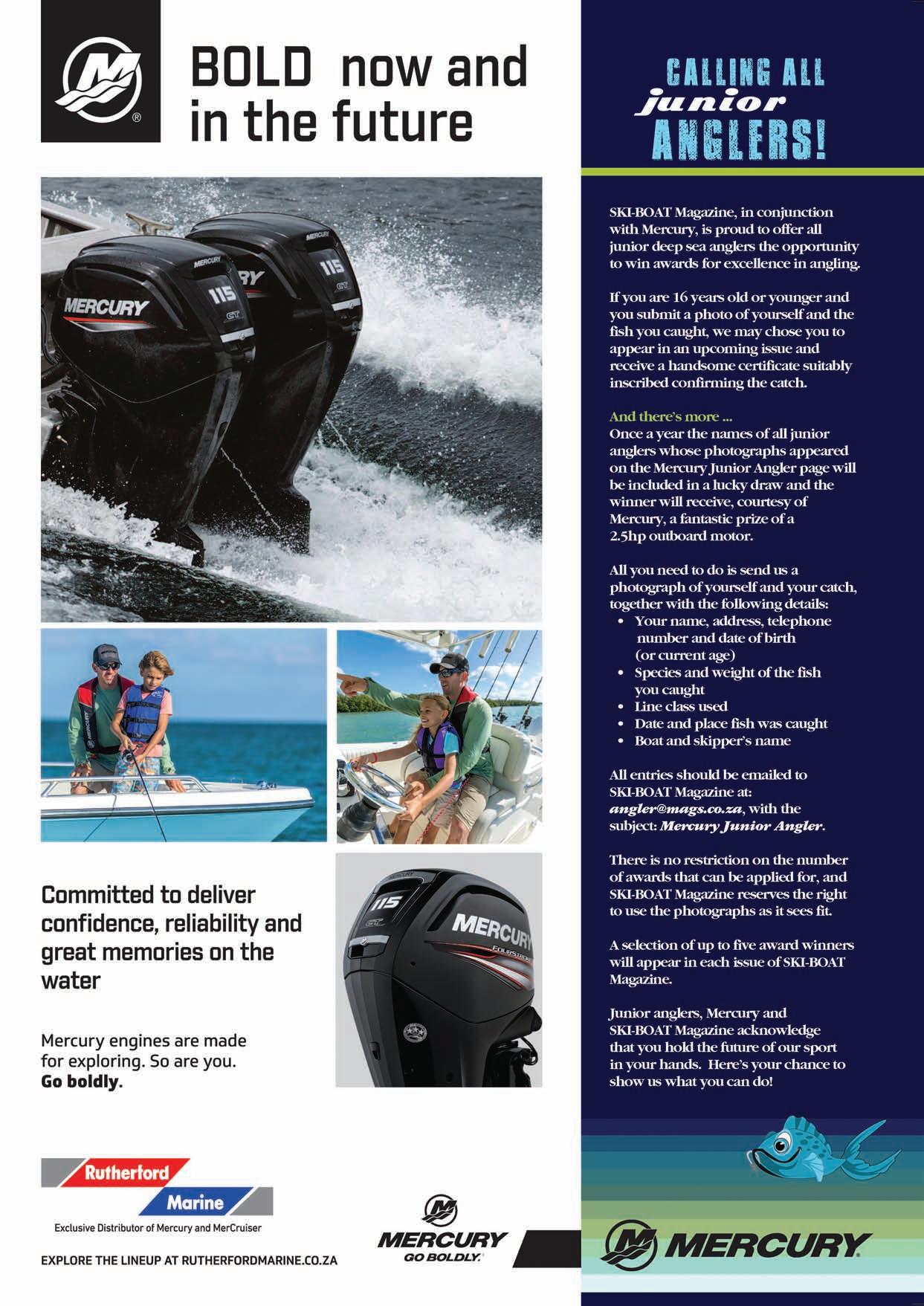
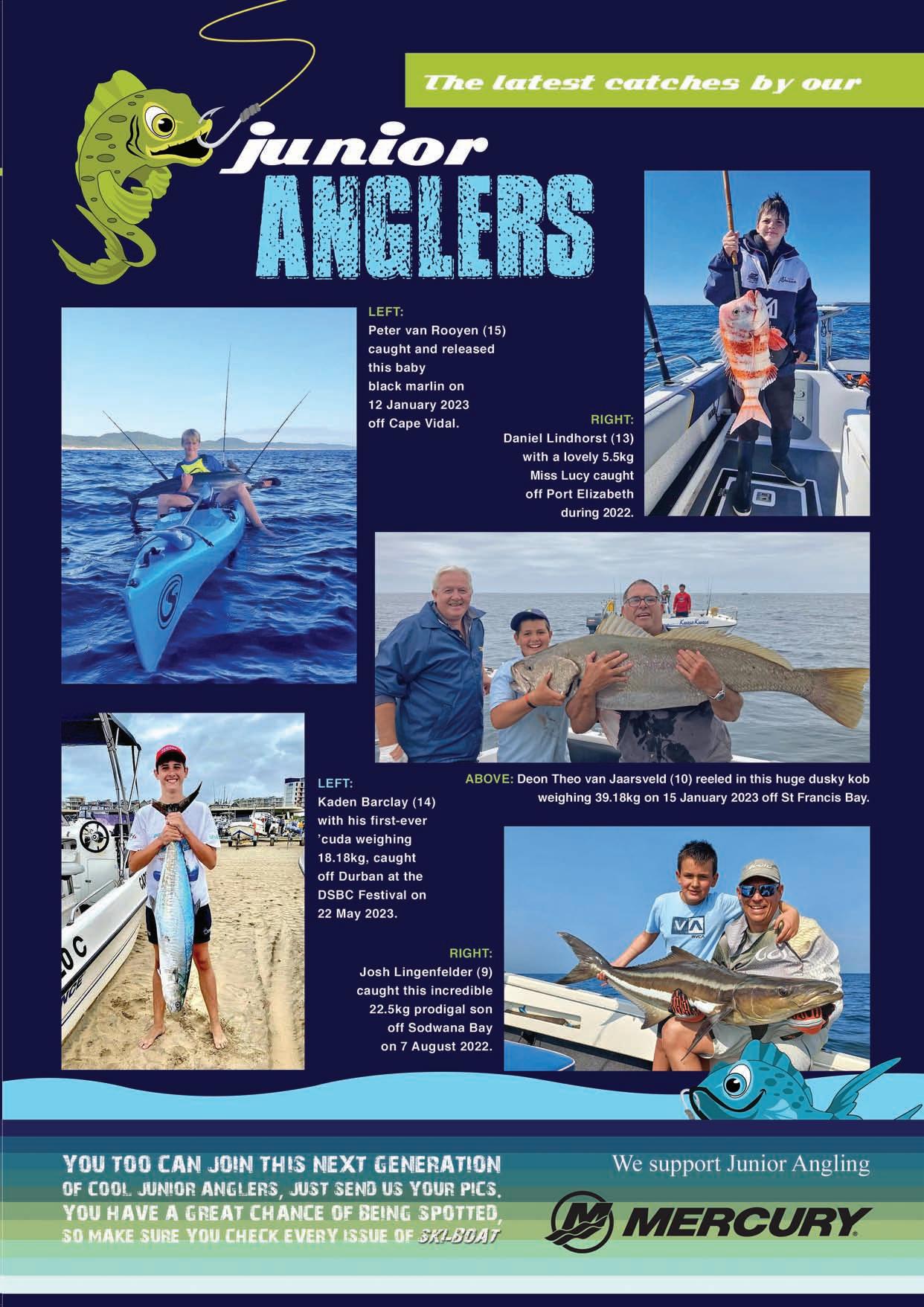
WHILE the Furuno brand needs no introduction, having been present in SA for many years,it was only in 2020 that Furuno Japan appointed Taylor Marine as the exclusive distributors of Furuno to the South African commercial fishing market.Taylor Marine initially opened an office in Green Point,Cape Town,but outgrew that space within a year and subsequently relocated to their current offices,warehouse and showroom in Northgate Business Park,just outside Cape Town Harbour.
Within a very short time,Furuno Japan realised that Taylor Marine SA (TMSA) had the experience,passion and commitment to continue the legacy and build the Furuno brand in SA.In early 2022 Furuno’s Japanese principals included the light marine (leisure marine) products into the distribution agreement.Together,these market sectors give TMSA a well-rounded product offer with a broad range of stand-alone and networked navigation and fish finding products for the serious offshore sports fishing enthusiast and commercial fisherman alike.
TMSA’s first foray into the SA leisure market was in October 2022 where they had a stand at the Boatica Cape Town Boat Show and were very well received.“Local SA dealers,keen to let their customers know that Furuno was available,quickly put their hands up to be appointed as authorised dealers,” noted TMSA’s David Maitland.
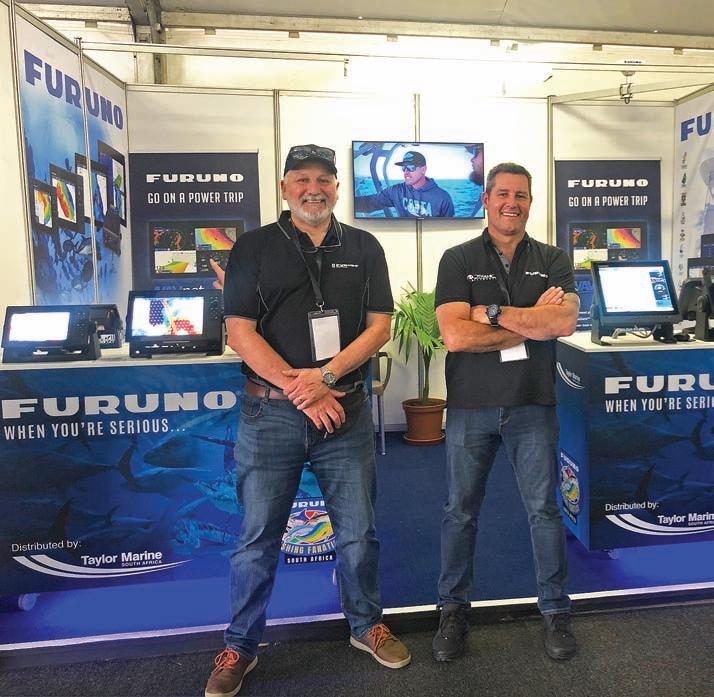
With Furuno already a household name and well respected in commercial and high-end markets,TMSA is on a mission to remind ski-boaters and serious sports anglers that Furuno is well supported,competitively priced and,most importantly,very easy to use.

“We’re fortunate that Furuno has technology that flows down from the commercial R&D budgets and finds its way packaged into leisure products and in the hands of the serious sports fishermen.Small boats … big fish!”quipped Maitland.
In addition to Furuno,TMSA is also the exclusive distributor for MaxSea TimeZero navigation software,and are stockists of Actisense,leaders in NMEA2000 devices,cables and connectors for the installation of modern day marine electronics.

62 • SKI-BOAT July/August 2023
NEWSFLASH
Adventure Tropicale . . . . . . . . . . . . .25 Ballistic Sunglasses . . . . . . . . . . . . . .39 Club Marine Insurance Comp . . . . . . .5 DSBC Festival Sponsors Thanks . . . .33 Durban Marine . . . . . . . . . . . . . . . . . .18 Fish & Go Boat Storage . . . . . . . . . . .44 Garmin . . . . . . . . . . . . . . . . . . . . . . . .20 Greenfish . . . . . . . . . . . . . . . . . . . . . .39 KZN Boat Storage . . . . . . . . . . . . . . . .39 Lands Edge . . . . . . . . . . . . . . . . . . . . .16 Lowrance . . . . . . . . . . . . . . . . . . . . . . .1 Lowrance . . . . . . . . . . . . . . . . . . . . . . .6 Maiden Voyage Industries . . . . . . . . .39 MDM — Raymarine . . . . . . . . . . . . . . .2 Mercury — Rutherford Marine . . . . .34 Mercury — Rutherford Marine . . . . .60 Mr Winch . . . . . . . . . . . . . . . . . . . . . .39 Natal Caravans & Marine . . . . . . . . . .28 Natal Caravans & Marine . . . . . . . . .IBC Natal Caravans & Marine . . . . . . . . .IFC OET . . . . . . . . . . . . . . . . . . . . . . . . . . .17 Queens of the Ocean . . . . . . . . . . . . .53 Riverside Cottages . . . . . . . . . . . . . . .44 Seaport Supply . . . . . . . . . . . . . . . . . . .8 Sodwana Tigerfish Bonanza . . . . . . .48 Solly’s Angler’s Corner . . . . . . . . . . . .6 Stubbsea Charters . . . . . . . . . . . . . . .44 Supercat . . . . . . . . . . . . . . . . . . . . . . .37 The Kingfisher . . . . . . . . . . . . . . . . . .30 Vanguard Insurance . . . . . . . . . . . .OBC ADINDEX DEADLINEFORTHE SEPTEMBER2023 ISSUEOF IS12 JULY 2023. BOOKYOURSPACENOW. CALL: 073 748 6107 <mark@mags.co.za>
FURUNOMAKESASPLASH INLEISUREMARKET
David Maitland (Managing Director of Taylor Marine, the official distributor of Furuno Marine Electronics in South Africa), and Stephen Bogusch (Managing Partner of Dynamic Elements), at the 2022 Cape Town Boat Show.

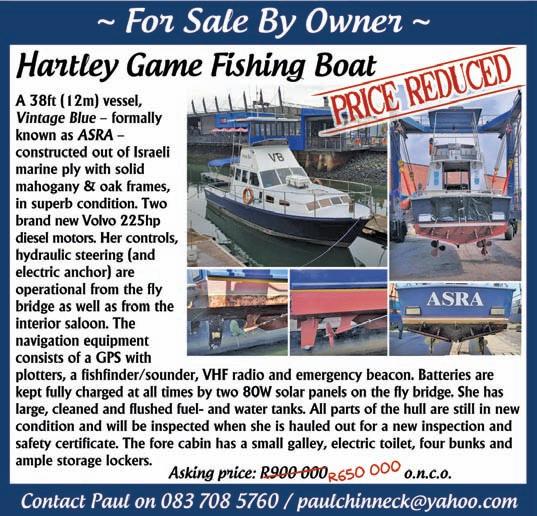
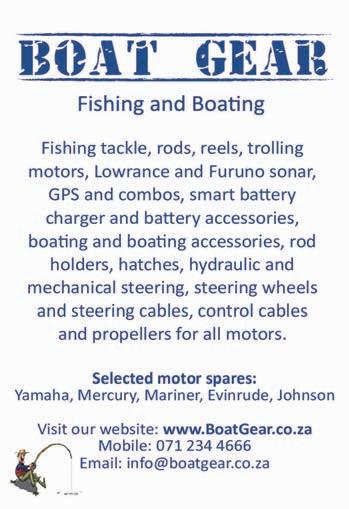
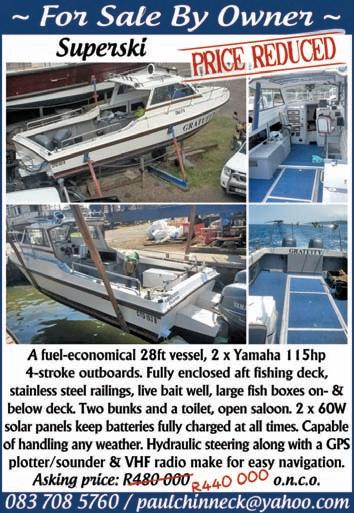


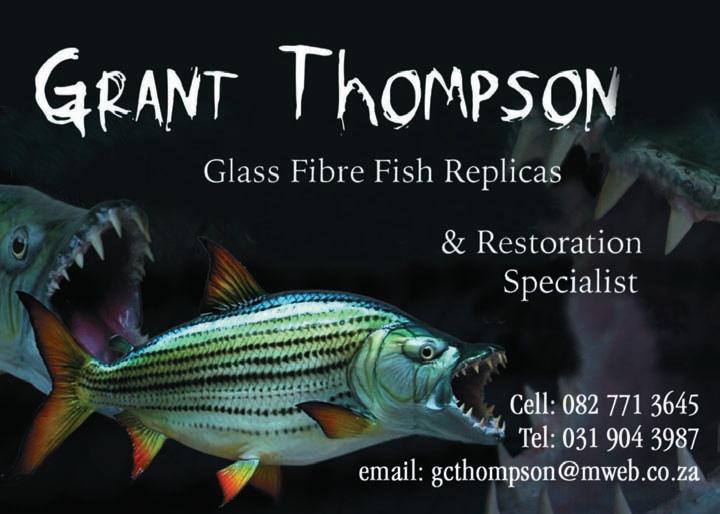
BUSINESSCLASSIFIEDS & DIRECTORY SKI-BOAT July/August 2023 • 63
Last word from the ladies
I’M NOTASKINGFOR THEWORLD
By Claire Burger
MOST men don’t understand that it’s not about “giving her the world”,but just “giving her the rod”!
I grew up with the sea pumping through my heart.My legend of a grandfather was a commercial fisherman who lived in Blythdale Beach,and my grandmother worked at the fish market when I was just a toddler.The sea re-fuels my soul and fishing makes everything worthwhile!
Early in May 2023 one of my fishing dreams came true — I went to Cape Town to try to catch one of their legendary yellowfin tuna.
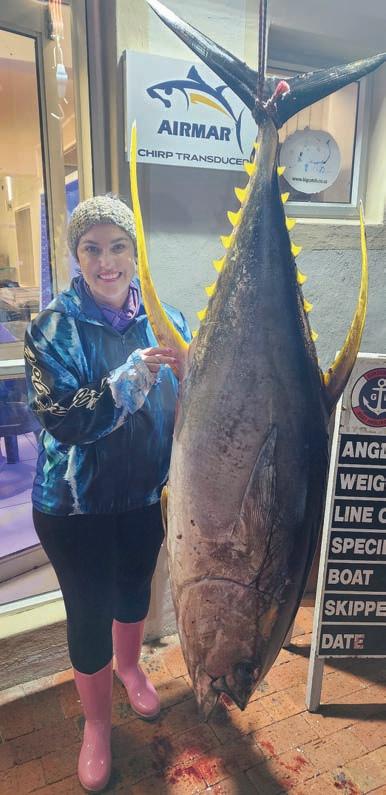
Three hours out to sea,after little sleep due to all the excitement,my Rapala Lip was beginning to droop and I started thinking of asking:“Are we there yet?”but I resisted.
My eyes followed the little boat on the GPS.We were passing Sea Point and only half way to the fishing grounds.I could see the excitement on the crew’s faces,but I wondered if we were going to find the huge tuna that the Cape is so famous for.
Eventually we slowed down and all I could see were thousands of birds in the middle of the ocean,forming waves that danced above the swells.We start to chum but saw nothing.Where were these fish? Had we just flown to Cape Town for nothing? My heart felt like it was sinking to the bottom of the ocean and my lip drooped towards the floor. What if we didn’t catch one?
Just then Michael,our skipper, received a call.He told us to up lines and hold on as we had a long way to go.It seemed like the tuna were still on!
Eventually we arrived in among other fellow fishermen.“Start chumming,they’re here!”Michael instructed.
My heart was racing as we all stood next to our rods,eagerly watching the sparkles from the scales in the chum and stripping the line slowly into the water,one metre at a time.I fed the line

between my fingers and watched it slowly straighten up — again and again. Suddenly the fishfinder lit up with torpedos under the boat — 30m then 20m from us.They were definitely there!
Again,I let down my line,slowly counting out the metres...Suddenly the line was ripped away from me! My rod started screaming and — out of pure shock and inexperience with this kind of fishing — I tightened the ratchet and stood back! My amazing crew ran around me,strapping a Black Magic harness around my waist and calling out
instructions.My dream was finally coming true.“Bring this baby home,Claire,”I told myself.
Using the swells and the boat to my advantage,I reeled in little by little, while the tuna fought back to win some line.Inch by inch,sometimes it felt like I was winning the fight,only to have the tuna pull back and make more ground than me.
I calmed myself and kept repeating “You have all day”in my head.Gradually I won back the metres of line as I caught the rhythm of the tuna,circling slowly up to the boat.
Every muscle in my body ached,but I knew I had come so far and had all the support I could ever wish for — Fransien’s face sparkled with excitement,Simone was clicking away behind the camera,Chris and Johan were stripping lines,and my husband was right beside me uttering words of encouragement when he could see the tuna giving me a hard time.I felt blessed to share these moments with my husband and amazing friends.
Michael let me know the last 15m was the final push of the fight,and he guided me through it as the tuna circled.“Pull up ...okay,let him turn ...pull his nose up.”Again and again and again. At last the leader was in,but when I look again it had been pulled out — over and over again.It was frustrating being so close to the end and yet so far.
I decide then to give everything I had left in me to the fight,and finally we saw the shimmer of the tuna circling the boat,lighting up the entire atmosphere.
After one last circle Michael gaffed the tuna.
We might have been 30 nautical miles out,but the joy on our boat echoed all the way back to the shore! The great battle was over and I had won! I stared over the edge of the boat and could not actually believe I had just caught this HUGE fish on my own.
It was 69.4kg of muscle — bigger than me — and I had landed it!
YOURCHANCETO TELLATALLTALE

64 • SKI-BOAT July/August 2023
RAPALALIP
LADIES — are you an angling widow? Are you a frustrated crew member? Do you outfish the men on the boat and have to deal with their Rapala Lips? Do you bite your lip at the comments coming from chauvinistic male anglers? Or do you just have great support from the skipper and anglers around you who want to help you catch a new PB? We’re looking for new writers for our Rapala Lip column. All contributions are gladly accepted and they will appear anonymously if necessary to protect the writers from divorce suits, cold shoulders, banishments, cut up credit cards etc. Come on ladies, share your fishing stories with us — you know you want to. Email them to <sheena@mags.co.za>.

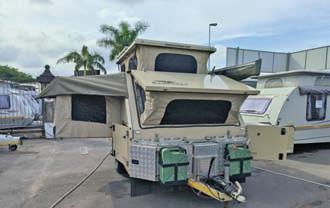
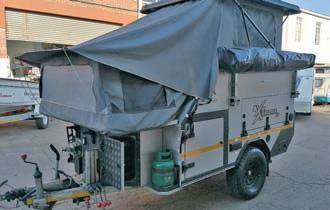
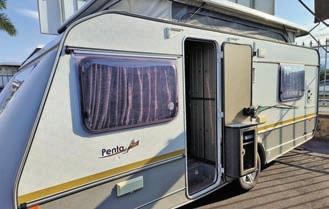
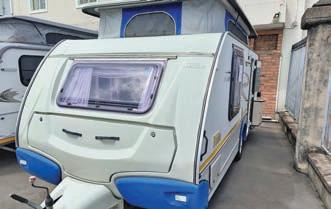

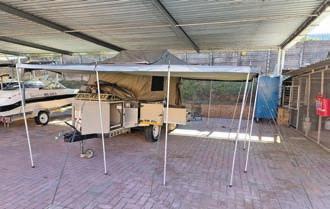
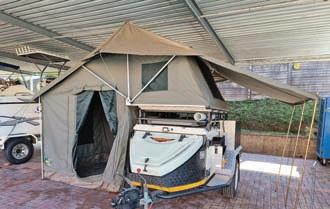

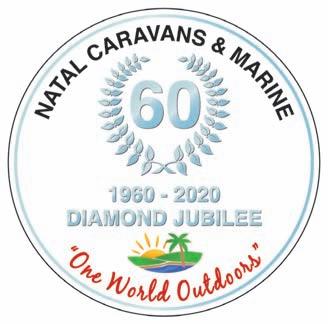
2020 Comfort Family Contact Gavin Kiloh +27 31 702 7291 info@natalcaravans.co.za www.natalcaravans.co.za 1 Wareing Road, Pinetown price 2018 Baobab 3 2018 XT Trooper 2016 Penta price 2015 Splash 2012 Jurgens Expo 2012 Summit Everest 2010 Jurgens XT 140 price price price price price price R 379 950 R 430 000 R 236 950 R 285 950 R 195 950 R 155 950 R 125 950 R 99 950 Demo & Preowned Luxury by natal caravans & marine
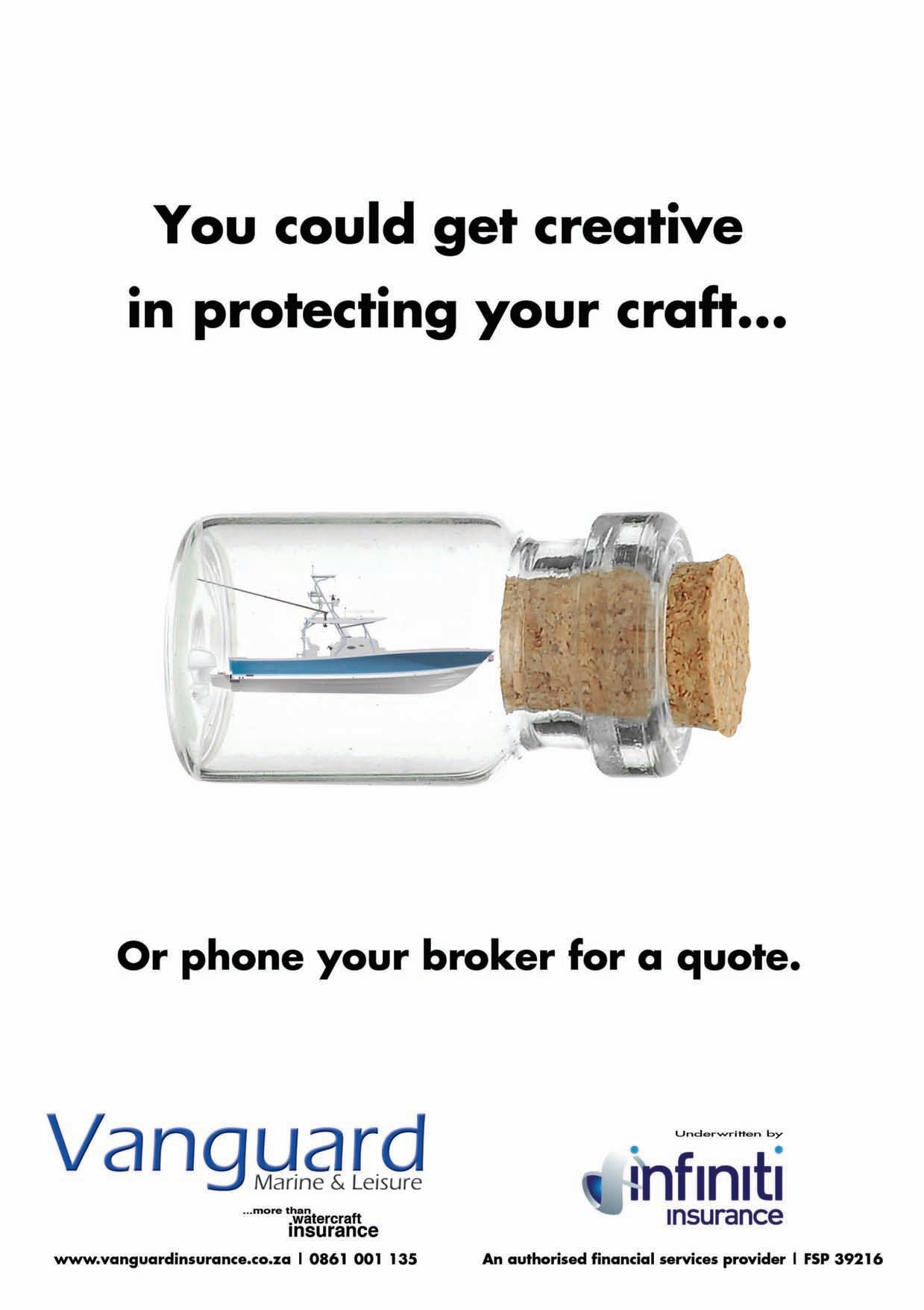

























































 Jan Westdyk, Jaco Louw, Ryan Nienaber, David Zaymes, Andrew Nienaber and Ryno Robinson with their 132kg big eye tuna.
Ryan (above) and Jan (below) with two of the longfin tuna caught on 19 May 2023.
Jan Westdyk, Jaco Louw, Ryan Nienaber, David Zaymes, Andrew Nienaber and Ryno Robinson with their 132kg big eye tuna.
Ryan (above) and Jan (below) with two of the longfin tuna caught on 19 May 2023.






































































































